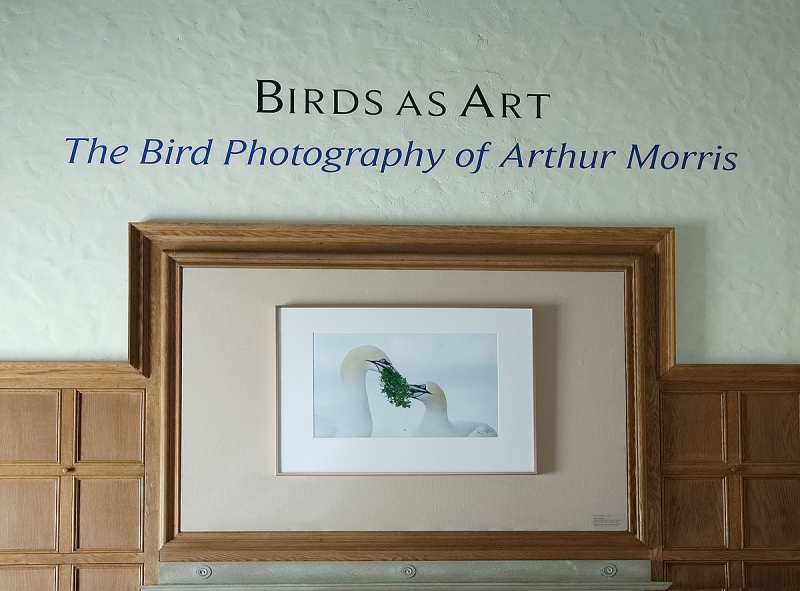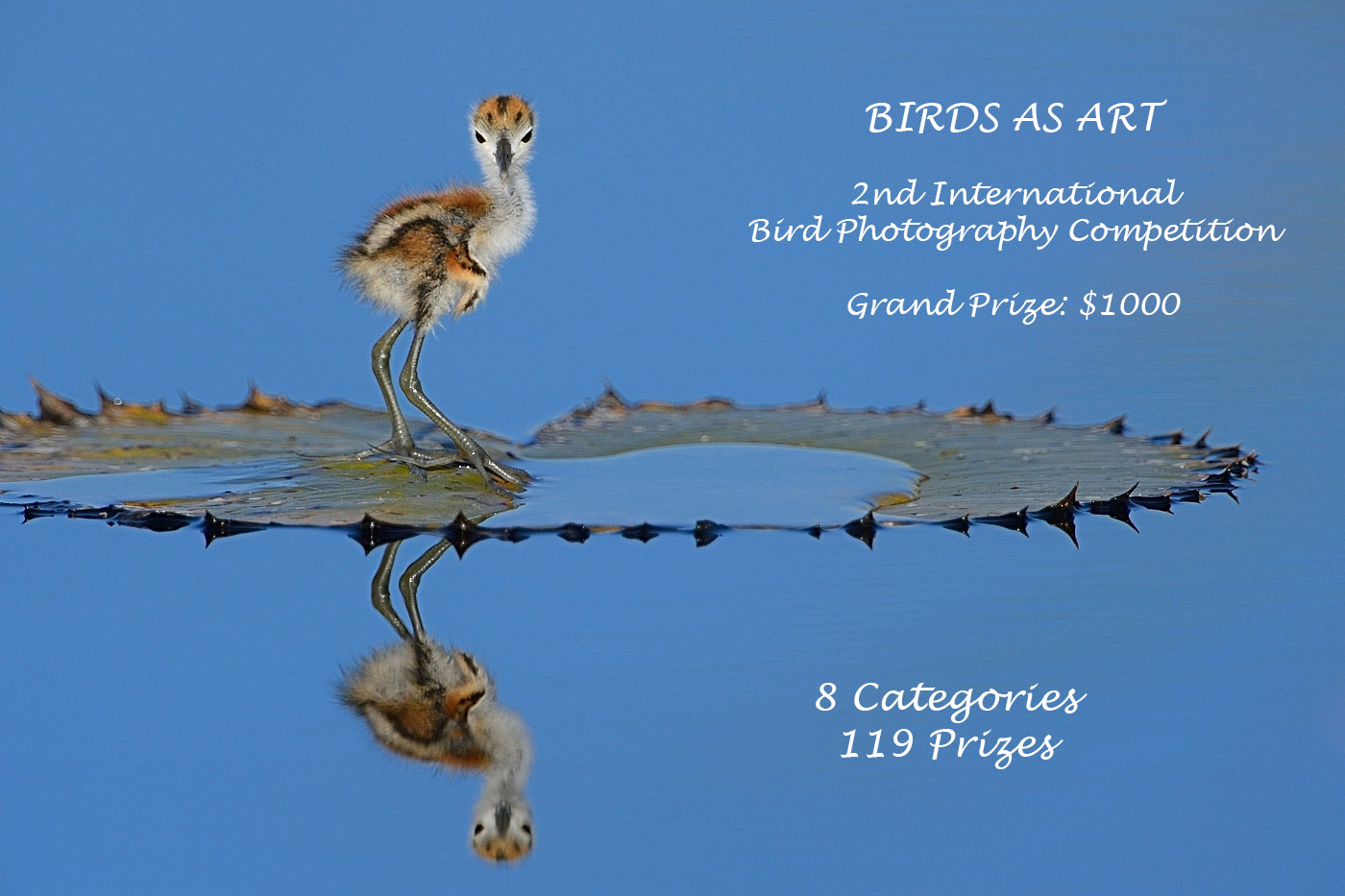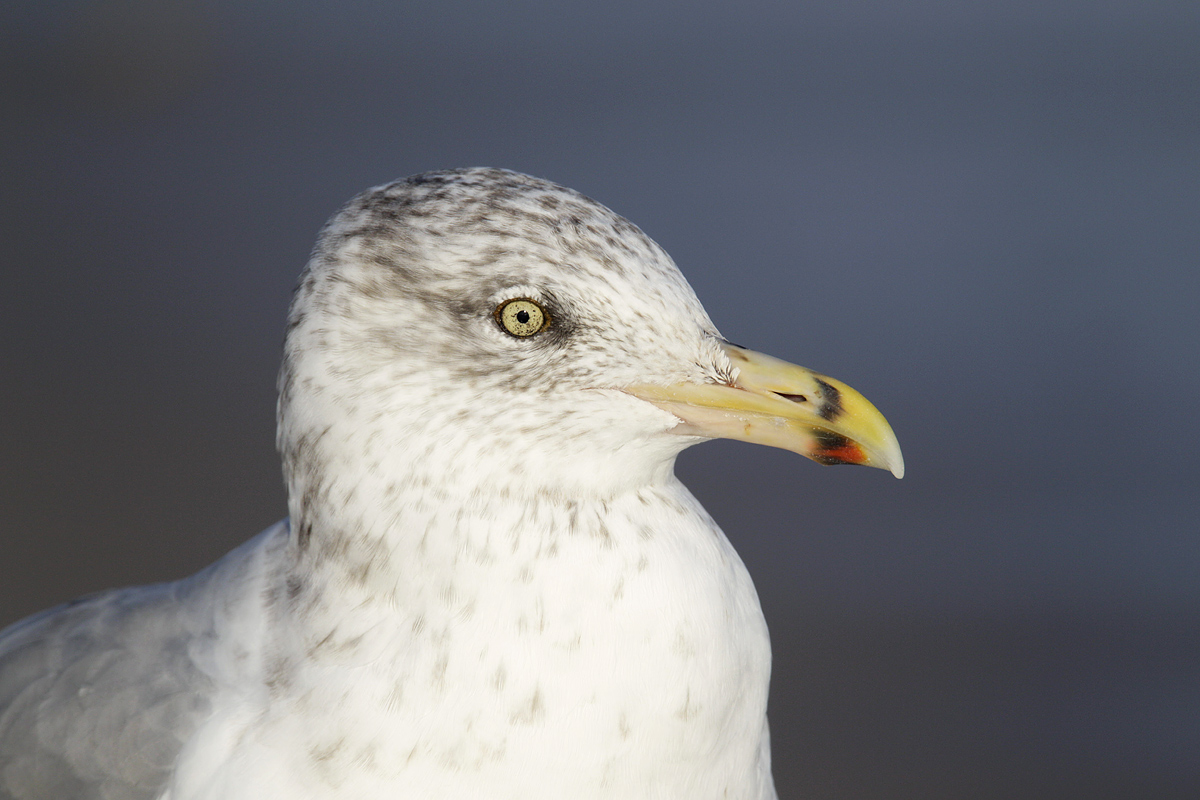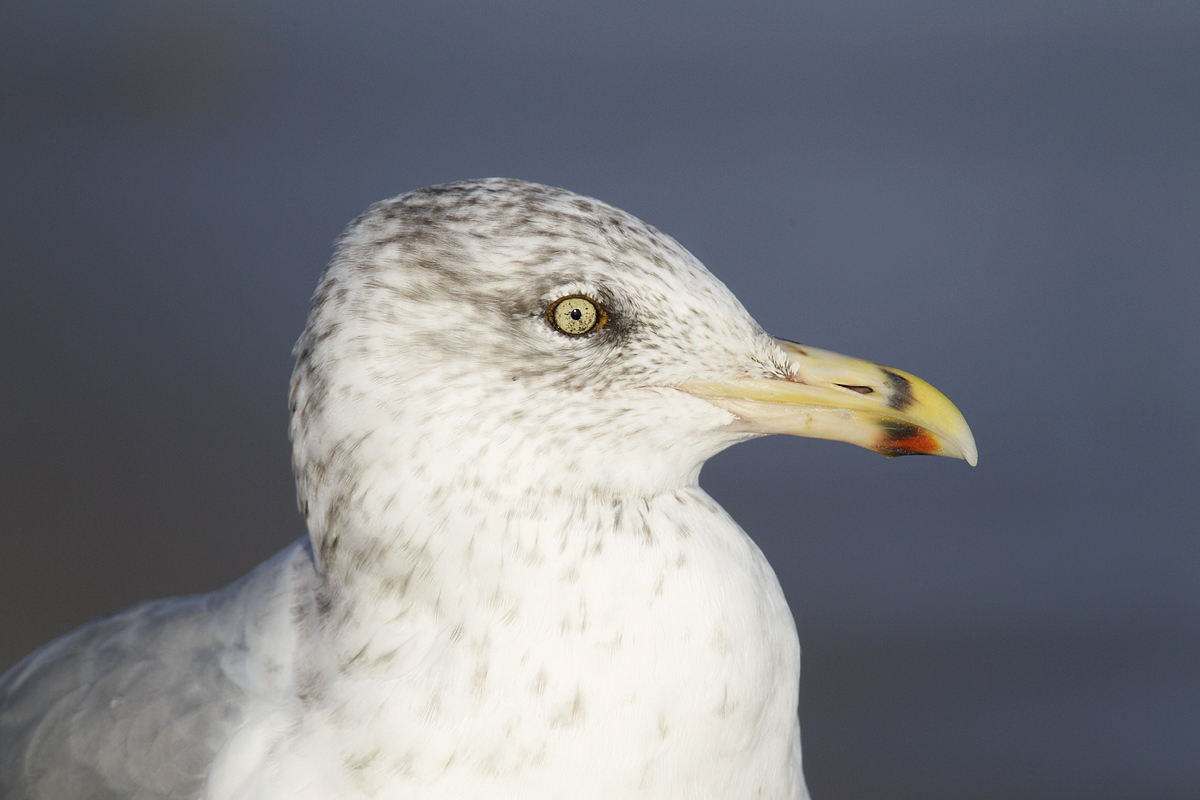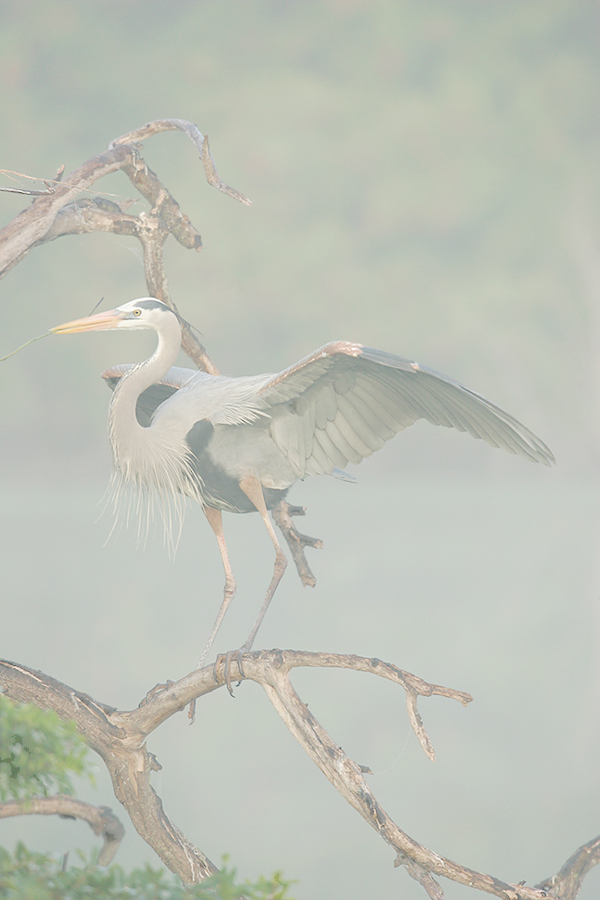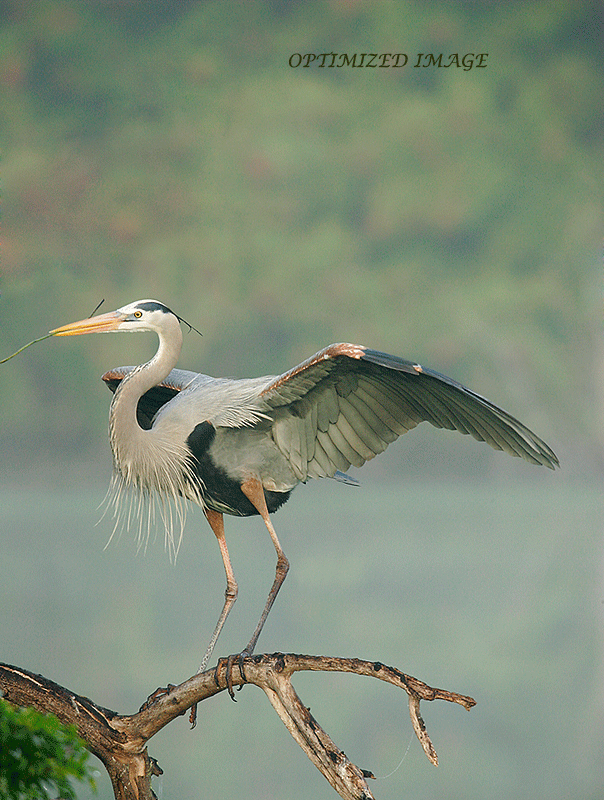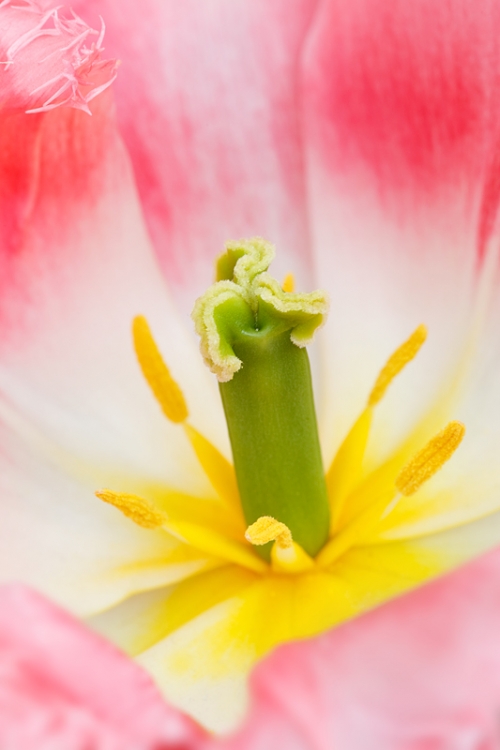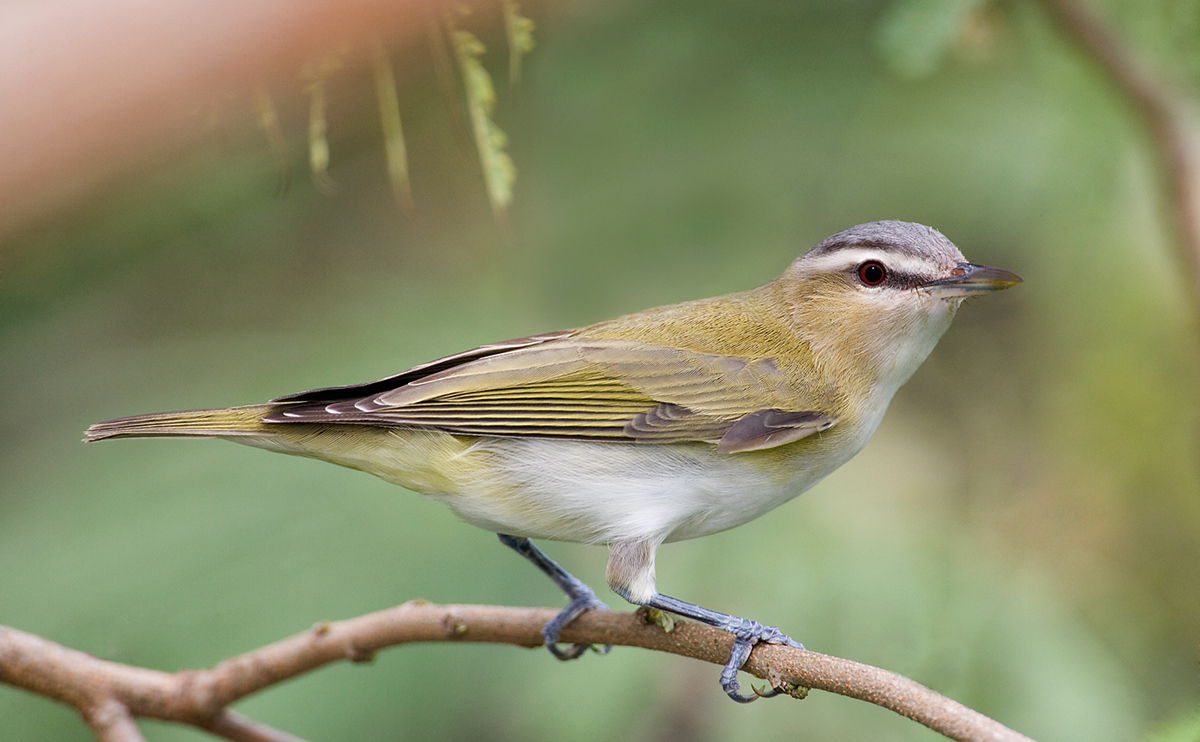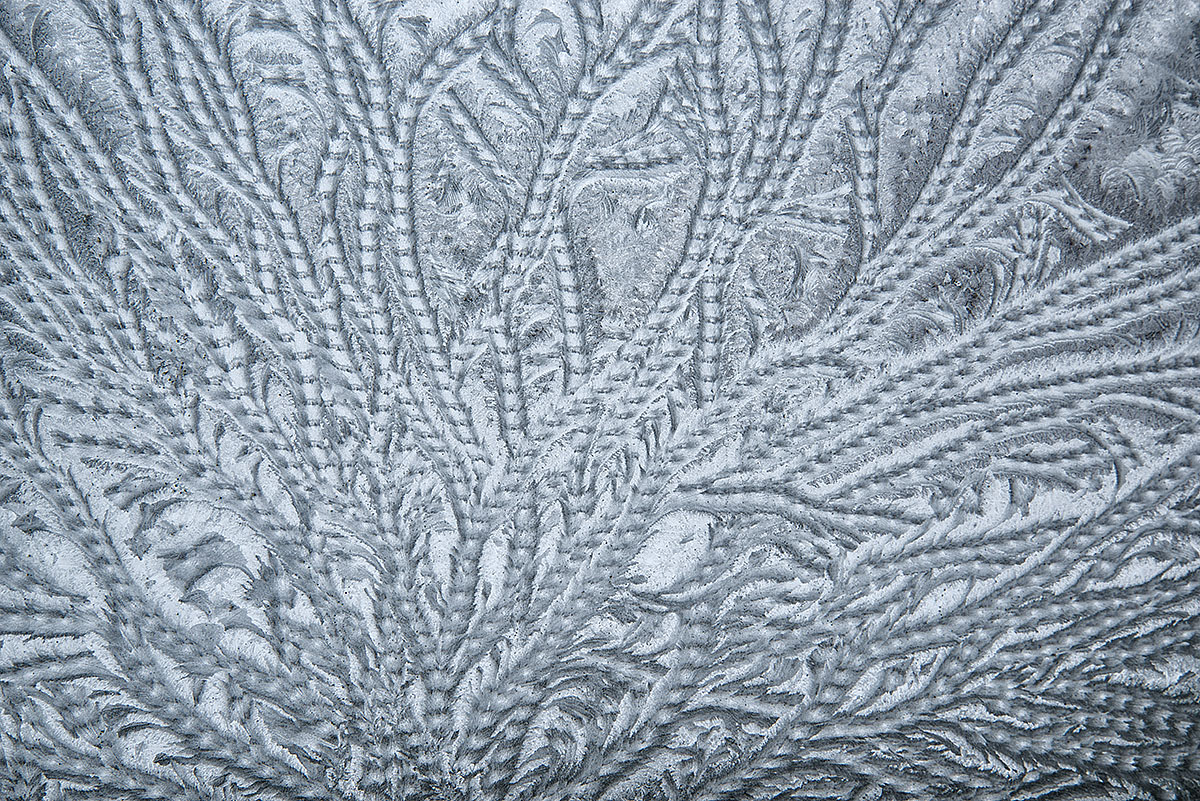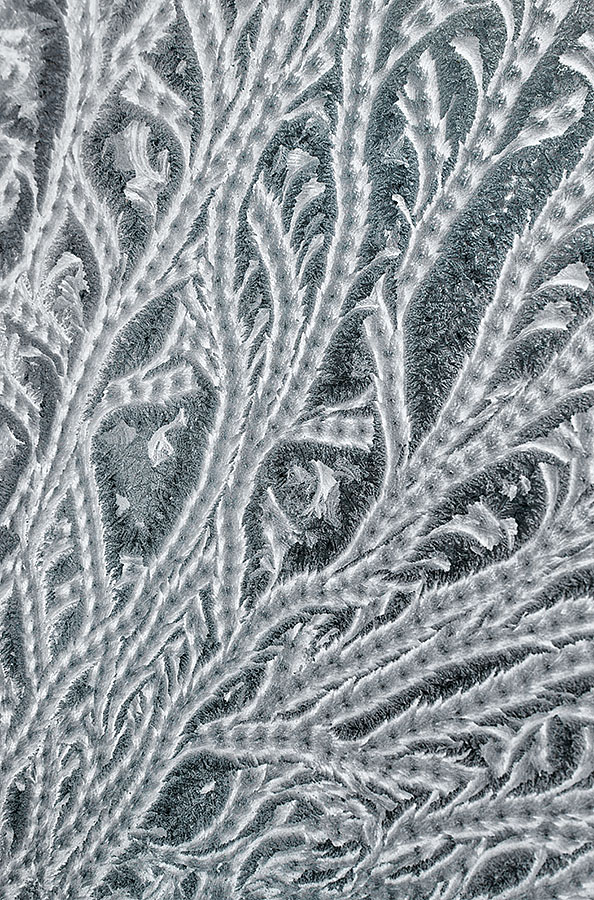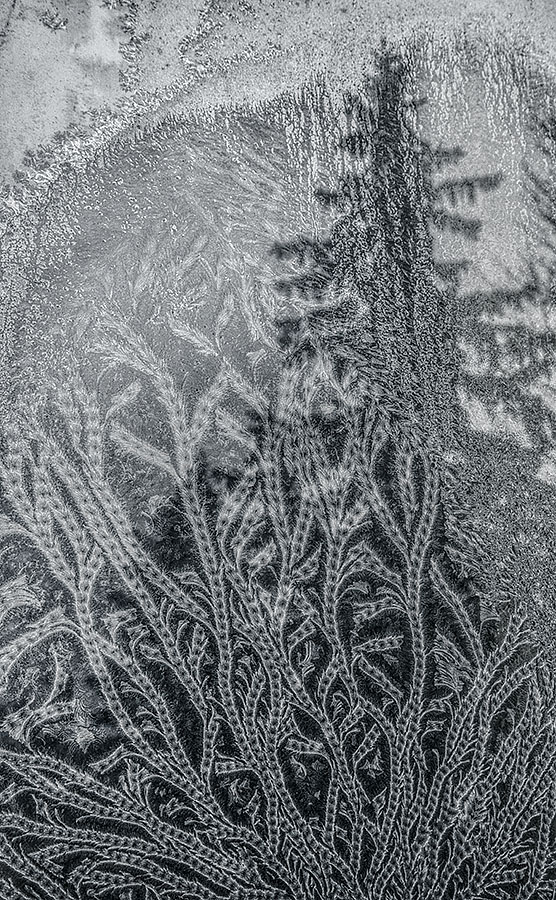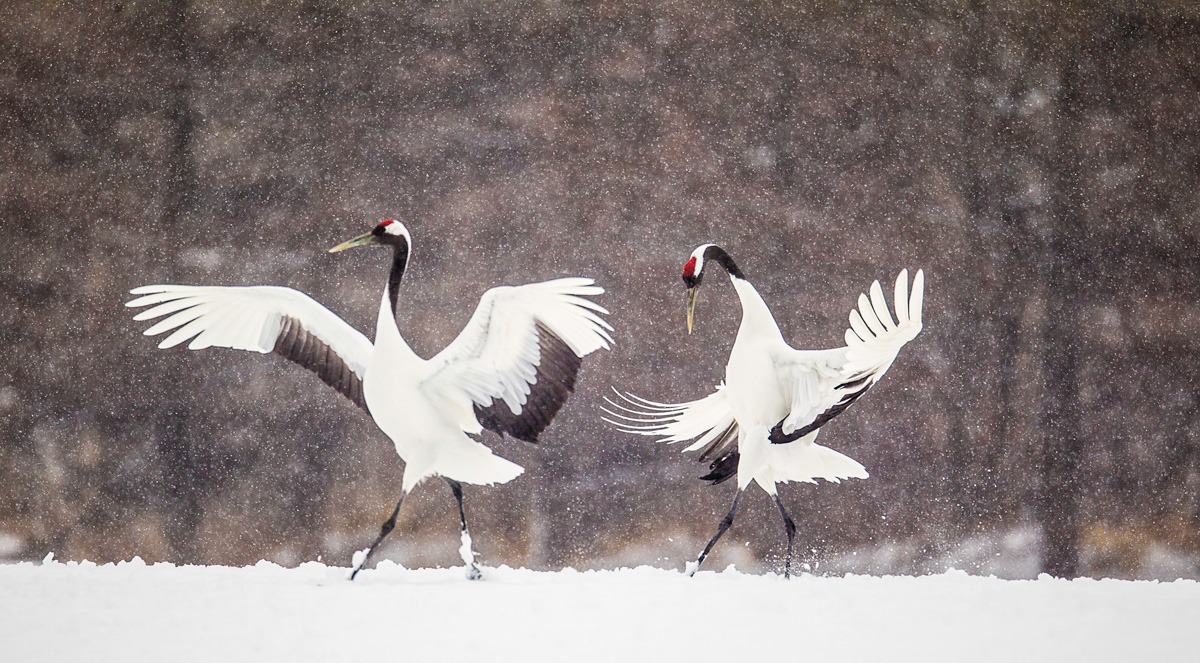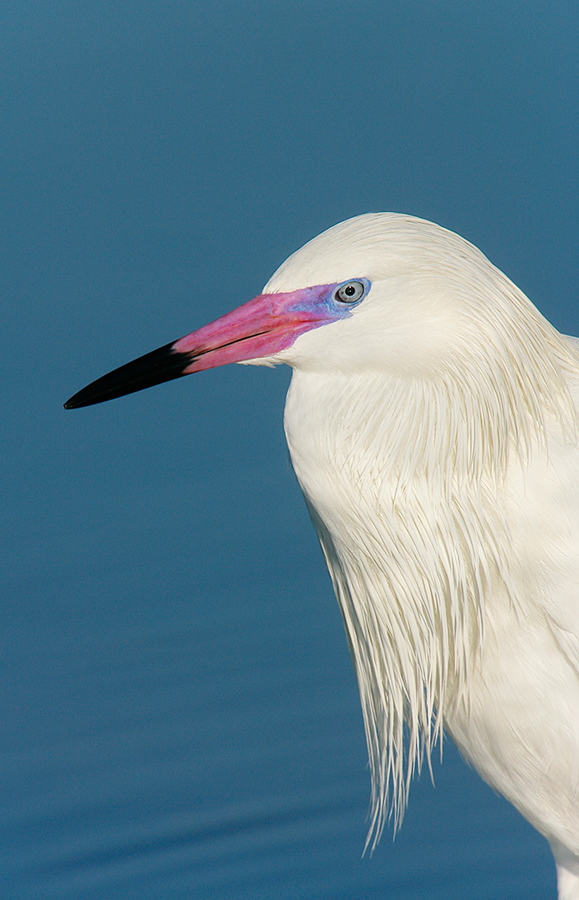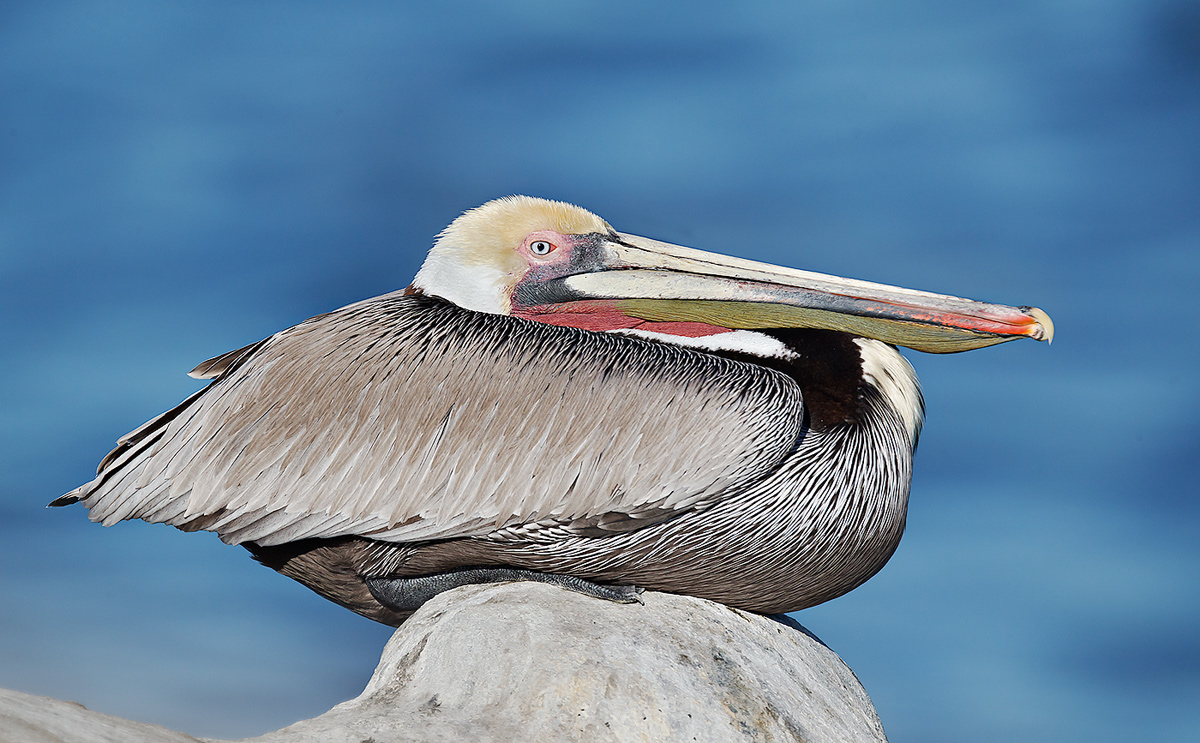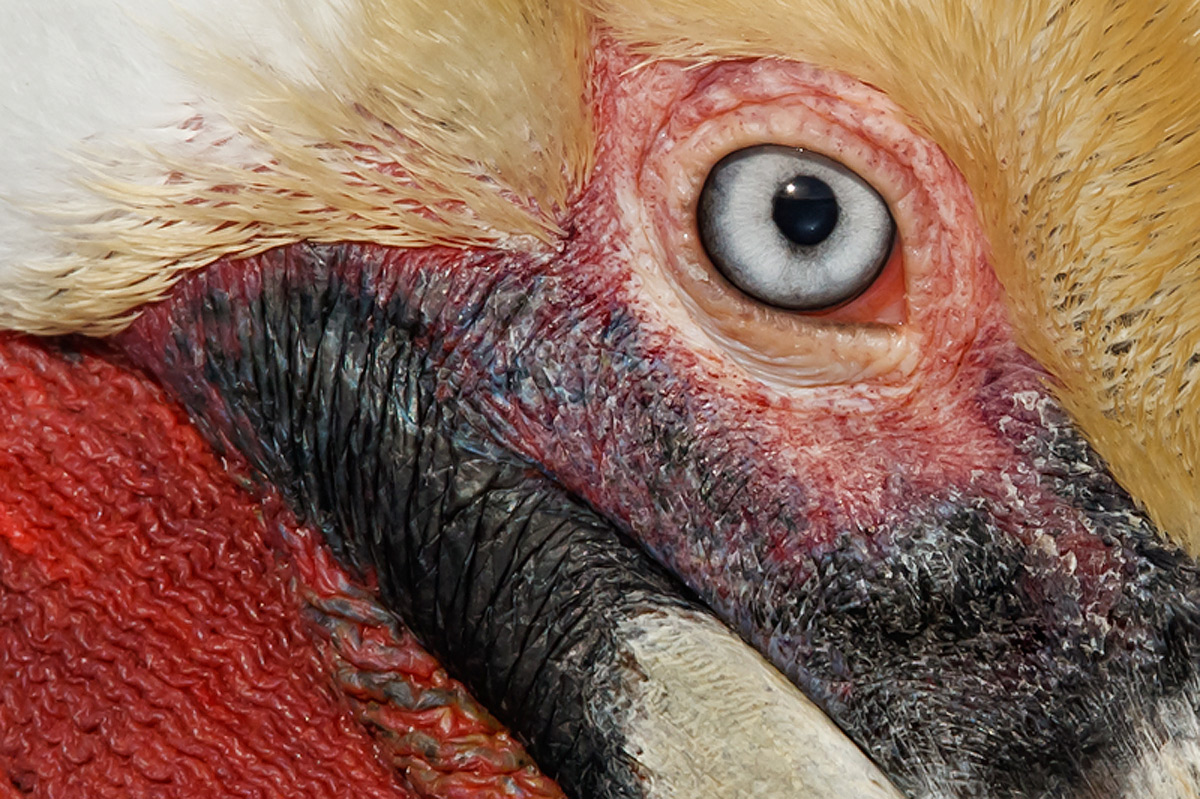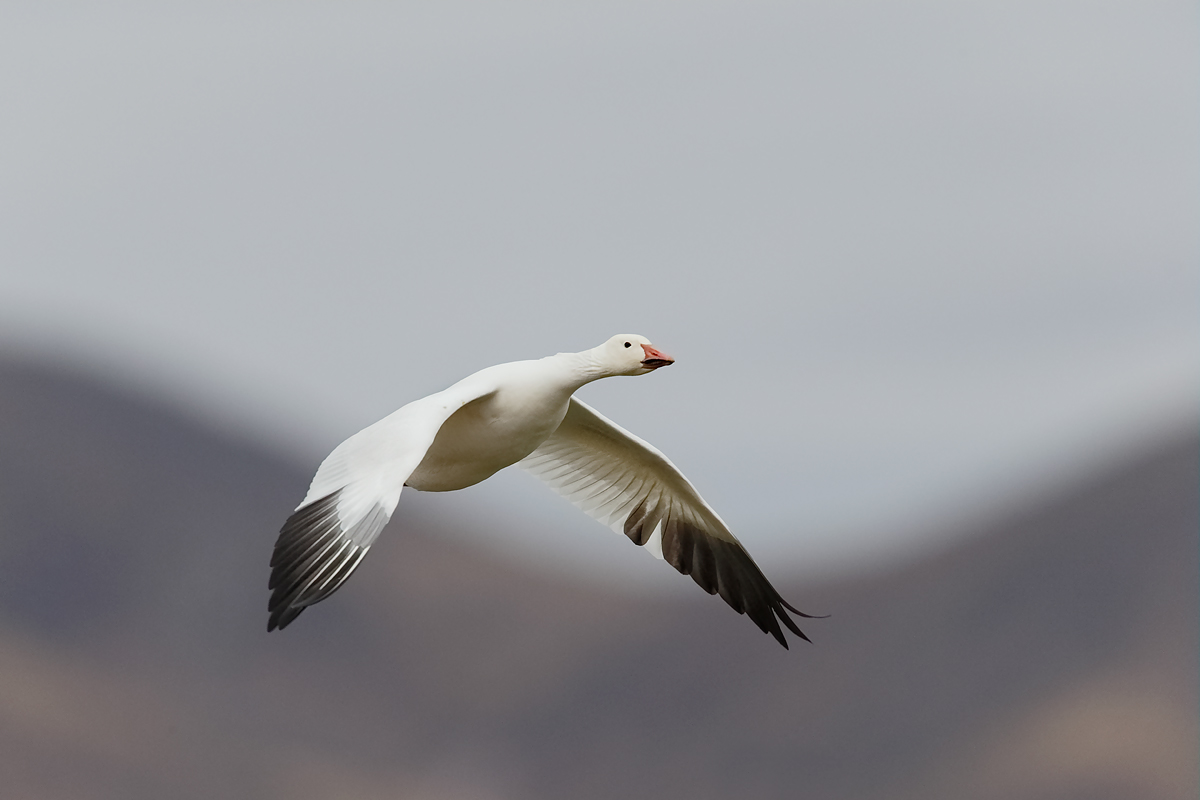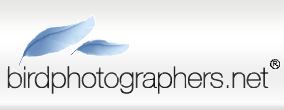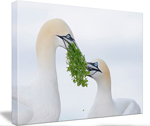December 31st, 2013
An e-Mail From Tammis
On November 19, 2103 I received a very nice e-mail from Tammis Coffin, the Education Coordinator at the Museum of American Bird Art at Mass Audubon/Connecting People & Nature through Art:
Artie,
I’m forwarding a feature about the Museum of American Bird Art that highlights your exhibition.
Visitors have responded enthusiastically to your work and it’s drawn in a lot of new faces. They express delight with your captions, your colors, the beauty, as well as the whimsy. We are fortunate to have your images here and to have learned from you over the course of your visit of several days. I want to thank you for your ideas for gallery activities. There have been some amazing child drawings of your egret, spoonbill, puffin, and many more, although few children have tackled the gannets.
I signed up for your blog and have been enjoying it immensely!
Because you mentioned the quality of Arni Cheatham’s work (Arni was one of the students in your seminar), we learned more about him and discovered that he won this year’s Boston’s Jazz Hero award. He’ll be projecting his bird images here in late April, while his jazz band improvises.
My best to you and to the wonderful Denise for the New Year!
Tammis
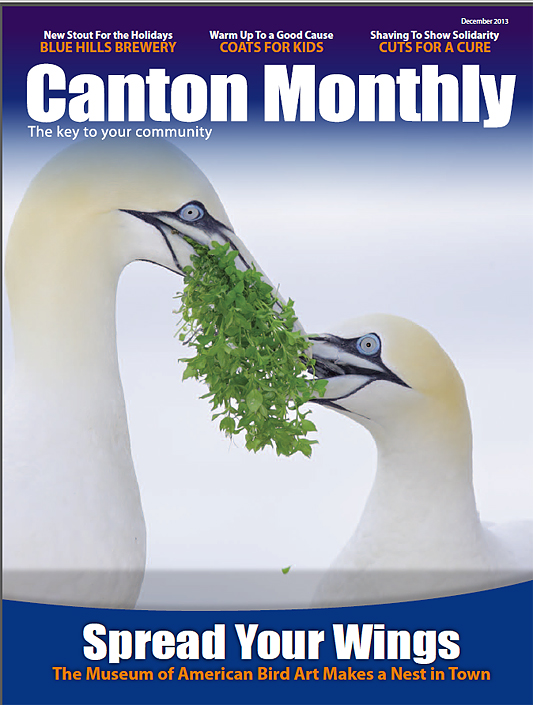
|
|
The Canton Monthly is a community magazine published by hibu Limited.
|
The Canton Monthly Feature Article
Below is the text of the feature article that appeared in the December 2013 issue of Canton Monthly.
Spread Your Wings
Museum of American Bird Art Makes a Nest in Canton
BIRDS AS ART
“Today, we continue to connect people to nature through art, using art to inspire and educate,” director Amy Montague said. The museum presents three to four exhibitions each year, with a wide range of artworks represented. An array of educational programs for all ages draws on the original art in the exhibitions and collections, as well as the varied habitats of the wildlife sanctuary. The museum’s current exhibition, “BIRDS AS ART,” is on display through Jan. 13, 2014.
The exhibition displays the bird photography of Arthur Morris, one of the world’s most renowned bird photographers. Museum visitors can stroll among the colorful, detailed and often whimsical images in the gallery. Arthur Morris has unparalleled technical and artistic expertise and design savvy; and he experiments widely. His photographs of birds call for patience, determination, luck and an understanding of bird behavior. Morris has won numerous national and international awards and is a Canon Explorer of Light Emeritus. Canon generously sponsored the exhibit. He leads instructional bird photography trips, writes an educational blog, and has also published several books including “The Art of Bird Photography” and an e-Book: “The Art of Bird Photography II.”
Visitors will see an Atlantic puffin peering straight towards the camera with tufts of grass in its orange beak, baby sandhill cranes hitching a ride on their mother’s back and “Blizzard in Blue,” a photograph that reveals hundreds of snow geese taking flight. “Gannets in Love” is the signature image for the show, and highlights the graceful curving profiles of a pair of seabirds passing a bright green piece of seaweed beak-to-beak.
“When I looked around for the best photographer to inaugurate the museum’s new name, only one person was mentioned time and time again: Arthur Morris,” Montague said. The current exhibit can be viewed every afternoon of the week, except Mondays, until Jan. 13. For more information, visit massaudubon.org/maba or call 781-821-8853.
Exhibition, American Museum of Bird Art at Mass Audubon, Canton, MA
BIRDS AS ART/The Bird Photography of Arthur Morris
The 35-print exhibition will run through Sunday, January 12, 2014. If you have not visited yet, you still have two weeks to get there! The images hang at the American Museum of Bird Art at Mass Audubon (193 Washington Street, Canton, MA 02021. 1-781-821-8853.) The exhibition was sponsored in part by Canon USA/Explorers of Light and is open Tuesday through Sunday, 1 p.m. – 5 p.m. Click here for additional details. Learn more about the exhibit by clicking here.
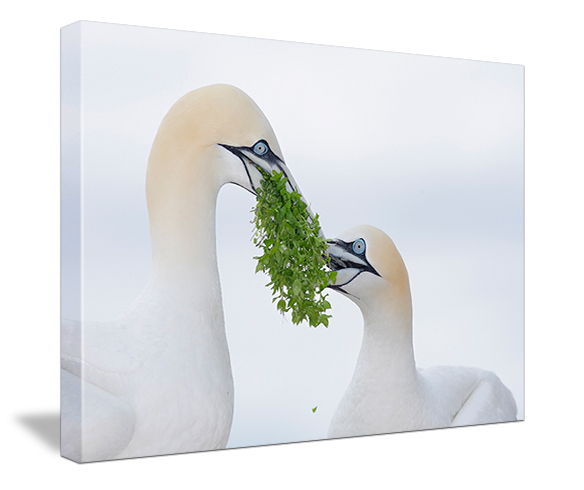
|
|
Digitally-signed Fine Art Canvas prints of “Gannets in Love” are available in various sizes. Each print is skillfully produced by Canvas In Demand. Click here for sizes, pricing, and framing and additional information.
|
Fine Art Traditional Photographic Prints
All BIRDS AS ART images, both film and digital, are available as signed traditional photographic prints in a great variety of sizes. You may purchase an unframed print of any BAA image that you see on the web site, in a Bulletin, or on the Blog. Click here for sizes, pricing, and additional information.
Fine Art Digitally-Signed Canvas Prints
All BIRDS AS ART digital and some film-based images are available as digitally signed Fine Art Canvas Prints skillfully prepared by Canvas on Demand. Click here for sizes, pricing, and framing and additional information.
IPT Info
Many of our great trips are filling up. You will learn more about how to make great images on a BAA IPT than anywhere else on the planet. Click here for info on the Anhinga Trail IPT. Click here for info on the Estero Lagoon IPT. Click here for info on the just announced San Diego Short Notice IPT–only 1 slot left on that one. And click here to learn about the just-announced 2014 Bosque IPTs. You will find additional IPTs and general info here.
Support the BAA Blog. Support the BAA Bulletins: Shop B&H here!
We want and need to keep providing you with the latest free information, photography and Photoshop lessons, and all manner of related information. Show your appreciation by making your purchases immediately after clicking on any of our B&H or Amazon Affiliate links in this blog post. Remember, B&H ain’t just photography!




Amazon
Everyone buys something from Amazon, be it a big lens or deodorant. Support the blog by starting your search by clicking on the logo-link below. No purchase is too small to be appreciated; they all add up. Why make it a habit? Because I make it a habit of bringing you new images and information on an almost daily basis.
Typos
In all blog posts and Bulletins feel free to e-mail or leave a comment regarding any typos, wrong words, misspellings, omissions, or grammatical errors. Just be right. 🙂
December 30th, 2013
Last Year’s Grand Prize winning image by Lou Coetzer
Contest Deadlines Extended!
BIRDS AS ART 2nd International Bird Photography Competition
New Entry Deadline: January 31, 2014; see additional details below
Big News
With so many folks signing up at the last minute and with so many folks having trouble uploading their images due to server overload the deadline for entering the contest (registering and paying) has been extended until January 31, 2014 and the deadline for uploading images has been extended until midnight Eastern time on February 10, 2014. Take advantage of this extension to have a crack at the great prizes.
Learn more and enter the BIRDS AS ART 2nd International Bird Photography Competition here. Twenty-five great prizes including the $1000 Grand Prize and intense competition. Bring your best.
Register and Pay
To register click here.
To learn of payment options, click here.
|
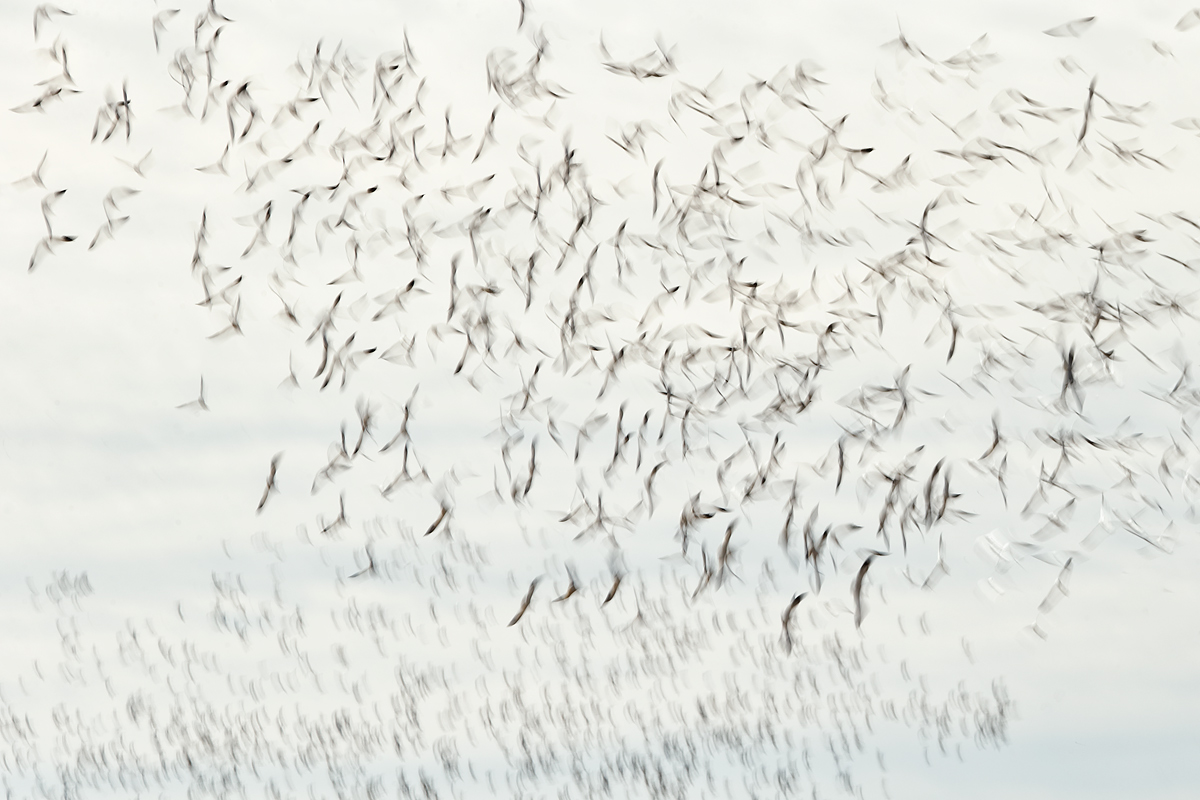
|
Version III
Please click on the image to see a larger version.
|
Assorted Educational Follow-ups
Snow Goose Image Optimization/Need Your Help/Opinion
In the Snow Goose Image Optimization/Need Your Help/Opinion post I asked: Why do I wish that I had panned the camera up and left a bit more?
The flock was really zooming, flying erratically, so I had trouble panning with them. Had I pointed the camera up and left a bit more I would have gotten some empty space in front of the flock.
I like the tighter crops in Versions I and III better than the wider crop in Version II because it puts more emphasis on the really cool looking birds. In Version I I did not like the upper right corner as I felt that I had overdone the Tonal Contrast; that area looked to bright and a bit splotchy. My favorite was Version III (above) where I toned down the contrast a bit (on its own layer) and then painted out the upper left corner on a Regular Layer Mask. I may try a fourth version that is punched up a bit more.
There are two lessons here:
1-It pays to make and compare several versions of the same image.
2-If you like more than one version it is fine to save several of them.
Lastly, I have responded to each comment on this post.
The #1 Reason that it is Mandatory, Imperative, and Vitally Important that you Work in Manual Mode for Flight Photography
In The #1 Reason that it is Mandatory, Imperative, and Vitally Important that you Work in Manual Mode for Flight Photography post I asked:
#1: If I had been using the 5D Mark III for this image what would I have had to have done differently?
Answer: with the 5D III being a full frame camera and the 7D being a 1.6 crop factor camera I would have had to zoom in to create the same framing.
#2: Why did I selectively apply a 100% layer of NIK Detail Extractor and a small Linear Burn to this image?
Answer: to tone down and restore detail to the brightest whites in the the breaking wave and on the pelican’s head. Note: in soft light even with the WHITEs having no RGB values over 235 after conversion the whites may appear relatively detail-less. Such images are not over-exposed.
I have responded to each comment on this post.
|
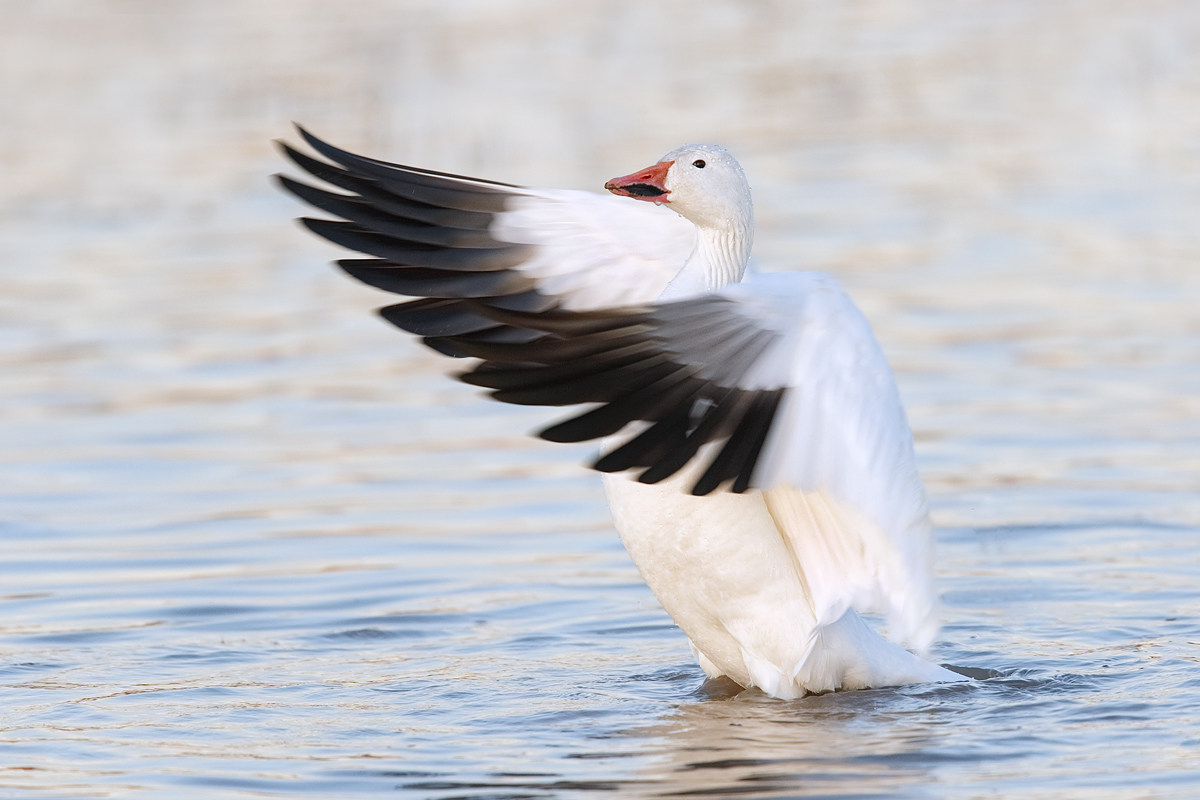
|
|
I know where to make images like this on most mornings. Do you? The 2014 Bosque Quick Start Guide/Current Conditions Update tells you exactly where and when to be…. On most but not all mornings of course. And if the situation is not there, you will be in the right place anyway!
Image #1: Snow Goose Flapping After Bath
|
2014 Bosque Secrets Revealed
In 2014 Bosque Secrets Revealed my favorite image was Image #1: Snow Goose Flapping After Bath (above).
The bird in Image #4 is a winter or basic plumage Greater Yellowlegs, most likely an adult.
I have responded to each comment on this post.
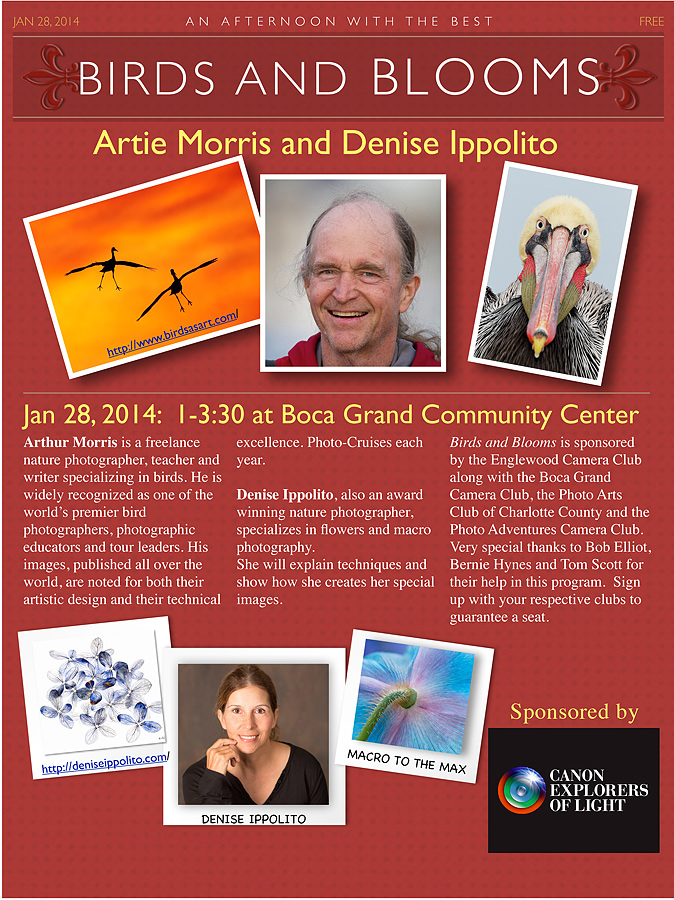
|
|
This afternoon seminar is 100% free and open to the public.
|
Free Afternoon Seminar
Join Denise Ippolito and me on the afternoon of January 28, 2014 at 1:00pm in the Boca Grande Community Center for a free two-part nature photography seminar entitled “Birds and Blooms.” At 1:00pm I will be presenting “A Bird Photographer’s Story” (updated with lots of my favorite new images). Denise will follow with her hugely popular “Bloomin’ Ideas.” The venue is located at 131 First Street West, Boca Grande, FL 33921.
Suggestion
Join us for the free seminar and then for the Venice Rookery IPT the following day.
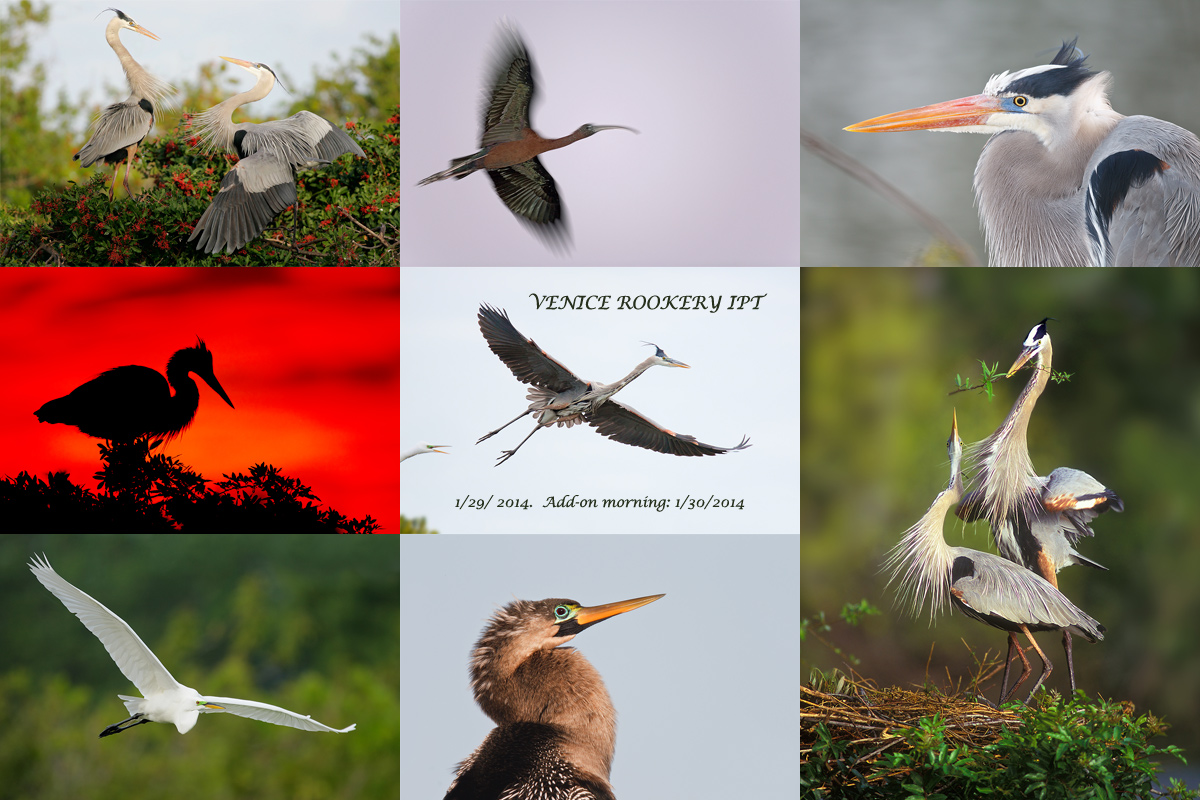
|
|
Do join us on the Venice Rookery IPT, or better yet, for the whole South Florida Composite IPT. Scroll down or click here for complete details.
|
The 2014 South Florida Mini-IPTs
Because of our intense travel schedule that includes a trip to Japan I will not be running the traditional SW FLA IPT. In addition, in an effort to give some folks a chance to get a taste of our teaching and our passion for bird photography, Denise Ippolito and I have organized a series of short IPTs that may be combined into one wonderful experience or enjoyed piecemeal.
Jan 29 (WED): Venice Rookery In-the-Field: all day: (Limit 14/Openings 10): $399. Introductory slide program 7pm, Jan 28.
30 (THURS) -Venice am only. (Limit 14/Openings 10):: $249
You can sign up for one or more of the short IPTs and/or one or more of the add-on days or you can opt to sign up for the all the sessions. Those signing up for the whole shebang will be having all lunches and dinners with us most every day.
A $500 non-refundable deposit is required to hold your slot for this IPT. For the short segments that are less than $500 payment in full is due at the time of registration. Your balance is due 4 months before the date of the IPT and is also non-refundable. If the trip fills, we will be glad to apply a credit applicable to a future IPT for the full amount less a $100 processing fee. If we do not receive your check for the balance on or before the due date we will try to fill your spot from the waiting list. If your spot is filled, you will lose your deposit. If not, you can secure your spot by paying your balance. Best to call Jim or Jennifer with a credit card in hand to register. Credit cards are not accepted for balances. Alternatively you can send a check for $500 made out to Arthur Morris to us at PO Box 7245, Indian Lake Estates, FL, 33855. Please include a note with your e-mail address and be sure to let us know what you are signing up for.
Only a Few Hours Left for Free Shipping


IPT Info
Many of our great trips are filling up. You will learn more about how to make great images on a BAA IPT than anywhere else on the planet. Click here for info on the Anhinga Trail IPT. Click here for info on the Estero Lagoon IPT. Click here for info on the just announced San Diego Short Notice IPT–only 1 slot left on that one. And click here to learn about the just-announced 2014 Bosque IPTs. You will find additional IPTs and general info here.
Support the BAA Blog. Support the BAA Bulletins: Shop B&H here!
We want and need to keep providing you with the latest free information, photography and Photoshop lessons, and all manner of related information. Show your appreciation by making your purchases immediately after clicking on any of our B&H or Amazon Affiliate links in this blog post. Remember, B&H ain’t just photography!




Amazon
Everyone buys something from Amazon, be it a big lens or deodorant. Support the blog by starting your search by clicking on the logo-link below. No purchase is too small to be appreciated; they all add up. Why make it a habit? Because I make it a habit of bringing you new images and information on an almost daily basis.
Typos
In all blog posts and Bulletins feel free to e-mail or leave a comment regarding any typos, wrong words, misspellings, omissions, or grammatical errors. Just be right. 🙂
December 29th, 2013
Head Angle, Head Angle, Head Angle…
Many bird photographers are totally oblivious to head angle when they push the shutter button. Understanding what makes a good head angle is a complex issue that requires both common sense and study. Many folks assume incorrectly that having the bird’s head perfectly parallel to the imaging sensor is always the best head angle but this is true only 5-10% of the time….
Let’s cut to the chase: which image features the best head angle. And why?
Folks that photograph with me quickly notice that I almost always make images of static birds in 3-frame bursts. There are several reasons for this:
1-The frame-rate of the 1D X is so fast that it is hard to take 1 (or even 2) images when you press the shutter button.
2-Birds have a third eyelid called the nictitating membrane. This translucent membrane covers the eye several times a minute, just as when we blink. Having the nictitating membrane cover the eye of your subject most often ruins an image.
3-Birds are rarely completely still. Like me, they are constantly looking around. Thus, the head angle is often changing from moment to moment. Case in point: both images in this blog post were created in the same one-one hundredth of a second as follows: Date/Time: 2009:10:04 17:05:52. Rather than try to anticipate the perfect head angle I choose to make 3 or 4 images every time that I like a shot. This practically ensures a good head angle as it did here. The question remains, which head angle (HA) is best, A or B?
El Capitán…
My awareness of the importance of head angle probably came to fruit well more than two decades ago. On page 141 of the original “The Art of Bird Photography,” the classic how-to work on the subject, there are two images of a young Great Black-backed Gull, one with a good head angle and one with the head turned away. In various online forums I routinely–in an attempt to educate folks–busted them for poor head angles. At first the common reaction was “What is he talking about?” But over time, folks did learn and in the process I became known as “Captain of the Head Angle Police,” a title I wear proudly.
The very best way (aside from studying the images post here every day and in BAA Online Bulletins), is to study the “Head Angle Fine Points” tutorial that I started in August, 2010 in the Educational Resources (ER)Forum on BirdPhotographers/Net (BPN). You can read the entire thread here but beware, there are 383 comments…. Still, it represents a tremendous free learning opportunity for those who wish to improve their bird photography.
The funny thing is that when I comment on head angle now some folks respond by asking, “Who says that you are right? Did you make this stuff up?” My answers are always the same: “Me. And Yes.”
BPN’s Educational Resources (ER) Forum
The Educational Resources (ER) Forum on BPN is surely the most over-looked free nature photography resource on the web. And in recent years it has become even more neglected…. Check it out; you will be amazed at what you will find.
|
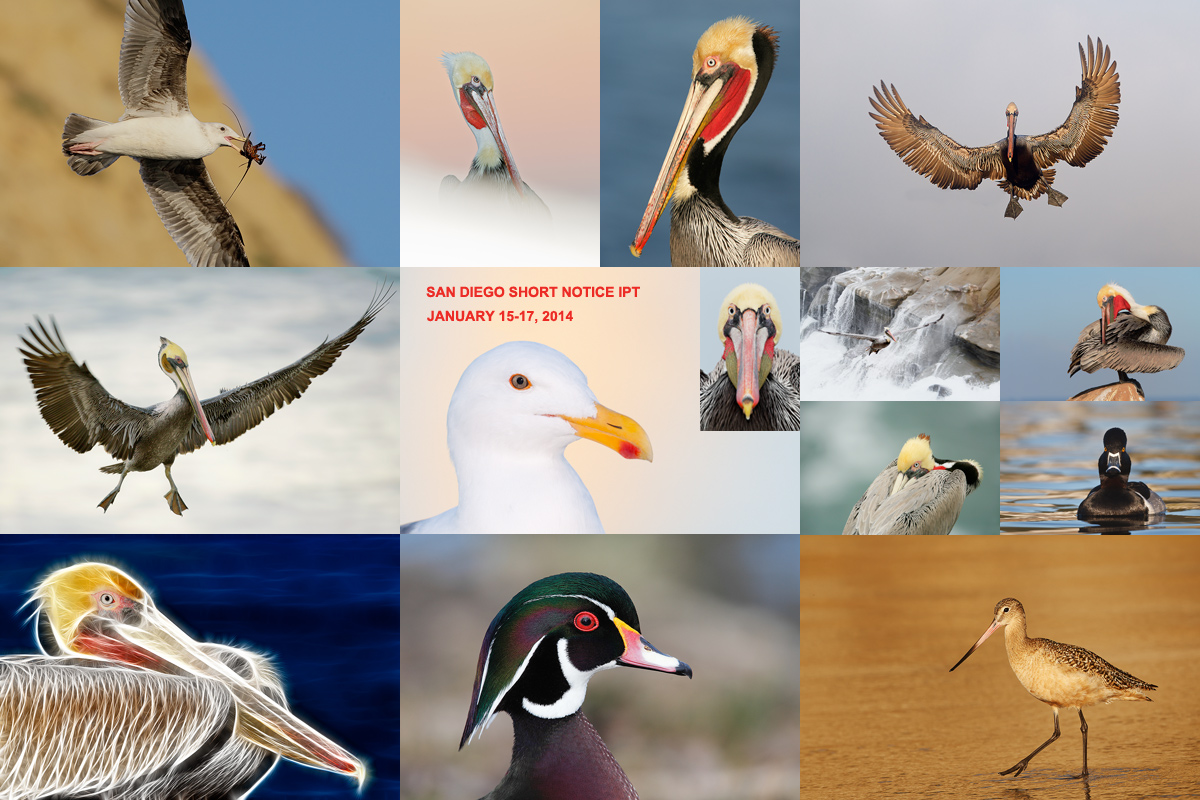
|
|
Join me in San Diego for three great days of photography and learning. Click on the image to better enjoy a larger version.
|
Only 1 Slot Left! Call or e-mail for Late Registration Discount info.
The San Diego Short-Notice Small Group IPT. January 15-17, 3-Full Days: $1049. Meet and Greet after dinner on your own at 7:30pm on Tuesday, January 14, 2014. Limit 6/Openings: 1.
We will get to photograph the California race of Brown Pelican in flight, resting, preening, cleaning their bill pouches, and talking to their neighbors by tossing their bills high in the air. The afternoon sessions will feature Marbled Godwits, several gull species, and Wood and Ring-necked Ducks. If we have a cloudy morning we will get to photograph Harbor Seals. You will learn to get the right exposure every time, to see the best situation, to think like a pro, to create sharp, pleasing images, and to understand the joint effects of light and wind on the birds. All in a small group with tons of individual attention.
A $500 non-refundable deposit is required to hold your slot for this IPT. Your balance will be due no later than January 7, 2014. The balance is also non-refundable. If the trip fills, we will be glad to apply a credit applicable to a future IPT for the full amount less a $100 processing fee. If we do not receive your check for the balance on or before the due date we will try to fill your spot from the waiting list. If your spot is filled, you will lose your deposit. If not, you can secure your spot by paying your balance.
If you are planning to register please shoot me an e-mail.
Then please print, complete, and sign the form that is linked to here and shoot it to us along with your deposit check (made out to “Arthur Morris.”) Though we prefer a check, you can also leave your deposit with a credit card by calling the office at 863-692-0906. If you register by phone, please print, complete and sign the form as noted above and either mail it to us or e-mail the scan.
If you have any questions, please feel free to contact me via e-mail
San Diego Site Guide
Can’t make the IPT? Get yourself a copy of the San Diego Site Guide; it’s the next best thing to being on an IPT. Nearly 30 years of San Diego bird photography revealed in one fell swoop.


IPT Info
Many of our great trips are filling up. You will learn more about how to make great images on a BAA IPT than anywhere else on the planet. Click here for info on the Anhinga Trail IPT. Click here for info on the Estero Lagoon IPT. And click here to learn about the just-announced 2014 Bosque IPTs. You will find additional IPTs and general info here.
Great Buy: Used Canon 800mm f/5/6L IS Lens for Sale
Friend and multiple IPT-veteran Monte Brown is offering his lightly used Canon 800mm f/5.6L IS lens in excellent condition for sale for $9,500. Purchase includes the lens case and hood, the 4th Generation Design Low Foot, the original foot, a LensCoat, the original invoice and the original Canon shipping carton. The lens was purchased new from B&H in April 2009 and was recently underwent a pre-sale clean and check by Canon. The buyer pays insured shipping via UPS Ground to US addresses only. The lens will be shipped only after your check clears.
The Canon EF 800mm f/5.6L IS USM Autofocus lens sells new for $13,223.00 so you will save a bundle on a great lens. No need to ever use a 2X…
If interested you can contact Monte by phone at 1-765-744-1421 or via e-mail.
Last Year’s Grand Prize winning image by Lou Coetzer
Time is Running Out!
BIRDS AS ART 2nd International Bird Photography Competition
The December 31, 2013 closing deadline is fast approaching.
Learn more and enter the BIRDS AS ART 2nd International Bird Photography Competition here. Twenty-five great prizes including the $1000 Grand Prize and intense competition. Bring your best.
Support the BAA Blog. Support the BAA Bulletins: Shop B&H here!
We want and need to keep providing you with the latest free information, photography and Photoshop lessons, and all manner of related information. Show your appreciation by making your purchases immediately after clicking on any of our B&H or Amazon Affiliate links in this blog post. Remember, B&H ain’t just photography!




Amazon
Everyone buys something from Amazon, be it a big lens or deodorant. Support the blog by starting your search by clicking on the logo-link below. No purchase is too small to be appreciated; they all add up. Why make it a habit? Because I make it a habit of bringing you new images and information on an almost daily basis.
Typos
In all blog posts and Bulletins feel free to e-mail or leave a comment regarding any typos, wrong words, misspellings, omissions, or grammatical errors. Just be right. 🙂
December 28th, 2013
Photographing in the Fog
Many folks are turned off by photographing in the fog. On the foggy IPT morning when the image above was created at the Venice Rookery, I remember folks looking at my properly exposed-to-the-right images on the back of my camera. “They look so washed out, so foggy,” was the universal reaction. Most folks do not realize that the potential for digital images created in foggy conditions is remarkable. Just be sure to expose well to the right so that the image on the rear LCD does look washed out. See the optimized image immediately below.
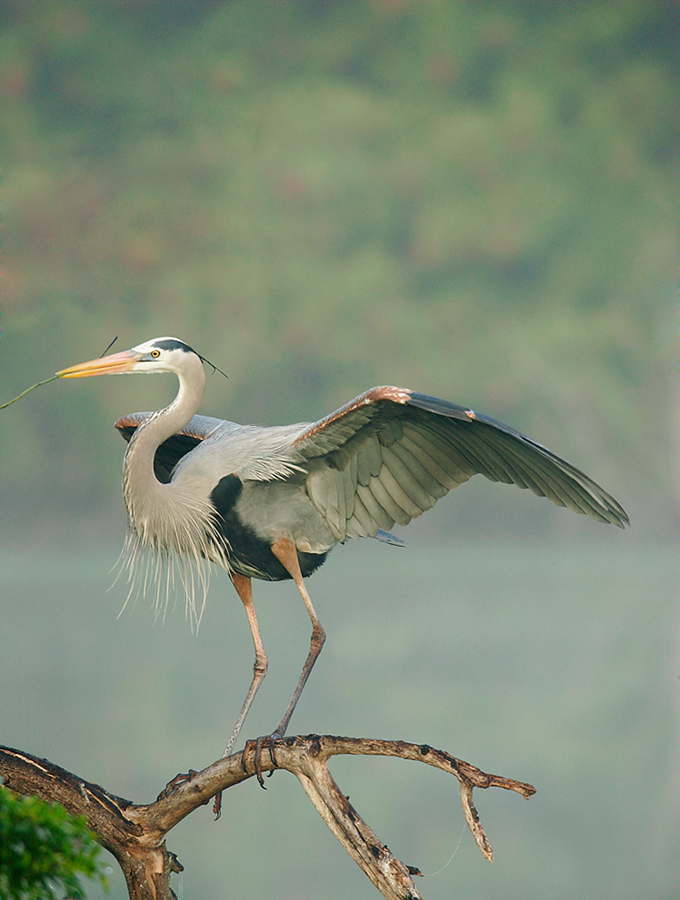
|
|
The optimized image here was created from the original image that opened this blog post.
|
The Image Optimization
Eliminating the foggy look was simply a matter of a Levels adjustment and a Curves Adjustment. Those represented one minute of work total. Cleaning up the image probably took 15-20 minutes using “Protect and Defend” work with the Clone Stamp Tool and “Divide and Conquer” work with the Patch Tool. All as described in Digital Basics File, an instructional PDF that is sent via e-mail. It includes my complete digital workflow, dozens of great Photoshop tips, several different ways to expand canvas, all of my time-saving Keyboard Shortcuts, Quick Masking, Layer Masking, and NIK Color Efex Pro basics, my killer image clean-up techniques, Digital Eye Doctor, and tons more.
Today clean-up would go a lot quicker using the Protective Cloning on a Layer with a Regular Layer Mask added that Denise Ippolito so kindly taught me.
Before and After
Hopefully the animated GIF file above will help you to learn to embrace foggy conditions. Just be sure to expose to the right; once you follow your normal conversion and Photoshop workflow procedures, you will be greatly rewarded.
Interestingly enough, I wound up using this image, cropped to a square, as back cover art for The Art of Bird Photography II (ABP II: 916 pages/900+ images on CD only). The back cover features a wonderful quote from friend and fellow professional Jim Brandenburg:
Arthur Morris’s bird photographs have a truly unparalleled elegance. As artist, he shares a rare gift of intimacy in his work, then as teacher, powerfully describes the steps of this most delicate ballet with his shy and elusive feathered partner.
Learn lots more about ABP II and our other educational offerings here.
If you would like to learn to create your own animated GIFs and the basics of putting text on an image check out our “Animated GIF Video Tutorial” here. And be sure to check out our complete collection of Photoshop (and other) Video Tutorials by clicking here.

|
|
This afternoon seminar is 100% free and open to the public.
|
Free Afternoon Seminar
Join Denise Ippolito and me on the afternoon of January 28, 2014 at 1:00pm in the Boca Grande Community Center for a free two-part nature photography seminar entitled “Birds and Blooms.” At 1:00pm I will be presenting “A Bird Photographer’s Story” (updated with lots of my favorite new images). Denise will follow with her hugely popular “Bloomin’ Ideas.” The venue is located at 131 First Street West, Boca Grande, FL 33921.
Suggestion
Join us for the free seminar and then for the Venice Rookery IPT the following day.

|
|
Do join us on the Venice Rookery IPT, or better yet, for the whole South Florida Composite IPT. Scroll down or click here for complete details.
|
The 2014 South Florida Mini-IPTs
Because of our intense travel schedule that includes a trip to Japan I will not be running the traditional SW FLA IPT. In addition, in an effort to give some folks a chance to get a taste of our teaching and our passion for bird photography, Denise Ippolito and I have organized a series of short IPTs that may be combined into one wonderful experience or enjoyed piecemeal.
Jan 29 (WED): Venice Rookery In-the-Field: all day: (Limit 14/Openings 10): $399. Introductory slide program 7pm, Jan 28.
30 (THURS) -Venice am only. (Limit 14/Openings 10):: $249
You can sign up for one or more of the short IPTs and/or one or more of the add-on days or you can opt to sign up for the all the sessions. Those signing up for the whole shebang will be having all lunches and dinners with us most every day.
A $500 non-refundable deposit is required to hold your slot for this IPT. For the short segments that are less than $500 payment in full is due at the time of registration. Your balance is due 4 months before the date of the IPT and is also non-refundable. If the trip fills, we will be glad to apply a credit applicable to a future IPT for the full amount less a $100 processing fee. If we do not receive your check for the balance on or before the due date we will try to fill your spot from the waiting list. If your spot is filled, you will lose your deposit. If not, you can secure your spot by paying your balance. Best to call Jim or Jennifer with a credit card in hand to register. Credit cards are not accepted for balances. Alternatively you can send a check for $500 made out to Arthur Morris to us at PO Box 7245, Indian Lake Estates, FL, 33855. Please include a note with your e-mail address and be sure to let us know what you are signing up for.


IPT Info
Many of our great trips are filling up. You will learn more about how to make great images on a BAA IPT than anywhere else on the planet. Click here for info on the Anhinga Trail IPT. Click here for info on the Estero Lagoon IPT. Click here for info on the just announced San Diego Short Notice IPT–only 1 slot left on that one. And click here to learn about the just-announced 2014 Bosque IPTs. You will find additional IPTs and general info here.
Great Buy: Used Canon 800mm f/5/6L IS Lens for Sale
Friend and multiple IPT-veteran Monte Brown is offering his lightly used Canon 800mm f/5.6L IS lens in excellent condition for sale for $9,500. Purchase includes the lens case and hood, the 4th Generation Design Low Foot, the original foot, a LensCoat, the original invoice and the original Canon shipping carton. The lens was purchased new from B&H in April 2009 and was recently underwent a pre-sale clean and check by Canon. The buyer pays insured shipping via UPS Ground to US addresses only. The lens will be shipped only after your check clears.
The Canon EF 800mm f/5.6L IS USM Autofocus lens sells new for $13,223.00 so you will save a bundle on a great lens. No need to ever use a 2X…
If interested you can contact Monte by phone at 1-765-744-1421 or via e-mail.
Last Year’s Grand Prize winning image by Lou Coetzer
Time is Running Out!
BIRDS AS ART 2nd International Bird Photography Competition
The December 31, 2013 closing deadline is fast approaching.
Learn more and enter the BIRDS AS ART 2nd International Bird Photography Competition here. Twenty-five great prizes including the $1000 Grand Prize and intense competition. Bring your best.
Support the BAA Blog. Support the BAA Bulletins: Shop B&H here!
We want and need to keep providing you with the latest free information, photography and Photoshop lessons, and all manner of related information. Show your appreciation by making your purchases immediately after clicking on any of our B&H or Amazon Affiliate links in this blog post. Remember, B&H ain’t just photography!




Amazon
Everyone buys something from Amazon, be it a big lens or deodorant. Support the blog by starting your search by clicking on the logo-link below. No purchase is too small to be appreciated; they all add up. Why make it a habit? Because I make it a habit of bringing you new images and information on an almost daily basis.
Typos
In all blog posts and Bulletins feel free to e-mail or leave a comment regarding any typos, wrong words, misspellings, omissions, or grammatical errors. Just be right. 🙂
December 27th, 2013
Time is Running Out!
BIRDS AS ART 2nd International Bird Photography Competition
The December 31, 2013 closing deadline is fast approaching.
Click here or scroll down for details
|
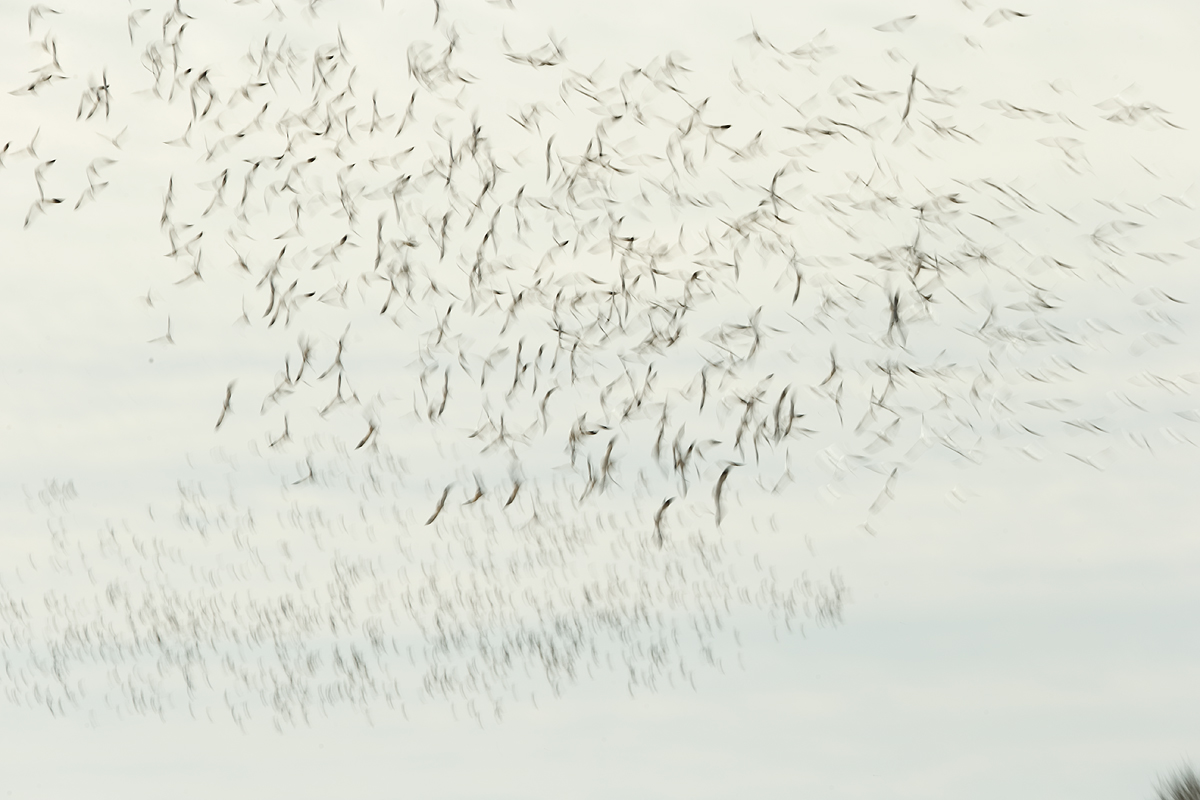
|
|
This Snow Geese 2-flock blur image was created at 10:28am on the December 1, 2013 at Bosque del Apache NWR with the Gitzo 3532 LS carbon fiber tripod, the Mongoose M3.6 head, the Canon EF 200-400mm f/4L IS USM Lens with Internal 1.4x Extender (at 200mm) and the Canon EOS-1D X. ISO 50. Evaluative metering +2 stops off the white sky: 1/30 sec. at f/11 in Manual Mode. Color temperature 7000K.
Central sensor/AI Servo/Surround–Rear Focus AF as framed active at the moment of exposure. Click here to see the latest version of the Rear Focus Tutorial. Click on the image to see a larger version.
The extracted JPEG here accurately represents the original image capture. Please click on the image to see a larger version.
|
The Original
Above is a JPEG that represents the original capture. Note that +2 stops off the white sky was not nearly enough. Plus 3 would have been a lot better. I love that the closer birds were flying in one direction but that the more distant flock was flying opposite the direction of my pan.
Why do I wish that I had panned the camera up and left a bit more?
|

|
|
Version I
Please click on the image to see a larger version.
|
First Try
Above is my first effort at optimizing this image. I used a good dose of NIK Detail Extractor and Tonal Contrast, probably about 25%. What did I not like about Verzion I?
|
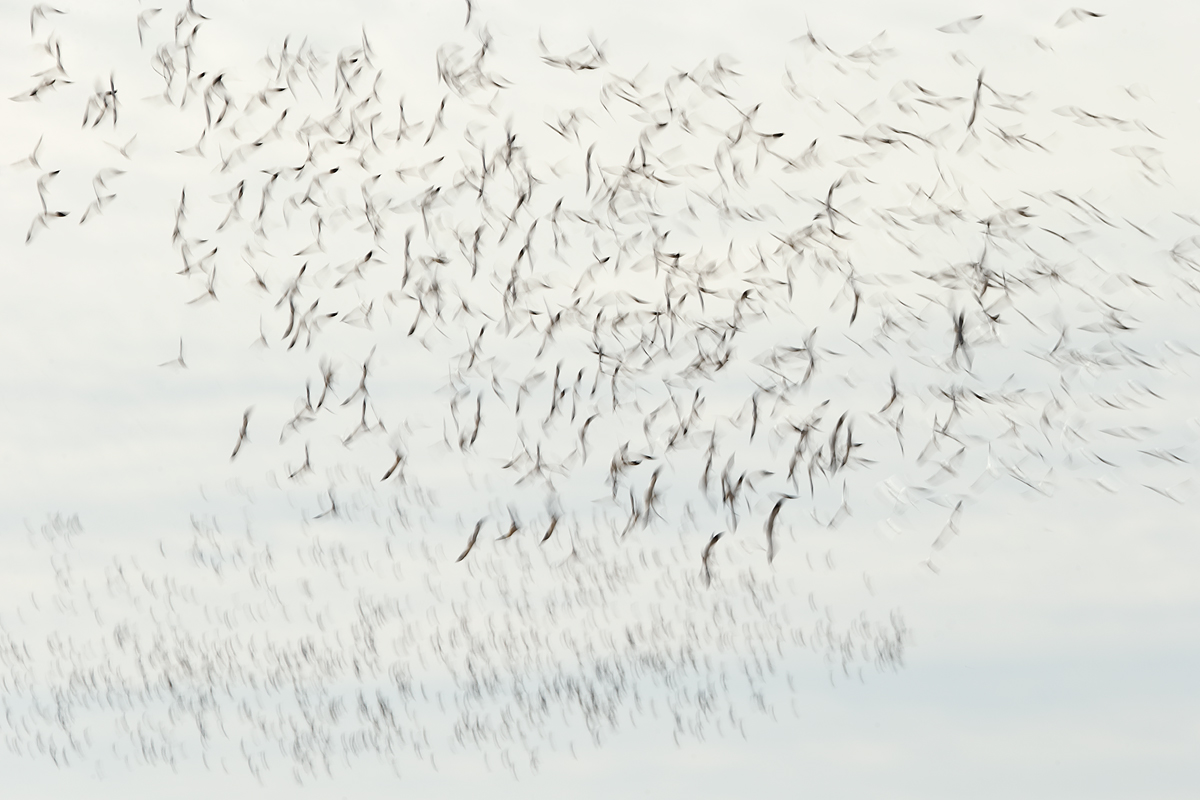
|
Version II
Please click on the image to see a larger version.
|
Second Try
When I re-did the image I cropped it a bit wider and did not use any NIK. When I compared Version II to Version I I liked the tighter crop and and the contrastier look of Version I. So back to work I went.
|

|
Version III
Please click on the image to see a larger version.
|
Snow Goose Image Optimization/Need Your Help/Opinion
What do you think of Version III? Which version do you like best? Be sure to let us know why you like the one that you do. Which crop do you like best? Why? What would you have done differently? What do you think of the top of the tree in the lower right corner of the original?
If you would like to take a crack at optimizing this image shoot me an e-mail with the words “Snow Goose 2-Flock Blur” in the Subject line and I will send you the a full sized version of the image converted in DPP via e-mail. If you like your results you may send me a 1200 pixel wide sharpened JPEG by return e-mail.


|
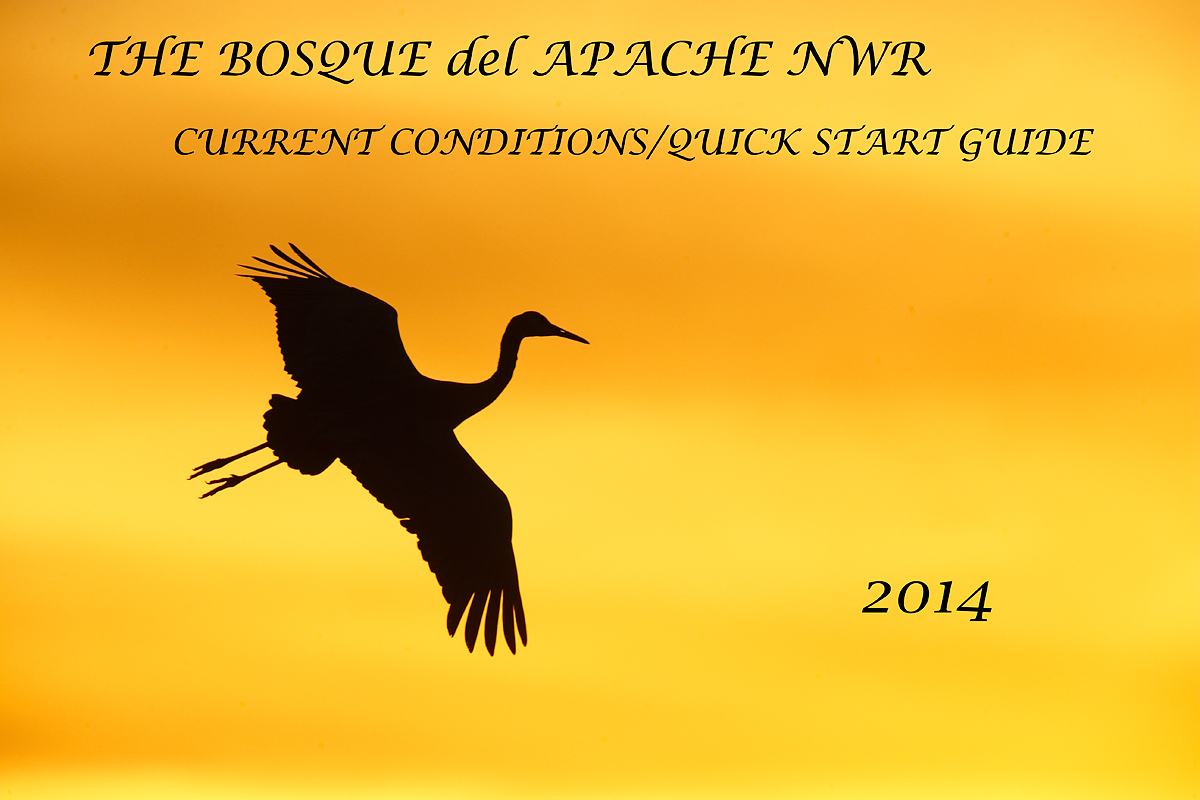
|
|
The 2014 Bosque Quick Start Guide/Current Conditions Update is available as a stand alone purchase. See below for details.
|
The “2014 Bosque Quick Start Guide/Current Conditions Update”
If you purchase our Bosque Site Guide ($50) today, you will receive the complete Bosque Site Guide in one e-mail, and then you will receive the 2014 Bosque Quick Start Guide/Current Conditions Update at no charge to you.
We are, as we did last year, offering the 2014 Bosque Quick Start Guide/Current Conditions Update as a stand-alone purchase for only $25. You can order your copy right now in the BAA Online Store by clicking here. Your PDF will be sent via e-mail.
Click here for lots more info on this new eGuide.
Bosque del Apache 2014 BIRDS AS ART/A Creative Adventure Instructional Photo-Tour (IPT). NOV 29-DEC 3, 2014. 3 FULL and 2 HALF-DAYS: $1449. Leaders: Arthur Morris and Denise Ippolito. Introductory Slide program: 7:00pm on Sunday 11/29.
Tens of thousand of Snow Geese, 10,000 Sandhill Cranes, ducks, amazing sunrises, sunsets, and blast-offs. Live, eat, and breathe photography with two of the world’s premier photographic educators at one of their very favorite photography locations on the planet. Top-notch in-the-field and Photoshop instruction. This will make 21 consecutive Novembers at Bosque for artie. This will be denise’s 6th workshop at the refuge. Nobody knows the place better than artie does. Join us to learn to think like a pro, to recognize situations and to anticipate them based on the weather, especially the sky conditions, the light, and the wind direction. Every time we make a move we will let you know why. When you head home being able to apply what you’ve learned on your home turf will prove to be invaluable.
This workshop includes 4 afternoon (11/29 through 12/2), 4 morning (11/30 to 12/3) photography sessions, an inspirational introductory slide program after dinner on your own on Saturday, 11/29, all lunches, and after-lunch digital workflow, Photoshop, and image critiquing sessions.
There is never a strict itinerary on a Bosque IPT as each day is tailored to the local conditions at the time and to the weather. We are totally flexible in order to maximize both the photographic and learning opportunities. We are up early each day leaving the hotel by 5:30 am to be in position for sunrise. We usually photograph until about 10:30am. Then it is back to Socorro for lunch and then a classroom session with the group most days. We head back to the refuge at about 3:30pm each day and photograph until sunset. We will be photographing lots of Snow Geese and lots of Sandhill Cranes with the emphasis on expanding both your technical skills and your creativity.
A $449 non-refundable deposit is required to hold your slot for this IPT. Your balance, payable only by check, will be due on 7/25/2014. If the trip fills, we will be glad to apply a credit applicable to a future IPT for the full amount less a $100 processing fee. If we do not receive your check for the balance on or before the due date we will try to fill your spot from the waiting list. If your spot is filled, you will lose your deposit. If not, you can secure your spot by paying your balance.
Please print, complete, and sign the form that is linked to here and shoot it to us along with your deposit check (made out to “Arthur Morris.”) You can also leave your deposit with a credit card by calling the office at 863-692-0906. If you register by phone, please print, complete and sign the form as noted above and either mail it to us or e-mail the scan. If you have any questions, please feel free to contact me via e-mail.
Bosque del Apache 2014 A Creative Adventure/BIRDS AS ART “Creative Photography Instructional Photo-Tour.” (IPT). NOV 24-25, 2014. 2-FULL DAYS: $729. Leaders: Denise Ippolito & Arthur Morris. Introductory Slide program: 7:00pm on Sunday 11/23.
Learn to unleash your creative juices at the wondrous Bosque del Apache National Wildlife Refuge in San Antonio, New Mexico with two great leaders including the amazingly talented and creative Denise Ippolito. In-the-field instruction will include tips on gear set-up, on creating a variety of pleasing blurs, on getting the right exposure, and on designing pleasing images. And lots more. From vertical pan blurs to subject motion blurs to zoom blurs to multiple exposures we will cover it all. This workshop will include an inspirational introductory slide program on Sunday evening, 11/23 after dinner on your own, two morning and two afternoon photography sessions, all lunches, a digital workflow and Photoshop session after lunch on Monday, and an image critiquing session after lunch on Tuesday.
A $329 non-refundable deposit is required to hold your slot for this IPT. Your balance, payable only by check, will be due on 7/25/2014. If the trip fills, we will be glad to apply a credit applicable to a future IPT for the full amount less a $100 processing fee. If we do not receive your check for the balance on or before the due date we will try to fill your spot from the waiting list. If your spot is filled, you will lose your deposit. If not, you can secure your spot by paying your balance.
Please print, complete, and sign the form that is linked to here and shoot it to us along with your deposit check (made out to “Arthur Morris.”) You can also leave your deposit with a credit card by calling the office at 863-692-0906. If you register by phone, please print, complete and sign the form as noted above and either mail it to us or e-mail the scan. If you have any questions, please feel free to contact me via e-mail.
IPT Info
Many of our great trips are filling up. You will learn more about how to make great images on a BAA IPT than anywhere else on the planet. Click here for info on the Anhinga Trail IPT. Click here for info on the Estero Lagoon IPT. Click here for info on the just announced San Diego Short Notice IPT–only 1 slot left on that one. And click here to learn about the just-announced 2014 Bosque IPTs. You will find additional IPTs and general info here.
Great Buy: Used Canon 800mm f/5/6L IS Lens for Sale
Friend and multiple IPT-veteran Monte Brown is offering his lightly used Canon 800mm f/5.6L IS lens in excellent condition for sale for $9,500. Purchase includes the lens case and hood, the 4th Generation Design Low Foot, the original foot, a LensCoat, the original invoice and the original Canon shipping carton. The lens was purchased new from B&H in April 2009 and was recently underwent a pre-sale clean and check by Canon. The buyer pays insured shipping via UPS Ground to US addresses only. The lens will be shipped only after your check clears.
The Canon EF 800mm f/5.6L IS USM Autofocus lens sells new for $13,223.00 so you will save a bundle on a great lens. No need to ever use a 2X…
If interested you can contact Monte by phone at 1-765-744-1421 or via e-mail.
Last Year’s Grand Prize winning image by Lou Coetzer
Time is Running Out!
BIRDS AS ART 2nd International Bird Photography Competition
The December 31, 2013 closing deadline is fast approaching.
Learn more and enter the BIRDS AS ART 2nd International Bird Photography Competition here. Twenty-five great prizes including the $1000 Grand Prize and intense competition. Bring your best.
Support the BAA Blog. Support the BAA Bulletins: Shop B&H here!
We want and need to keep providing you with the latest free information, photography and Photoshop lessons, and all manner of related information. Show your appreciation by making your purchases immediately after clicking on any of our B&H or Amazon Affiliate links in this blog post. Remember, B&H ain’t just photography!




Amazon
Everyone buys something from Amazon, be it a big lens or deodorant. Support the blog by starting your search by clicking on the logo-link below. No purchase is too small to be appreciated; they all add up. Why make it a habit? Because I make it a habit of bringing you new images and information on an almost daily basis.
Typos
In all blog posts and Bulletins feel free to e-mail or leave a comment regarding any typos, wrong words, misspellings, omissions, or grammatical errors. Just be right. 🙂
December 26th, 2013
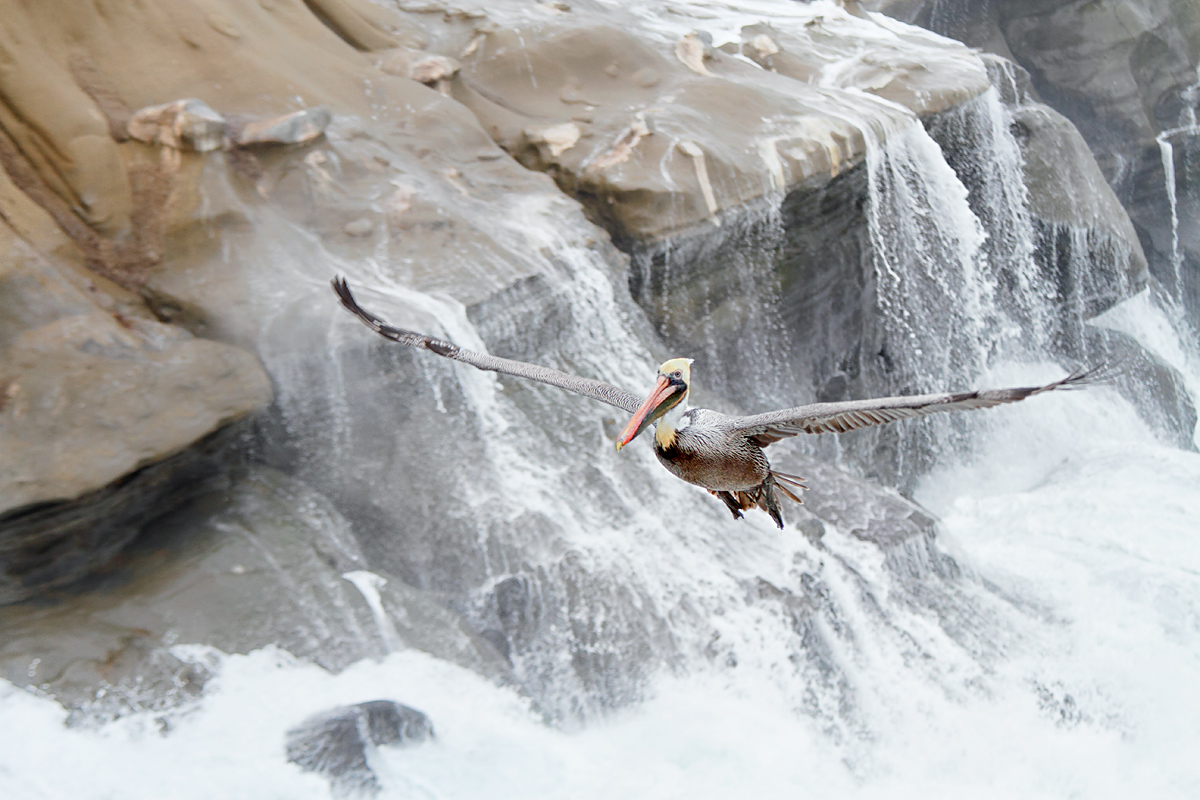
|
|
This Brown Pelican image was created in January, 2010 with the Canon EF 70-200mm f/2.8L IS II USM lens (hand held at 108mm) and the EOS-7D (now replaced for me by the Canon EOS 5D Mark III Digital camera body). ISO 500. Evaluative metering +2 1/3 stops off of the cloudy white sky: 1/500 sec. at f/5.6 in Manual mode.
Central Sensor AI Servo Rear Focus AF as framed active at the moment of exposure. Click here to see the latest version of the Rear Focus Tutorial. Be sure to click on the image to enjoy a larger version.
|
The #1 Reason to Work in Manual Mode for Flight Photography
It’s simple. If the possibility of rapidly changing background tonality exists (as it almost always does with flight photography), you need to be in Manual mode to ensure the correct exposure for the bird. If I had been working in Av mode for this image, the camera would have seen all of that white water on a cloudy day and would have severely underexposed the RAW file. And that is the last thing that you would ever want to do with the small pixels of the EOS-7D. If you lighten an underexposed image you are simply increasing the noise. That is why learning to Expose to the Right (ETTR) is more than important. It too is mandatory and imperative….
The above, however, does not mean that you should be working in Manual mode all the time. That is a myth. To learn the whole story, see the “At Long Last, As Promised: the Greatest, Most Educational Blog Post Ever? Manual… Av… Tv… Program… Which is The Best Shooting Mode?” blog post here. What is the best plan? Bookmark it and study it. Often.
Do understand that if you do not understand exposure theory, if you do not know how to work in Manual mode–don’t be scared it’s really the same as Av and Tv, and if you do not know how to check for blinkies, analyze a histogram, and adjust your exposure parameters you will not consistently come up with perfect exposures. Being in one mode or another does not guarantee a proper exposure unless you are well-versed as above. To learn to get the right exposure every time I recommend getting the 2-Book Bundle. In The Art of Bird Photography (the original ABP in soft cover–the classic how-to book on bird photography) you will need to study the Exposure chapter and most especially the section on Exposure Theory. In The Art of Bird Photography II (ABP II: 916 pages, 900+ images on CD only), you will need to study Exposure Simplified and all 900+ of our educational image captions. Each explains how I metered and how I compensated in order to come up with a workable exposure in short order.
Image Questions
#1: If I had been using the 5D Mark III for this image what would I have had to have done differently?
#2: Why did I selectively apply a 100% layer of NIK Detail Extractor and a small Linear Burn to this image?
|

|
|
Join me in San Diego for three great days of photography and learning. Click on the image to better enjoy a larger version.
|
Only 1 Slot Open!
The San Diego Short-Notice Small Group IPT. January 15-17, 3-Full Days: $1049. Meet and Greet after dinner on your own at 7:30pm on Tuesday, January 14, 2014. Limit 6/Openings: 1.
We will get to photograph the California race of Brown Pelican in flight, resting, preening, cleaning their bill pouches, and talking to their neighbors by tossing their bills high in the air. The afternoon sessions will feature Marbled Godwits, several gull species, and Wood and Ring-necked Ducks. If we have a cloudy morning we will get to photograph Harbor Seals. You will learn to get the right exposure every time, to see the best situation, to think like a pro, to create sharp, pleasing images, and to understand the joint effects of light and wind on the birds. All in a small group with tons of individual attention.
A $500 non-refundable deposit is required to hold your slot for this IPT. Your balance will be due no later than January 7, 2014. The balance is also non-refundable. If the trip fills, we will be glad to apply a credit applicable to a future IPT for the full amount less a $100 processing fee. If we do not receive your check for the balance on or before the due date we will try to fill your spot from the waiting list. If your spot is filled, you will lose your deposit. If not, you can secure your spot by paying your balance.
If you are planning to register please shoot me an e-mail.
Then please print, complete, and sign the form that is linked to here and shoot it to us along with your deposit check (made out to “Arthur Morris.”) Though we prefer a check, you can also leave your deposit with a credit card by calling the office at 863-692-0906. If you register by phone, please print, complete and sign the form as noted above and either mail it to us or e-mail the scan.
If you have any questions, please feel free to contact me via e-mail
San Diego Site Guide
Can’t make the IPT? Get yourself a copy of the San Diego Site Guide; it’s the next best thing to being on an IPT. Nearly 30 years of San Diego bird photography revealed in one fell swoop.
IPT Info
Many of our great trips are filling up. You will learn more about how to make great images on a BAA IPT than anywhere else on the planet. Click here for info on the Anhinga Trail IPT. Click here for info on the Estero Lagoon IPT. And click here to learn about the just-announced 2014 Bosque IPTs. You will find additional IPTs and general info here.
Great Buy: Used Canon 800mm f/5/6L IS Lens for Sale
Friend and multiple IPT-veteran Monte Brown is offering his lightly used Canon 800mm f/5.6L IS lens in excellent condition for sale for $9,500. Purchase includes the lens case and hood, the 4th Generation Design Low Foot, the original foot, a LensCoat, the original invoice and the original Canon shipping carton. The lens was purchased new from B&H in April 2009 and was recently underwent a pre-sale clean and check by Canon. The buyer pays insured shipping via UPS Ground to US addresses only. The lens will be shipped only after your check clears.
The Canon EF 800mm f/5.6L IS USM Autofocus lens sells new for $13,223.00 so you will save a bundle on a great lens. No need to ever use a 2X…
If interested you can contact Monte by phone at 1-765-744-1421 or via e-mail.
Last Year’s Grand Prize winning image by Lou Coetzer
Time is Running Out!
BIRDS AS ART 2nd International Bird Photography Competition
The December 31, 2013 closing deadline is fast approaching.
Learn more and enter the BIRDS AS ART 2nd International Bird Photography Competition here. Twenty-five great prizes including the $1000 Grand Prize and intense competition. Bring your best.
Support the BAA Blog. Support the BAA Bulletins: Shop B&H here!
We want and need to keep providing you with the latest free information, photography and Photoshop lessons, and all manner of related information. Show your appreciation by making your purchases immediately after clicking on any of our B&H or Amazon Affiliate links in this blog post. Remember, B&H ain’t just photography!




Amazon
Everyone buys something from Amazon, be it a big lens or deodorant. Support the blog by starting your search by clicking on the logo-link below. No purchase is too small to be appreciated; they all add up. Why make it a habit? Because I make it a habit of bringing you new images and information on an almost daily basis.
Typos
In all blog posts and Bulletins feel free to e-mail or leave a comment regarding any typos, wrong words, misspellings, omissions, or grammatical errors. Just be right. 🙂
December 25th, 2013
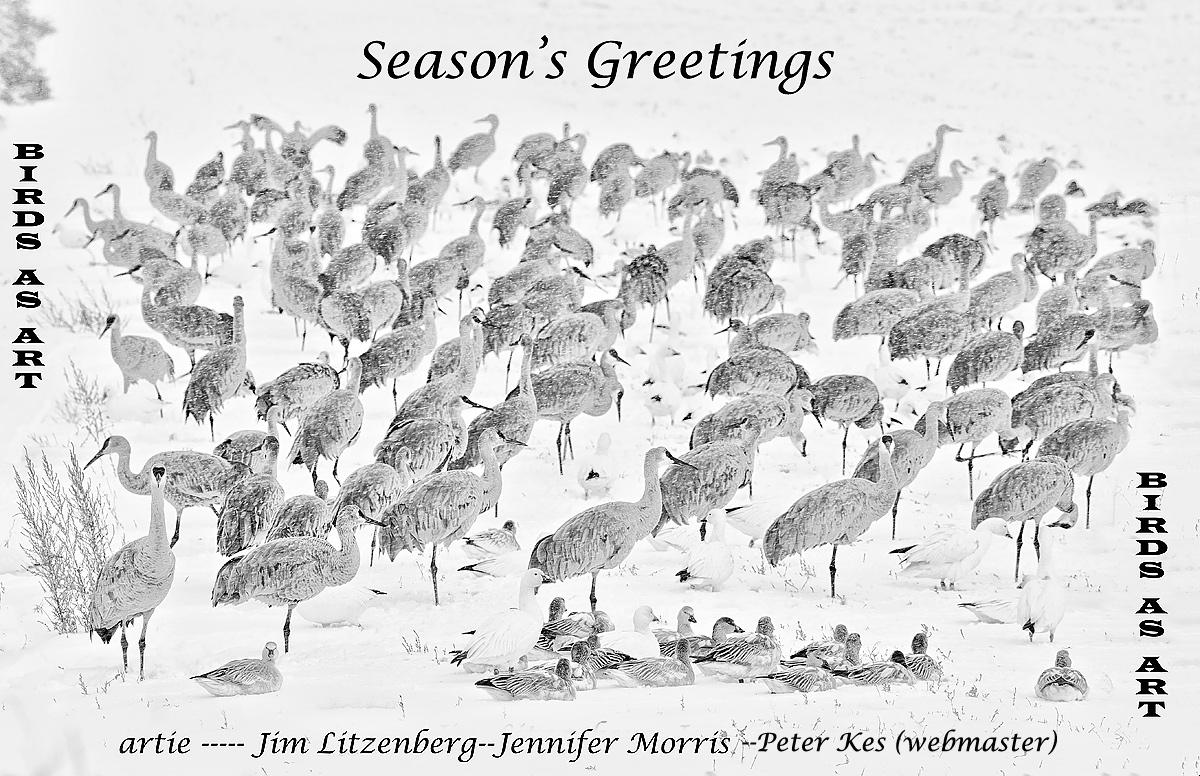
|
|
Breathe deeply. Have fun. Love what is. Don’t take it personally. Happiness is a choice 🙂
|
Image Questions
Which is your favorite crane? Which is your favorite goose?
later and love, artie
Interesting Bosque Note
On my not-so-recent twentieth visit in late fall to the refuge (12 days of photography and teaching) I probably created at least 6,000 images. I just finished my fourth and final edit. Here is the tally: 429 RAW files, 12 in-camera HDR JPEGs, and 2 movie (.MOV) files kept. 85 images optimized so far. Keeper rate: 7.35%. I am a ruthless when it comes to editing. Now it is time to copy the Bosque 2013 to Transfer file to the Drobo system on the office computer.
December 24th, 2013
|

|
|
The 2014 Bosque Quick Start Guide/Current Conditions Update is available as a stand alone purchase. See below for details.
|
2014 Bosque Secrets Revealed
Every year at Bosque del Apache National Wildlife Refuge is different. Heck, after 20 straight years of visiting in late fall I can honestly say that every day is different. Every year however there are major trends that differ from the year before. And these trends can have a big effect on the quality of your photographic experience. I have just finished working on the 2014 Bosque Quick Start Guide/Current Conditions Update.
|

|
|
I know where to make images like this on most mornings. Do you? The 2014 Bosque Quick Start Guide/Current Conditions Update tells you exactly where and when to be…. On most but not all mornings of course. And if the situation is not there, you will be in the right place anyway!
Image #1: Snow Goose Flapping After Bath
|
“Announcing the 2014 Bosque Quick Start Guide/Current Conditions Update”
The 2014 Bosque Quick Start Guide/Current Conditions Update will be sent at no charge to folks who have previously purchased our Bosque Site Guide. In this new, stand-alone guide I will enlighten you as to what’s new at the refuge and what’s old that works. Where should you be at dawn with a north wind? Which crane pool is better? What’s with that new pond? Where are the two best spots to be at sunset? Where should you be at 7:30am on a cloudy morning?
All of those questions are answered in detail in the new Quick Start Guide/Update. The Quick Start Guide contains a basic synopsis of the complete guide including the best pre-dawn strategies, the best crane pool strategies, the best afternoon strategies, and the best sunset strategies. Heck, BAA Site Guides are the next best thing to being on an IPT. This new e-Guide includes 41 images, all but one created in 2013. Most are spectacular and inspiring, all include an educational caption designed to teach you to be in the right place at the right time in the right weather. Take advantage of my 20 years of experience at Bosque by getting yourself a copy of this great new guide right now.
For folks who already own our Bosque Site Guide, here’s the rub: My daughter Jennifer, who sends out all updates, is enjoying the holidays with her husband’s family in Gainesville, FL. She will be back on December 30. She will send the update that Monday or Tuesday. If you will be visiting Bosque this week and need the update now, please cut and paste (or screen capture) the top of the first page of the Bosque Site Guide into an e-mail and shoot it to Jim via e-mail with the words “Early Request for 2014 Bosque Update” cut and pasted into the Subject Line. Everyone on the list should receive the update early next week.
|
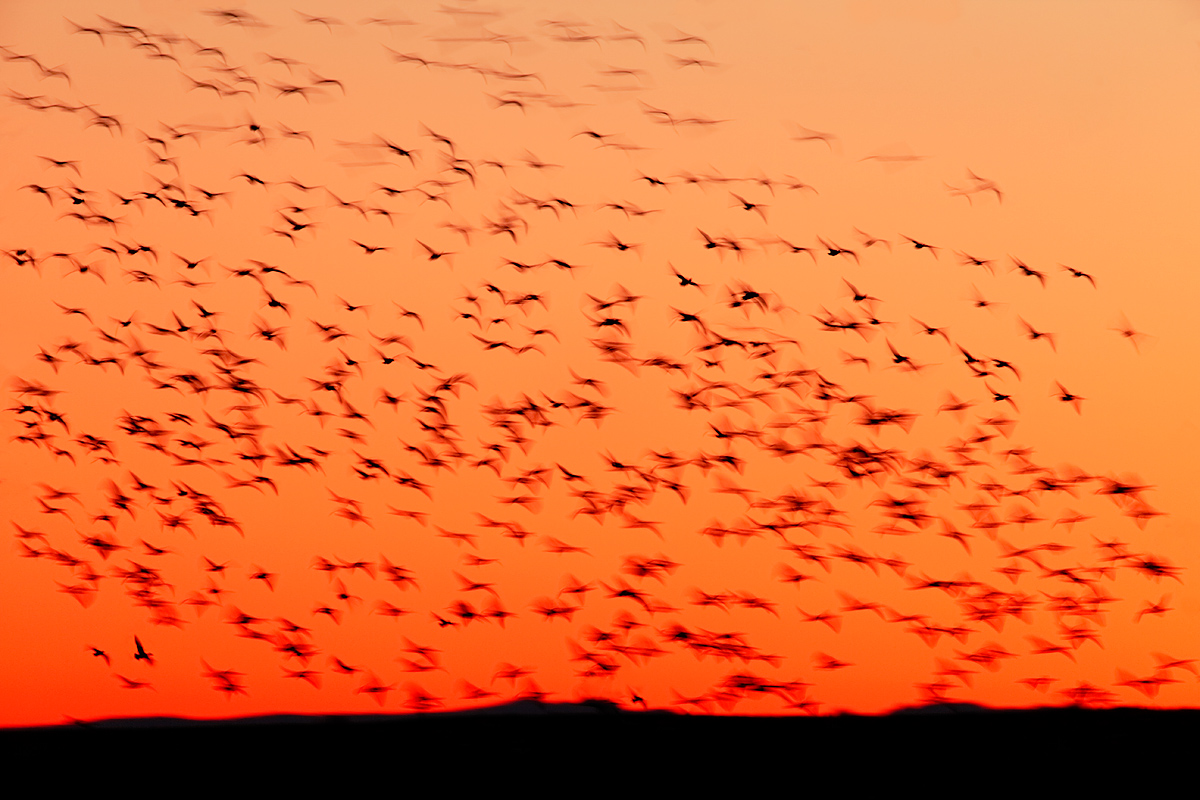
|
|
Most folks are headed back to Socorro when images like this are there for the taking. It’s all about knowing where to be when…. And of course, the Quick Start Guide lets you know.
Image #2: Snow Goose Evening Fly-In
|
More on the “2014 Bosque Quick Start Guide/Current Conditions Update”
If you purchase our Bosque Site Guide ($50) today, you will receive the complete Bosque Site Guide in one e-mail, and then you will receive the 2014 Bosque Quick Start Guide/Current Conditions Update at no charge to you.
We are, as we did last year, offering the 2014 Bosque Quick Start Guide/Current Conditions Update as a stand-alone purchase for only $25. You can order your copy right now in the BAA Online Store by clicking here. Your PDF will be sent via e-mail.
|
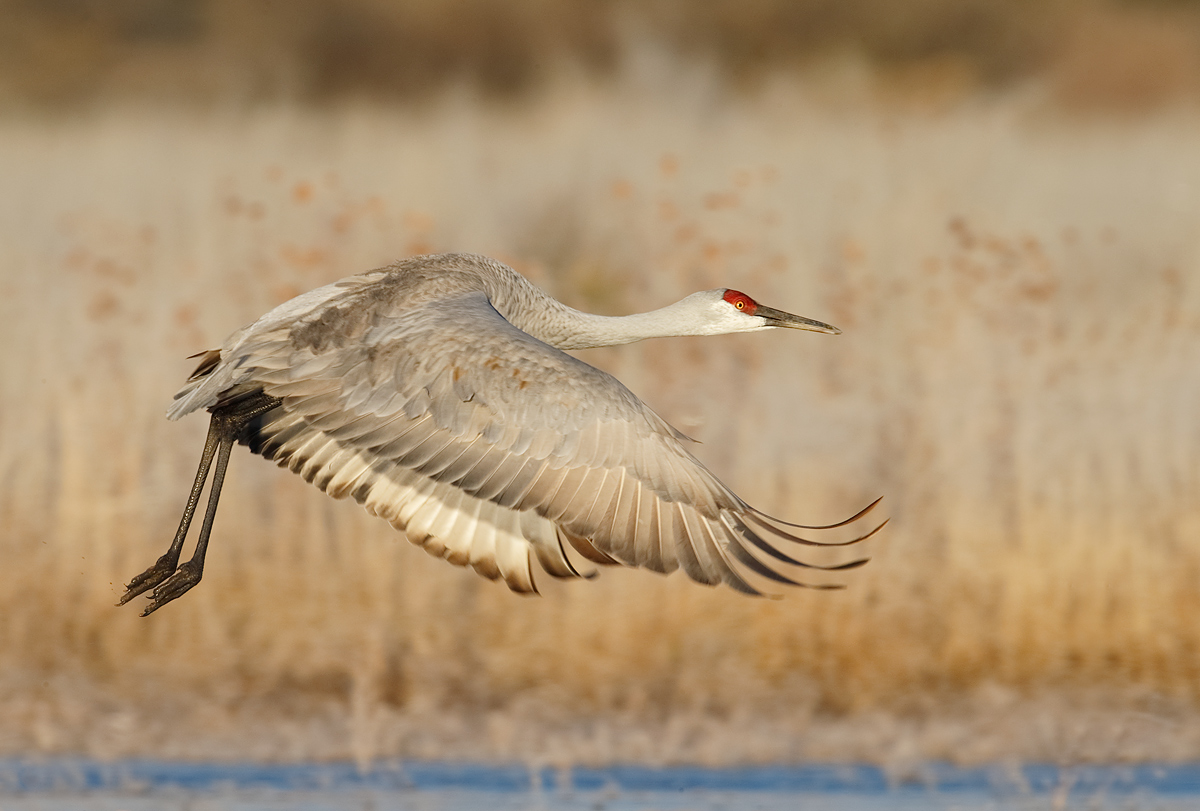
|
|
How well do you understand the relationship of wind, the direction of light, and flight photography.
Image #3: Sandhill Crane Taking Flight
|
Wind, Light, and Flight Photography.
The Quick Start Guide explains the basic relationship between wind, light, and flight photography. And it explains many of the fine points as well. It tells you exactly where to be and when for photographing outbound cranes like the one above in flight, and even tells you what to do when the wind direction is less than ideal.
|
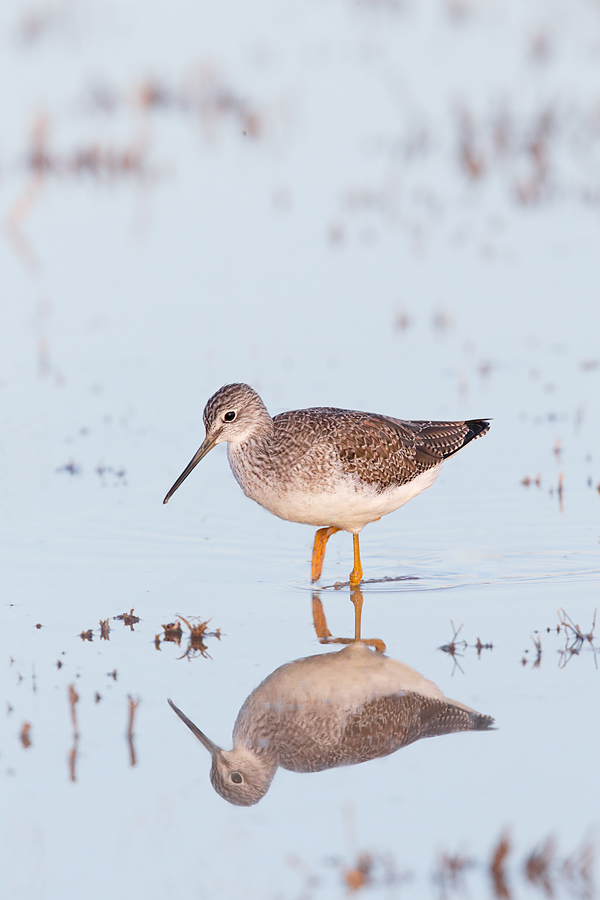
|
|
Few folks know of a good shorebird photography location at the refuge. I do, and I share it with you in the new guide.
Image #4: Long-legged Shorebird Foraging
|
ID?
Can you identify the shorebird in the image above? Can you tell us anything more about it?
If not, you should get yourself a copy of Shorebirds; Beautiful Beachcombers.
Your Favorite?
Which of the four images above is your favorite? Be sure to let us know why you like the one you do.
Bosque del Apache 2014 BIRDS AS ART/A Creative Adventure Instructional Photo-Tour (IPT). NOV 29-DEC 3, 2014. 3 FULL and 2 HALF-DAYS: $1449. Leaders: Arthur Morris and Denise Ippolito. Introductory Slide program: 7:00pm on Sunday 11/29.
Tens of thousand of Snow Geese, 10,000 Sandhill Cranes, ducks, amazing sunrises, sunsets, and blast-offs. Live, eat, and breathe photography with two of the world’s premier photographic educators at one of their very favorite photography locations on the planet. Top-notch in-the-field and Photoshop instruction. This will make 21 consecutive Novembers at Bosque for artie. This will be denise’s 6th workshop at the refuge. Nobody knows the place better than artie does. Join us to learn to think like a pro, to recognize situations and to anticipate them based on the weather, especially the sky conditions, the light, and the wind direction. Every time we make a move we will let you know why. When you head home being able to apply what you’ve learned on your home turf will prove to be invaluable.
This workshop includes 4 afternoon (11/29 through 12/2), 4 morning (11/30 to 12/3) photography sessions, an inspirational introductory slide program after dinner on your own on Saturday, 11/29, all lunches, and after-lunch digital workflow, Photoshop, and image critiquing sessions.
There is never a strict itinerary on a Bosque IPT as each day is tailored to the local conditions at the time and to the weather. We are totally flexible in order to maximize both the photographic and learning opportunities. We are up early each day leaving the hotel by 5:30 am to be in position for sunrise. We usually photograph until about 10:30am. Then it is back to Socorro for lunch and then a classroom session with the group most days. We head back to the refuge at about 3:30pm each day and photograph until sunset. We will be photographing lots of Snow Geese and lots of Sandhill Cranes with the emphasis on expanding both your technical skills and your creativity.
A $449 non-refundable deposit is required to hold your slot for this IPT. Your balance, payable only by check, will be due on 7/25/2014. If the trip fills, we will be glad to apply a credit applicable to a future IPT for the full amount less a $100 processing fee. If we do not receive your check for the balance on or before the due date we will try to fill your spot from the waiting list. If your spot is filled, you will lose your deposit. If not, you can secure your spot by paying your balance.
Please print, complete, and sign the form that is linked to here and shoot it to us along with your deposit check (made out to “Arthur Morris.”) You can also leave your deposit with a credit card by calling the office at 863-692-0906. If you register by phone, please print, complete and sign the form as noted above and either mail it to us or e-mail the scan. If you have any questions, please feel free to contact me via e-mail.
Bosque del Apache 2014 A Creative Adventure/BIRDS AS ART “Creative Photography Instructional Photo-Tour.” (IPT). NOV 24-25, 2014. 2-FULL DAYS: $729. Leaders: Denise Ippolito & Arthur Morris. Introductory Slide program: 7:00pm on Sunday 11/23.
Learn to unleash your creative juices at the wondrous Bosque del Apache National Wildlife Refuge in San Antonio, New Mexico with two great leaders including the amazingly talented and creative Denise Ippolito. In-the-field instruction will include tips on gear set-up, on creating a variety of pleasing blurs, on getting the right exposure, and on designing pleasing images. And lots more. From vertical pan blurs to subject motion blurs to zoom blurs to multiple exposures we will cover it all. This workshop will include an inspirational introductory slide program on Sunday evening, 11/23 after dinner on your own, two morning and two afternoon photography sessions, all lunches, a digital workflow and Photoshop session after lunch on Monday, and an image critiquing session after lunch on Tuesday.
A $329 non-refundable deposit is required to hold your slot for this IPT. Your balance, payable only by check, will be due on 7/25/2014. If the trip fills, we will be glad to apply a credit applicable to a future IPT for the full amount less a $100 processing fee. If we do not receive your check for the balance on or before the due date we will try to fill your spot from the waiting list. If your spot is filled, you will lose your deposit. If not, you can secure your spot by paying your balance.
Please print, complete, and sign the form that is linked to here and shoot it to us along with your deposit check (made out to “Arthur Morris.”) You can also leave your deposit with a credit card by calling the office at 863-692-0906. If you register by phone, please print, complete and sign the form as noted above and either mail it to us or e-mail the scan. If you have any questions, please feel free to contact me via e-mail.
IPT Info
Many of our great trips are filling up. You will learn more about how to make great images on a BAA IPT than anywhere else on the planet. Click here for info on the Anhinga Trail IPT. Click here for info on the Estero Lagoon IPT. Click here for info on the just announced San Diego Short Notice IPT–only 2 slots left on that one. And click here to learn about the just-announced 2014 Bosque IPTs. You will find additional IPTs and general info here.
Great Buy: Used Canon 800mm f/5/6L IS Lens for Sale
Friend and multiple IPT-veteran Monte Brown is offering his lightly used Canon 800mm f/5.6L IS lens in excellent condition for sale for $9,500. Purchase includes the lens case and hood, the 4th Generation Design Low Foot, the original foot, a LensCoat, the original invoice and the original Canon shipping carton. The lens was purchased new from B&H in April 2009 and was recently underwent a pre-sale clean and check by Canon. The buyer pays insured shipping via UPS Ground to US addresses only. The lens will be shipped only after your check clears.
The Canon EF 800mm f/5.6L IS USM Autofocus lens sells new for $13,223.00 so you will save a bundle on a great lens. No need to ever use a 2X…
If interested you can contact Monte by phone at 1-765-744-1421 or via e-mail.
Last Year’s Grand Prize winning image by Lou Coetzer
Time is Running Out!
BIRDS AS ART 2nd International Bird Photography Competition
The December 31, 2013 closing deadline is fast approaching.
Learn more and enter the BIRDS AS ART 2nd International Bird Photography Competition here. Twenty-five great prizes including the $1000 Grand Prize and intense competition. Bring your best.
Support the BAA Blog. Support the BAA Bulletins: Shop B&H here!
We want and need to keep providing you with the latest free information, photography and Photoshop lessons, and all manner of related information. Show your appreciation by making your purchases immediately after clicking on any of our B&H or Amazon Affiliate links in this blog post. Remember, B&H ain’t just photography!




Amazon
Everyone buys something from Amazon, be it a big lens or deodorant. Support the blog by starting your search by clicking on the logo-link below. No purchase is too small to be appreciated; they all add up. Why make it a habit? Because I make it a habit of bringing you new images and information on an almost daily basis.
Typos
In all blog posts and Bulletins feel free to e-mail or leave a comment regarding any typos, wrong words, misspellings, omissions, or grammatical errors. Just be right. 🙂
December 23rd, 2013
|
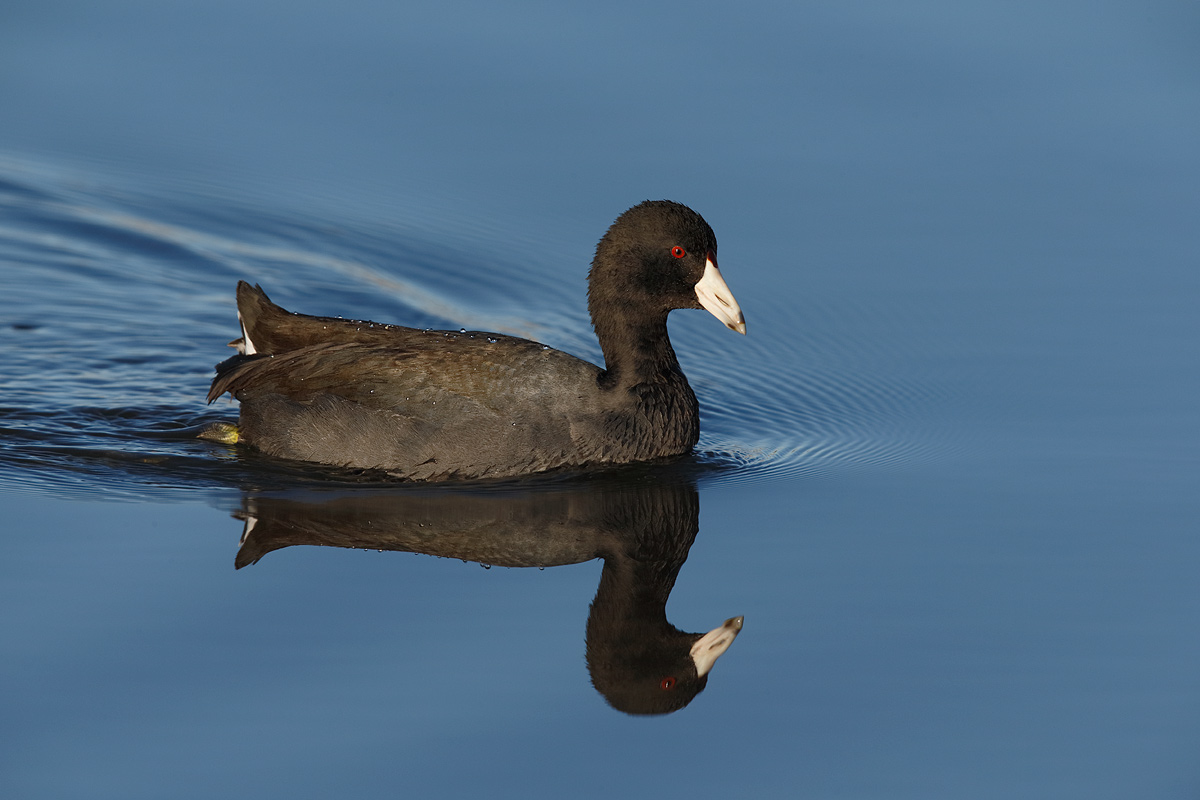
|
|
This American Coot image was created from inside my rental vehicle on the 2013 Bosque IPT with the Canon EF 600mm f/4L IS II USM lens, the Canon 2x EF Extender III (Teleconverter), and the Canon EOS-1D X. ISO 400. Evaluative metering -1 stop as framed: 1/800 sec. at f/10 in Manual mode.
Central sensor (by necessity) Expand/AI Servo Rear Focus AF just behind the back of the bird’s neck active at the moment of exposure. Click here if you missed the latest version of the Rear Focus Tutorial. Click on the image to see a larger version.
|
Even an Ugly Bird…
Ugly as a coot. Even an ugly bird can make for a beautiful image. Put that ugly bird in a nice setting–clean blue water here, add gorgeous late afternoon light, check for blinkies until you have a perfect exposure, and then create a sharp, well-composed photography. Convert the image in DPP and tidy up the bill shine and a few specular highlights in Photoshop. While you are there apply just a bit of Detail Extractor to the face and bill using a Hide-All Layer Mask and then paint in 100% Contrast Mask sharpening (15/65/0) on the face and 50% on the rest of the bird, again using a Hide-All Mask. Voila. You are good to go.
All of the above of course as described in detail in our Digital Basics File, an instructional PDF that is sent via e-mail. It includes my complete digital workflow, dozens of great Photoshop tips, several different ways to expand canvas, all of my time-saving Keyboard Shortcuts, Quick Masking, Layer Masking, and NIK Color Efex Pro basics, image clean-up techniques, Digital Eye Doctor, and tons more.
Client Richard Cornelius who was in the back seat with his borrowed Nikon 800mm lens also made some great images. As I remember he had one better than my image above. But I am scratching my head trying to figure out how it could have been better….
Image Questions
Why AI Servo AF active at the moment of exposure?
Why -1 full stop of exposure compensation (EC)?
What two things having to do with the bird’s posture add to the strength of this image?
Why didn’t I put the central sensor on the coot’s eye?
Coming Tomorrow: The Bosque Current Conditions Site Guide Update
This year’s Bosque Current Conditions Site Guide Update will be announced tomorrow. It will also be offered as a stand-alone purchase. Details will be announced in less than 18 hours. 🙂
Bosque del Apache 2014 A Creative Adventure/BIRDS AS ART “Creative Photography Instructional Photo-Tour.” (IPT). NOV 24-25, 2014. 2-FULL DAYS: $729. Leaders: Denise Ippolito & Arthur Morris. Introductory Slide program: 7:00pm on Sunday 11/23.
Learn to unleash your creative juices at the wondrous Bosque del Apache National Wildlife Refuge in San Antonio, New Mexico with two great leaders including the amazingly talented and creative Denise Ippolito. In-the-field instruction will include tips on gear set-up, on creating a variety of pleasing blurs, on getting the right exposure, and on designing pleasing images. And lots more. From vertical pan blurs to subject motion blurs to zoom blurs to multiple exposures we will cover it all. This workshop will include an inspirational introductory slide program on Sunday evening, 11/23 after dinner on your own, two morning and two afternoon photography sessions, all lunches, a digital workflow and Photoshop session after lunch on Monday, and an image critiquing session after lunch on Tuesday.
A $329 non-refundable deposit is required to hold your slot for this IPT. Your balance, payable only by check, will be due on 7/25/2014. If the trip fills, we will be glad to apply a credit applicable to a future IPT for the full amount less a $100 processing fee. If we do not receive your check for the balance on or before the due date we will try to fill your spot from the waiting list. If your spot is filled, you will lose your deposit. If not, you can secure your spot by paying your balance.
Please print, complete, and sign the form that is linked to here and shoot it to us along with your deposit check (made out to “Arthur Morris.”) You can also leave your deposit with a credit card by calling the office at 863-692-0906. If you register by phone, please print, complete and sign the form as noted above and either mail it to us or e-mail the scan. If you have any questions, please feel free to contact me via e-mail.
Bosque del Apache 2014 BIRDS AS ART/A Creative Adventure Instructional Photo-Tour (IPT). NOV 29-DEC 3, 2014. 3 FULL and 2 HALF-DAYS: $1449. Leaders: Arthur Morris and Denise Ippolito. Introductory Slide program: 7:00pm on Sunday 11/29.
Tens of thousand of Snow Geese, 10,000 Sandhill Cranes, ducks, amazing sunrises, sunsets, and blast-offs. Live, eat, and breathe photography with two of the world’s premier photographic educators at one of their very favorite photography locations on the planet. Top-notch in-the-field and Photoshop instruction. This will make 21 consecutive Novembers at Bosque for artie. This will be denise’s 6th workshop at the refuge. Nobody knows the place better than artie does. Join us to learn to think like a pro, to recognize situations and to anticipate them based on the weather, especially the sky conditions, the light, and the wind direction. Every time we make a move we will let you know why. When you head home being able to apply what you’ve learned on your home turf will prove to be invaluable.
This workshop includes 4 afternoon (11/29 through 12/2), 4 morning (11/30 to 12/3) photography sessions, an inspirational introductory slide program after dinner on your own on Saturday, 11/29, all lunches, and after-lunch digital workflow, Photoshop, and image critiquing sessions.
There is never a strict itinerary on a Bosque IPT as each day is tailored to the local conditions at the time and to the weather. We are totally flexible in order to maximize both the photographic and learning opportunities. We are up early each day leaving the hotel by 5:30 am to be in position for sunrise. We usually photograph until about 10:30am. Then it is back to Socorro for lunch and then a classroom session with the group most days. We head back to the refuge at about 3:30pm each day and photograph until sunset. We will be photographing lots of Snow Geese and lots of Sandhill Cranes with the emphasis on expanding both your technical skills and your creativity.
A $449 non-refundable deposit is required to hold your slot for this IPT. Your balance, payable only by check, will be due on 7/25/2014. If the trip fills, we will be glad to apply a credit applicable to a future IPT for the full amount less a $100 processing fee. If we do not receive your check for the balance on or before the due date we will try to fill your spot from the waiting list. If your spot is filled, you will lose your deposit. If not, you can secure your spot by paying your balance.
Please print, complete, and sign the form that is linked to here and shoot it to us along with your deposit check (made out to “Arthur Morris.”) You can also leave your deposit with a credit card by calling the office at 863-692-0906. If you register by phone, please print, complete and sign the form as noted above and either mail it to us or e-mail the scan. If you have any questions, please feel free to contact me via e-mail.
IPT Info
Many of our great trips are filling up. You will learn more about how to make great images on a BAA IPT than anywhere else on the planet. Click here for info on the Anhinga Trail IPT. Click here for info on the Estero Lagoon IPT. Click here for info on the just announced San Diego Short Notice IPT–only 2 slots left on that one. And click here to learn about the just-announced 2014 Bosque IPTs. You will find additional IPTs and general info here.
Great Buy: Used Canon 800mm f/5/6L IS Lens for Sale
Friend and multiple IPT-veteran Monte Brown is offering his lightly used Canon 800mm f/5.6L IS lens in excellent condition for sale for $9,500. Purchase includes the lens case and hood, the 4th Generation Design Low Foot, the original foot, a LensCoat, the original invoice and the original Canon shipping carton. The lens was purchased new from B&H in April 2009 and was recently underwent a pre-sale clean and check by Canon. The buyer pays insured shipping via UPS Ground to US addresses only. The lens will be shipped only after your check clears.
The Canon EF 800mm f/5.6L IS USM Autofocus lens sells new for $13,223.00 so you will save a bundle on a great lens. No need to ever use a 2X…
If interested you can contact Monte by phone at 1-765-744-1421 or via e-mail.
Last Year’s Grand Prize winning image by Lou Coetzer
Time is Running Out!
BIRDS AS ART 2nd International Bird Photography Competition
The December 31, 2013 closing deadline is fast approaching.
Learn more and enter the BIRDS AS ART 2nd International Bird Photography Competition here. Twenty-five great prizes including the $1000 Grand Prize and intense competition. Bring your best.
Support the BAA Blog. Support the BAA Bulletins: Shop B&H here!
We want and need to keep providing you with the latest free information, photography and Photoshop lessons, and all manner of related information. Show your appreciation by making your purchases immediately after clicking on any of our B&H or Amazon Affiliate links in this blog post. Remember, B&H ain’t just photography!




Amazon
Everyone buys something from Amazon, be it a big lens or deodorant. Support the blog by starting your search by clicking on the logo-link below. No purchase is too small to be appreciated; they all add up. Why make it a habit? Because I make it a habit of bringing you new images and information on an almost daily basis.
Typos
In all blog posts and Bulletins feel free to e-mail or leave a comment regarding any typos, wrong words, misspellings, omissions, or grammatical errors. Just be right. 🙂
December 22nd, 2013
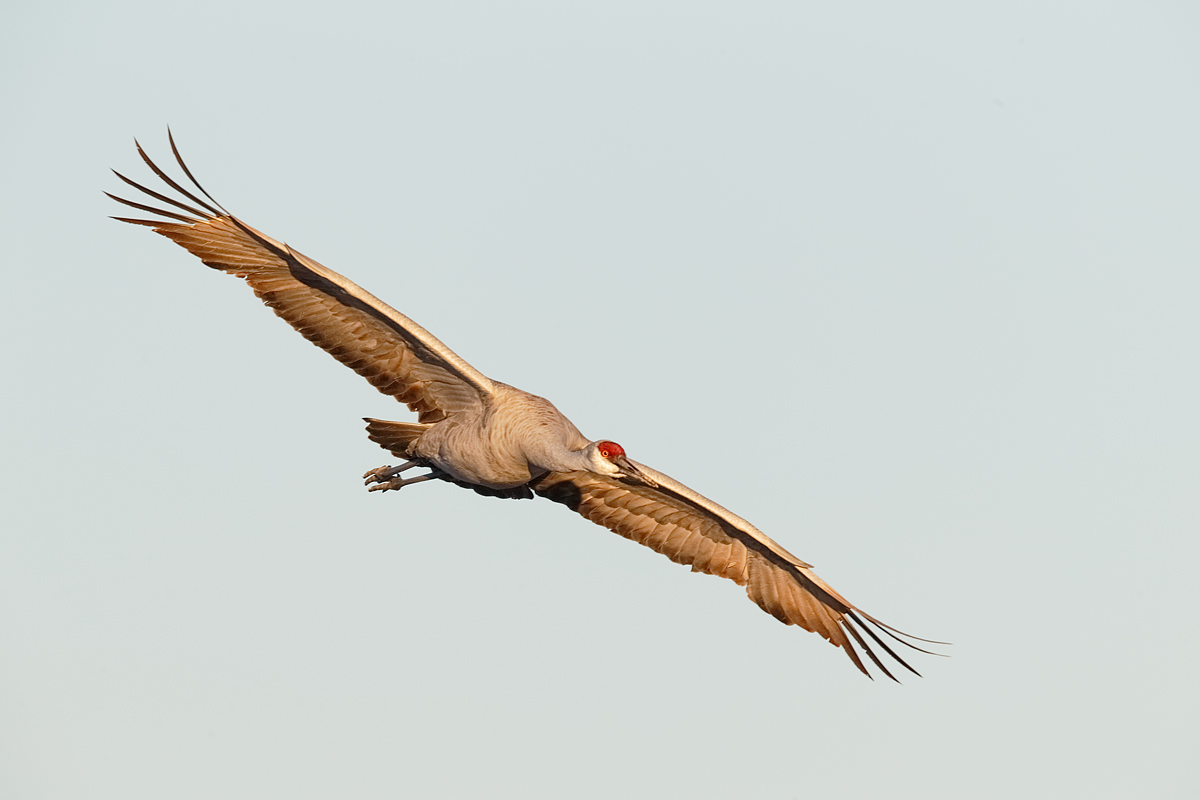
|
|
This image was created on the 2013 Bosque IPT with the Gitzo 3532 LS carbon fiber tripod, the Mongoose M3.6 head, the Canon EF 600mm f/4L IS II USM lens, the Canon 2x EF Extender III (Teleconverter), and the Canon EOS-1D X. ISO 800. Evaluative metering +1 stop as framed: 1/1000 sec. at f/9 in Manual mode.
I set the exposure manually at +1 1/3 stops off the light blue sky in late afternoon light. That worked out to +1 stop as framed here because the bird is somewhat darker than the sky. In the crane image below, +1 1/3 stops off the sky worked out to the metered exposure…. See more in the next image caption below.
Central sensor (by necessity) Expand/AI Servo Rear Focus AF on the head of the crane active at the moment of exposure. But it is likely that one of the Surround AF points took over and just caught that bird’s head. Click here if you missed the latest version of the Rear Focus Tutorial. Click on the image to see a larger version.
|
Manual… Av… Tv… Program… Which is The Best Shooting Mode?
This is one of the age old photography questions: what is the best shooting mode? There are many who state definitively: “Real photographers work in Manual mode 100% of the time.” Many who preach this as gospel are hard-headed, obnoxious, loud-mouthed, and ignorant. Others simply prefer to work in Manual mode most or all of the time but realize that other modes might be best for other photographers (or clients) in a given situation.
At present I work in Manual mode most of the time, probably about 80% I would guess. I often work in Av mode, probably about 15% of the time. I occasionally work in Tv mode, probably about 4% of the time, but more than that when I am at Bosque del Apache NWR late each fall. (BTW, happy winter; it began today just after noon on December 21, 2013, at 12:11pm EST.) And I actually work in Program mode on rare occasion.
So what is the best shooting mode? The best shooting mode is the one that works best for you in a given situation. I will share my Shooting Mode preferences with you here.
Manual Mode
As I mentioned above, I now work in Manual mode about 80% of the time on average. When photographing birds against backgrounds of rapidly changing tonality or when that possibility exists, working in Manual mode is mandatory. This is such an important principle that I will state it again: when photographing birds against backgrounds of rapidly changing tonality working in Manual mode is mandatory.
Why? If you are in an automatic mode like Av or Tv and the background goes from light sky to dark trees you are dead in the water. Nobody can change the exposure compensation (EC) from say plus 2 to minus 1/3 stop instantly. Not to mention the times when the framing might yield both sky and trees or mountains in varying proportions. To learn to work in Manual Mode click here.
Similarly, you must be in Manual mode when the size of a very light or very dark subject in the frame is changing. Why? Unusually light or dark subjects have a big influence on your camera’s meter.
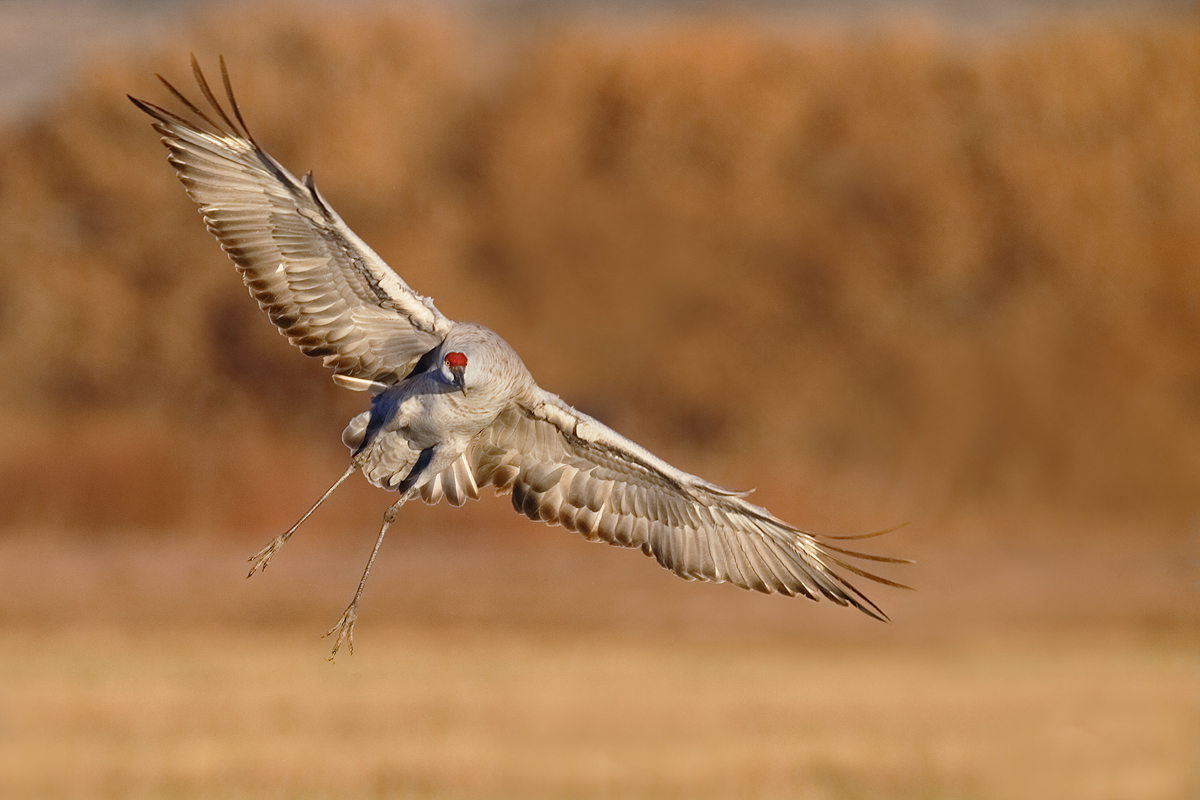
|
|
This image was also created on the 2013 Bosque IPT with the Gitzo 3532 LS carbon fiber tripod, the Mongoose M3.6 head, the Canon EF 600mm f/4L IS II USM lens, the Canon 2x EF Extender III (Teleconverter), and the Canon EOS-1D X. ISO 800. Evaluative metering at zero as framed: 1/1000 sec. at f/9 in Manual mode.
The two crane images here were made about two minutes apart; the light on the subject was constant. I began by metering the sky and adding 1 1/3 stops in the late afternoon light. When working in Manual mode you strive to get the right exposure for the subject. That is what I did here. Note that the exposure for both images was 1/1000 sec. at f/9 at ISO 800. With the bird against the sky the exposure worked out to +1 as framed. With the bird set against the yellowish brown trees in the distance, the exposure worked out to the metered exposure, that is 0 EC or no exposure compensation. Understand that the exposure settings for each image were identical: 1/1000 sec. at f/9 at ISO 800. As the light on the birds was constant the correct exposure for the subjects were the same regardless of the background. Had I been working in Av mode at f/9 I would have needed to have been at +1 stop for the first image and then at zero for the image here. Changing the exposure compensation from +1 to 0 in less than an instant is simply not possible. That is why you need to learn to work in Manual mode whenever the background tonality might change.
Central sensor (by necessity) Expand/AI Servo Rear Focus AF on the bird’s lower breast active at the moment of exposure. Click here if you missed the latest version of the Rear Focus Tutorial. Click on the image to see a larger version.
|
Manual Mode Misconceptions and Myths
One common Manual mode misconception is that when the light is changing from moment to moment that it is easier and better to work in Manual mode. This is definitely true when the background and the light are or may be changing quickly. But when the light is changing and the background is of uniform and constant tonality, working in Av (or Tv) is often simpler, better, and faster.
Let say that you are working at the beach and all of your subjects are on the sand and average to middle light in tonality. Most gulls and most shorebirds come to mind. Nothing is flying around. But the sun is peeking in and out of the clouds. As long as you understand exposure and the way that your camera’s meter works you may find it easier, more intuitive, and faster to work in Av mode: when the sun is out you make all of your images at 0 or +1/3 stop depending on your camera body. When the sun is behind a cloud you will set something like +1 2/3stops EC. For Nikon folks these values would likely be -1/3 or -2/3 stop when the sun is out and +1 stop or so when a cloud covers the sun.
This brings us to another Manual mode myth: “If you work in Manual mode you will always get the right exposure.” Nothing could be further from the truth. In fact, the statement is laughable. If you understand exposure it does not matter which shooting mode you are in. The fact is that Manual mode is Av mode is Tv mode as far as exposure is concerned. If you set your ISO, shutter speed, and aperture correctly in Manual mode so that you wind up with the right exposure and the analog screen in your viewfinder shows +2/3 stop, then you can simply work in Av or Tv mode and set +2/3 stop EC. As long as the framing and background remain the same the exposure will be identical.
Do not, however, forget the original premise above: When photographing subjects against backgrounds of rapidly changing tonality working in Manual mode is mandatory. If you attempt to work in any automatic mode against backgrounds of changing tonalities you will wind up with many exposure errors.
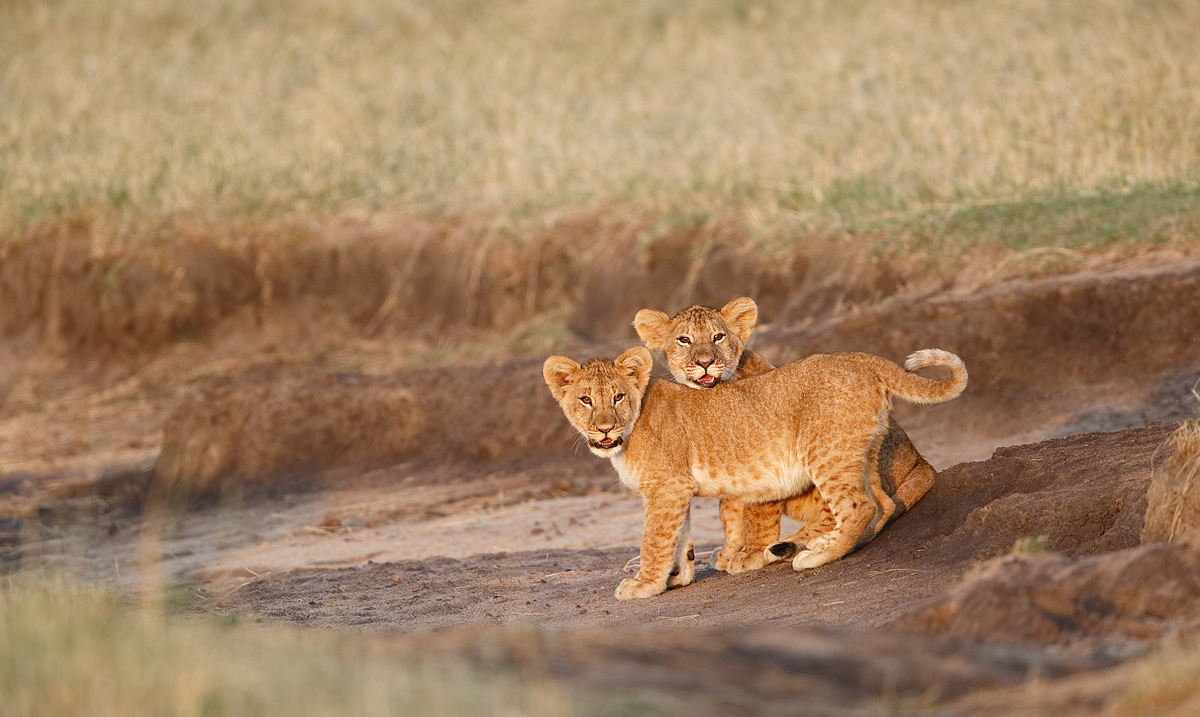
|
|
This image of a pair of playful African Lion cubs was created with the Todd-pod mounted Canon EF 600mm f/4L IS II USM lens, the Canon 1.4x EF Extender III (Teleconverter), and the Canon EOS-1D X Digital SLR camera. ISO 800 Evaluative metering +1/3 stop: 1/400 sec. at f/5.6.in Av mode in soft morning light.
One sensor below the central sensor/AI Servo Surround/Rear Focus AF on the face of the closest cub active at the moment of exposure. Click here if you missed the Rear Focus Tutorial. Click on the image to see a larger version.
In situations where I happen to be in Av mode and I am absolutely sure of the correct EC (exposure compensation), it is faster and easier to continue working in Av mode than it is to switch to Manual mode. That was the case here as I knew that +1/3 stop would be perfect. It was. As always, getting the right exposure has nothing to do with what shooting mode you are in.
|
Getting the Right Exposure: Shooting Mode Does Not Matter!
The key to getting the right exposure depends on your knowledge of exposure theory, on understanding how to get the right exposure, on understanding how your camera’s meter works, on understanding the quality and direction of the light, and on knowing how to evaluate your histogram, check for blinkies, and adjust your exposure accordingly. Getting the right exposure has nothing to do with what shooting mode you are in. Again, do not forget the original premise above: When photographing subjects against backgrounds of rapidly changing tonality or when light or dark subject size is changing, working in Manual mode is mandatory.
To learn exposure theory, to begin to gain an understanding of how to get the right exposure, and to learn to properly evaluate you histograms, check for flashing highlight alerts, and adjust your exposure parameters, we recommend getting a copy of The Art of Bird Photography (soft cover) with its classic treatment of Exposure Theory, and a copy of The Art of Bird Photography II (916 pages on CD only). See and study the section on Exposure Simplified in the latter. You can save $10 by purchasing the 2-book bundle here.
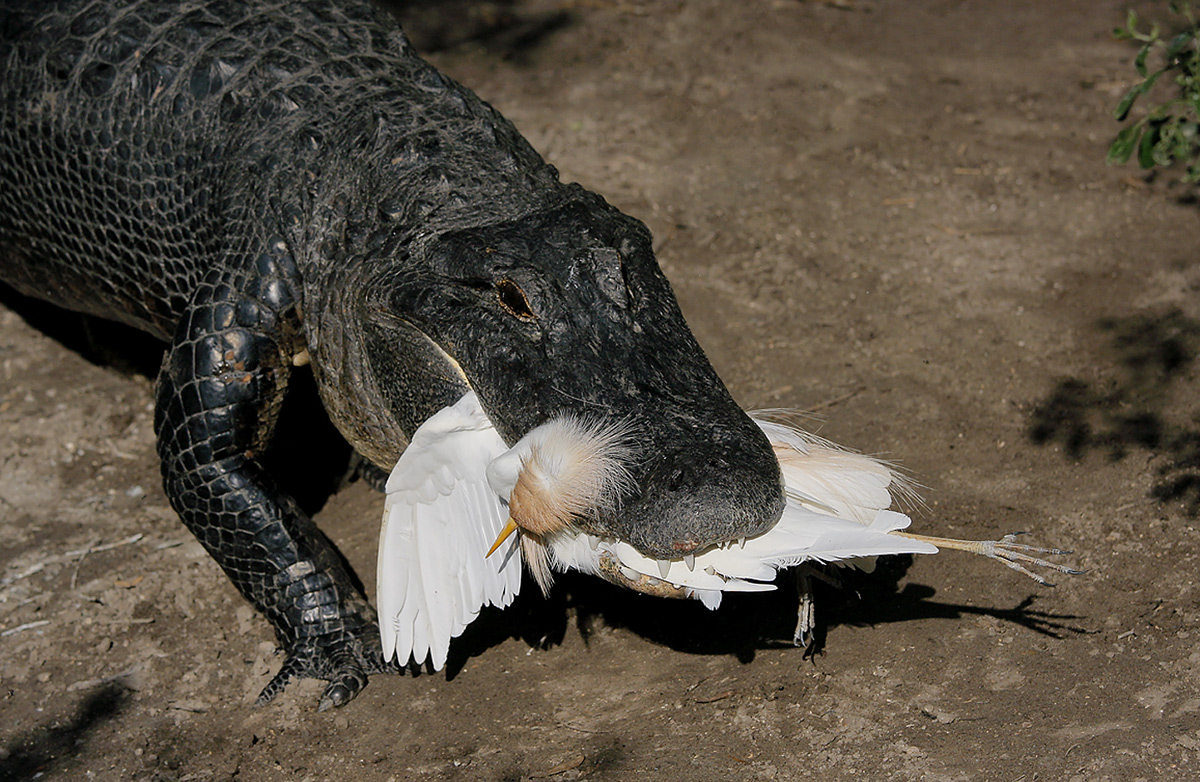
|
|
This American Alligator with a Cattle Egret in its jaws was photographed at the St. Augustine Alligator Farm with the Canon EF 70-200mm f/2.8L IS II USM lens (hand held at 111mm) and the EOS-40D (now replaced for me by the Canon EOS 5D Mark III Digital camera body ISO 400. Evaluative metering -1 stop as framed: 1/4000 sec. at f/5.6 in Av mode.
Central Sensor AI Servo shutter button AF as framed. Be sure to click on the image to enjoy a larger version.
When you have no clue as to what the situation might be, you are far better off being in Av mode than in Manual mode; you are never more than a few clicks away from the perfect exposure. See image next.
|
Av Mode
There are many situations where I find it best to work in Av mode. Most times when I am taking a walk with a long lens on my shoulder I set the camera to Av mode. If it is sunny, I set the ISO to 400. If it is cloudy, I set the ISO to 800. If it is cloudy dark I set the ISO to 800. I usually work wide open or close to it.
Why Av mode when taking a walk?
When I do not know what or where the subject might be and when I do not know if the subject will be in the sun or in the shade, I will always set Av mode so that I can quickly dial in something close to the correct EC and make an image or three. Note I: this is 100% dependent on having a thorough understanding of exposure. Note II: this same understanding is required to come up with the right exposure when working in Manual mode.
The classic example is as follows: I am at the St. Augustine Alligator Farm. I hear a woman scream. I have the 70-200 f/4L IS in my hands and start running. I see a big gator on the dirt in the sun with a Cattle Egret in its mouth. I instinctively dial in -1 stop EC as the gator is black and in the sun and taking up a good part of the frame and the egret is brilliant white. I make several images each with a good exposure. I see that the gator is heading under the boardwalk. I know that I will not need as much minus EC as the action will now be in the shade. I push the shutter button half-way and dial back to -1/3 stop with two counter-clockwise clicks of the thumb wheel. I make a few more images each with a perfect exposure.
|
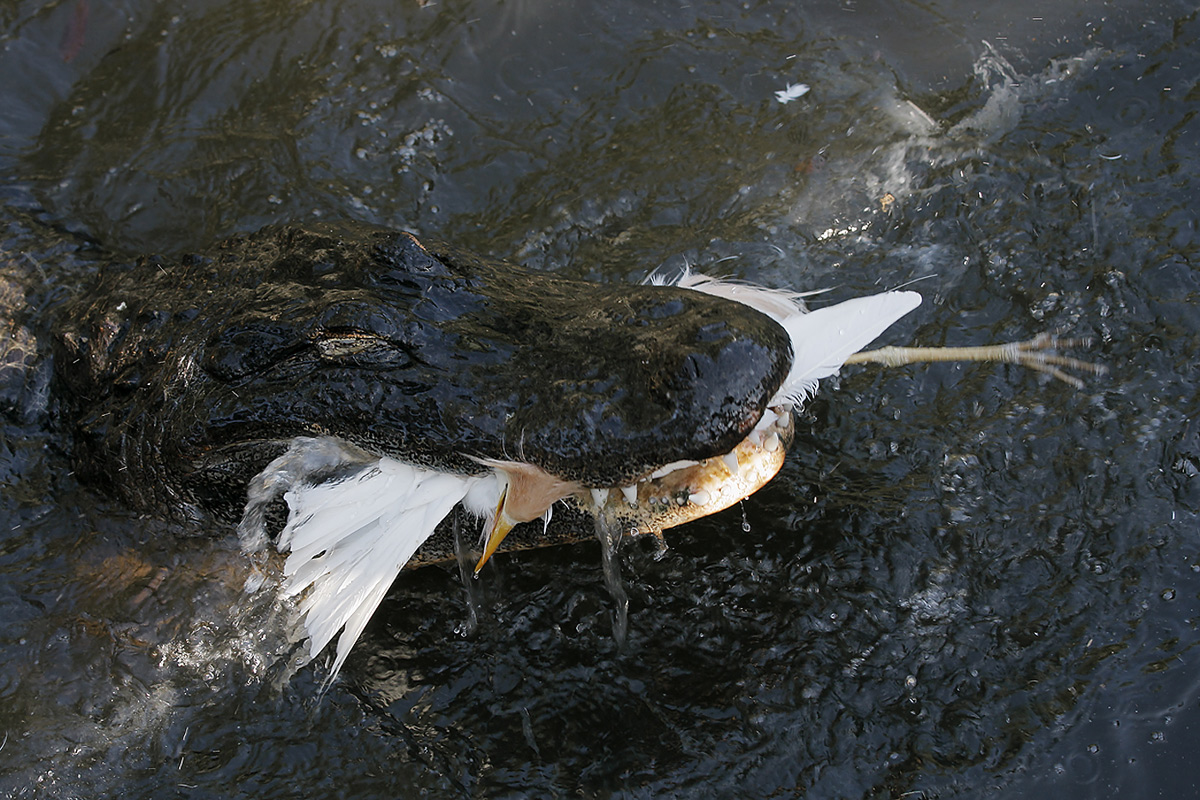
|
|
This same American Alligator with a Cattle Egret in its jaws was photographed at the St. Augustine Alligator Farm only a few seconds after the image above was created. Again, I used the Canon EF 70-200mm f/2.8L IS II USM lens (hand held at 70mm) and the EOS-40D (now replaced for me by the Canon EOS 5D Mark III Digital camera body ISO 400. Evaluative metering -1/3 stop as framed: 1/160 sec. at f/5.6 in Av mode.
Central Sensor AI Servo shutter button AF as framed. Be sure to click on the image to enjoy a larger version.
Had God been working in Manual mode not even he (or she) would have been able to make 14 the needed 14 clicks in the second it took this gator to slip from the bright sun into the shade of the boardwalk; if you are counting, that’s a difference of 4 2/3 stops….
|
If I had been working in Manual mode it would have taken 14 clicks of the shutter speed dial to come up with the right exposure. Nobody, not even the most obnoxious loud-mouthed Manual mode proponent could do quickly to get the right exposure when the gator slipped into the shadows.
While the above is an extreme situation it proves the point: when you are not sure what the situation will be Av mode is best. It allows you to come up with the right exposure quickly and easily, more quickly and easily than if you were working in Manual mode.
Similarly, as noted above in paragraph 3 in the Manual mode section, I often use Av mode when the light is changing and the background is of uniform and constant tonality.
Furthermore, if I happen to be in Av mode and I come upon a good situation where I am absolutely sure of the correct EC (exposure compensation) it is faster and easier to continue working in Av mode than it is to switch to Manual mode.
Av Mode Best for Flowers?
When photographing flowers in windless situations I also find Av mode best and more efficient than working in Manual mode. I found myself doing just that when photographing the tulips in Keukenhof Gardens, the Netherlands on last spring’s Tulip IPT.
I’d see and frame an image. Focus. Set Live View and the 2-second timer. Live View gave me mirror lock and the RAW RGB histogram. The 2-second timer assured sharp images at slow shutter speeds. Once I had fine-tuned the exposure I’d make a long series of images changing the aperture in one stop increments from wide open to f/22 or so. Once I had dialed in the right EC changing the aperture required only three clicks of the thumb wheel—the camera set the shutter speed each time. Had I been working in Manual mode I would have needed three clicks for the aperture and three more clicks the other way for the shutter speed. Where I come from six clicks is more work than three clicks. Working in Av mode made it fast and easy to crank out a series of images each with a different aperture….
Interestingly enough one image in a series would often stand out as clearly best.
Here is the principle that applies here: if the light and framing are constant and the only thing that you wish to change is the aperture it is faster and easier to work in Av mode. Can you do the same thing in Manual mode? Of course. But you will need to change more parameters than you would if you were working in Av mode. I prefer easier and faster 🙂
Tv Mode
As with Av mode, there are situations where working in Tv mode is far easier, far faster, far more intuitive, and far more efficient than working in Manual mode. For starters, one advantage of working in Tv mode is that it gives you absolute control of shutter speed.
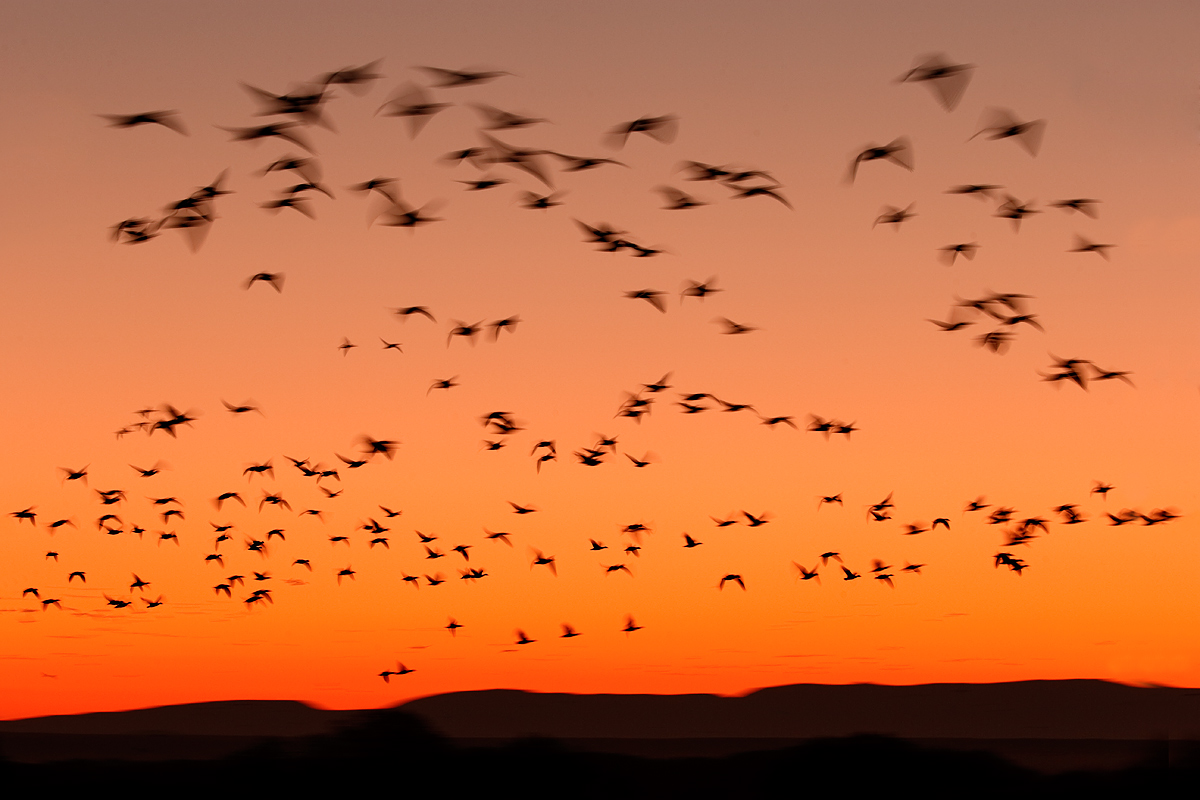
|
|
This Snow Geese fly-in image was created at 6:21am on the early morning of November 27, 2013 at Bosque del Apache NWR with the Gitzo 3532 LS carbon fiber tripod, the Mongoose M3.6 head, the Canon EF 200-400mm f/4L IS USM Lens with Internal 1.4x Extender (at 200mm) and the Canon EOS-1D X. ISO 400. Evaluative metering +1/3 stop as framed in Tv Mode: 1/13 sec. at f/8. Color temperature 8000K.
Tv mode +1/3 stop. ISO Safety shift. As described in the text below this is a simple recipe for creating pleasing blurs in the pre-dawn. Beginning and intermediate photographers would have a very tough time in situations like this if they were working in Manual mode.
Central sensor/AI Servo/Surround–Rear Focus AF as framed active at the moment of exposure. Click here to see the latest version of the Rear Focus Tutorial. Click on the image to see a larger version.
|
Tv Mode for Blurs
As regular readers know, I love creating pleasing blurs, often in pre-dawn situations with beautiful color in the sky. Trying to create sharp images in these situations is almost always a huge waste of your mega-high ISO time. Working in Tv mode in conjunction with either ISO Safety Shift or Auto ISO is the way to go. You simply pick a slow shutter speed that is appropriate for the EV (light) level and the distance to the birds, dial in the right EC—usually +1/3 stop to +2 stops depending on the colors and tonality of the predawn skies, and fire away. The camera will set the needed ISO. As it gets brighter, the only thing that you need to do is pick the shutter speed that you want and dial in the right EC.
Teaching this method in the dark at Bosque allows even beginning photographers to create some wonderful images on their very first try.
Folks working in Manual mode in this situation need to change the ISO, the shutter speed, and the aperture every minute or two as the skies brighten. This is relatively easy for experienced photographers but working in Tv mode as described above is much easier and much more efficient for many folks.
To learn more about creating pleasing blurs see “A Guide to Pleasing Blurs” by Denise Ippolito and yours truly. This PDF is sent via e-mail and would make a great gift for all aspiring photographers,
|
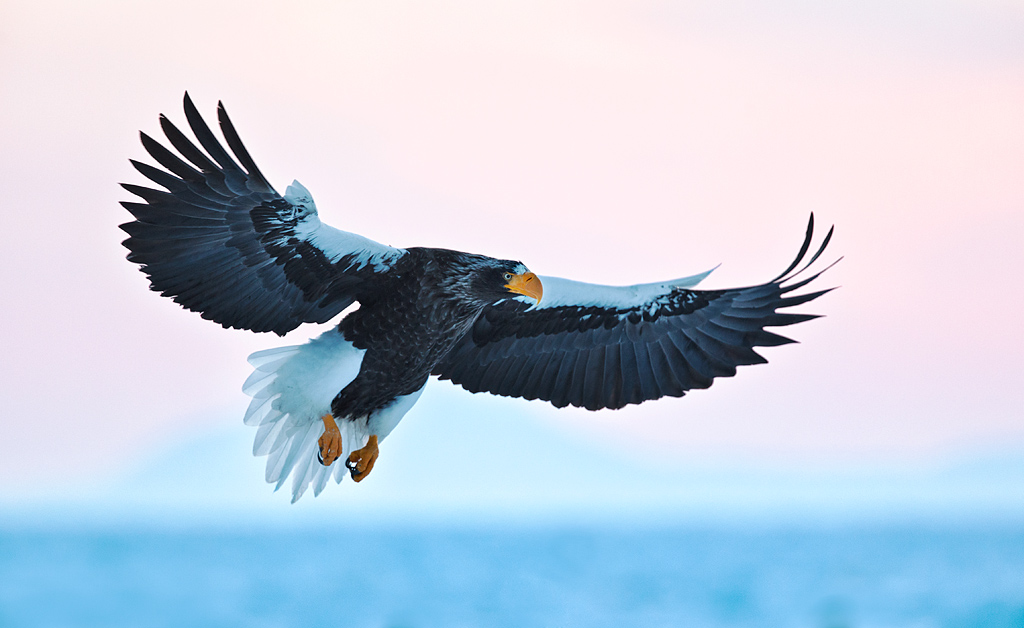
|
|
This Steller’s Sea Eagle image was created on my first Japan trip with the hand held Canon EF 300mm f/2.8L IS II USM lens, Canon 1.4x EF Extender III (Teleconverter), and the Canon EOS-1D X. ISO 500. Evaluative metering +1 stop stop as framed: 1/500 sec. at f/5.6 in Tv mode.
I knew that +1 was right and I knew that I wanted a shutter speed of 1/500 sec. Tv mode was fast, simple, and perfect.
Central sensor/AI Servo/Surround–Rear Focus AF as framed active at the moment of exposure. Click here to see the latest version of the Rear Focus Tutorial. Click on the image to see a larger version.
|
Tv Mode When You Need a Minimum Shutter Speed
There are many situations where you want to be sure of having a minimum shutter speed, often when working in relatively low light and often when working from some sort of water craft. Unlike many flight photographers I do not subscribe to the theory that you need a minimum shutter speed of 1/1600 sec for flight photography. In many situations I would rather work at 1/500 sec. than choose a higher ISO. I have made many sharp flight images at 1/500 second.
The single rejoinder is that the background be of fairly uniform tonality. If the tonality of the background is constantly changing then as above, it is imperative that you work in Manual mode.
On my last Japan trip we were working with Steller’s Sea Eagles in flight in pink pre-dawn light. Both the ice and the sky were of about the same tonality—light middle, and I knew that +1 EC would give me a pretty darned good exposure most of the time. So I set Tv mode and chose 1/500 sec. I dialed in +1 stop EC and let the camera set the ISO and determine the aperture (which would always be wide open or close to it). I created many fine images that morning. And I have done the same thing often on Galapagos trips in similar situations. Fast, simple, and easy.
Program Mode
“Program mode?” you ask. “Are you nuts?”
There are actually two situations when I find that program mode is the best mode. When photographing family parties or friends’ weddings indoors with on-camera flash, I get fairly consistent results by setting the flash to -1/3 or -2/3 stops, working in Program mode, and dialing in EC as required; usually some plus EC for overall light subjects and scenes and some minus EC for dark subjects with a few bright highlights. Happy birthday!
The other time that I’d use program mode is when photographing songbirds with flash in low, changing light. First, I simply dial in the flash exposure compensation (on the flash not on the camera), usually about -1 2/3 stops for fill flash, set my ISO, dial in the right EC (as always depending my understanding of exposure theory), and begin making images. After I am set up the only thing that I need to change is the exposure compensation. If you are working in Manual mode you will spend most of your time changing two or more of the exposure parameters as the light changes.
I have not photographed many songbirds in recent years but would not hesitate to work in program mode when the right situation arises. I should be so lucky.
Which is The Best Shooting Mode?
I am hoping that by now that everyone realizes that there is no single best shooting mode for all situations. Study hard and learn to get the right exposure in all lighting conditions. Learn to use each of your camera’s shooting modes. And learn when it is best for you to use Manual, Av, Tv, or even Program. You will become a much stronger photographer.




Reflections, and An Invitation
Those of you who missed my career celebration gallery in yesterday’s blog post may click here and then click on the gallery link to view it. Here’s the best news: after viewing the 120 images and picking your 5 or more favorites–most folks could not limit their choices to 5, you will not have to hit the back button 122 times
December 21st, 2013
Three Frosties
A Guest Blog Post by Andrew McLachlan
On the morning of December 14th, 2013 the temperature outside my home in south-central Ontario near the small town of Barrie was hovering around -26 degrees Celsius. That’s about -15 degrees Fahrenheit. That’s cold. When these frigid temperatures descend, my not-so-energy-efficient living room window becomes coated with a vast array of intricate frost patterns that often resemble etched glass. Each fall when I am preparing this window for the onset of winter I remove the screens entirely and store them in the shed out in the backyard. By doing so, I do not need to fiddle around with them in sub-zero temperatures when the frosties arrive.
Keeping the Frost Cold
Photographing frost patterns on window panes is not necessarily difficult, but making sense of the intricate patterns to create a pleasing image can, at times be a little challenging. I frame my compositions through the viewfinder and then activate the Live View function on the Nikon D800, zoom in on a section of frost, and manually fine-tune the focus. Then I turn off the Live View function and select the mirror-up feature. Next I trip the shutter once to raise the mirror and trip it a second time to take the photo. Please note that I frame and focus the images through a double pane window. When everything is set I open the inside window pane, make an image or two, and then shut the inside window. If I were to open the inside window first and perform the steps above, the warmer temperature inside the house would very quickly melt the frosty patterns away.
The lens that I used to create these iamge is the same AF-S NIKKOR 24–85mm f/3.5-4.5G ED VR lens that folks like to trash in their on-line reviews. As you can see by the images here, I do just fine with it. After temporarily rearranging the furniture, the two close-up views of the window frost, images #1 and #2, were created in the comfort of my living room, with the camera firmly mounted on a tripod. A cable release was used to trip the shutter.
The Pine Tree Reflection: Brrrr!
The vertical image above with the pine tree in the background was created hand held from outside my home looking back at the window with the 24–85mm’s Vibration Reduction feature turned on. The pine tree is a reflection.
The over-cast conditions gave a black and white appearance to the resulting images. To optimize each image minor adjustments were made during the Adobe Camera Raw (ACR) conversion. A bit of Detail Extractor from Nik Color Efex Pro was applied. All but the spruce tree reflection image (a slight crop) were straight out of the camera.
artie’s Comments
When I saw these fine images on Andrew’s blog I asked him immediately if he would like to go a guest blog post. He said yes. You can see more of Andrew’s fine work on his website here. Andrew is the author of A Photographer’s Guide To The Ontario Landscape, a great BAA eGuide. And along with Denise Ippolito and yours truly he is a co-creator of Fractastic,, another great eGuide the details the creative uses of the Reddfield Fractalius filter. Click here to learn more about or purchase Fractalius.
Andrew makes an important point about photographing patterns: you need to consider the shapes and lines carefully when designing the image. Just pointing and shooting just does not cut it no matter how amazing the patterns and the details. Andrew did a great job of framing each of the three images here.
I love that Andrew has made lots of great images with a lens that is routinely trashed by the internet experts. According to those knowledgeable folks none of my Canon lenses are sharp, none of my cameras are capable of focusing accurately, and it is not possible to create a sharp image with any teleconverter. You gotta love it.
Notice that Andrew was working in Av mode. In tomorrow’s killer educational blog post I lay waste to the myth that real photographers work in Manual mode all the time. Coming soon: “Manual… Av… Tv… Program… Which is The Best Shooting Mode?”
Image Questions
Why did Andrew go from ISO 100 to ISO 800 to create the last image?
Both Andrew and I feel that one of these three images is the strongest. Which one do you think is the best? Be sure to let us know why.
Reflections, and An Invitation
Those of you who missed my career celebration gallery in yesterday’s blog post may click here and then click on the gallery link to view it. Here’s the best news: after viewing the 120 images and picking your 5 or more favorites–most folks could not limit their choices to 5, you will not have to hit the back button 122 times to get back to the blog:). You will simply be able to click on the tab to the left of the slide program tab.
Thanks to those who pointed out the two doubles. They have been replaced. That means that there are 2 new images. Folks with eagle eyes and photographic memories may leave a comment here if they can identify one or both of the new images.
|

|
|
Join me in San Diego for three great days of photography and learning. Click on the image to better enjoy a larger version.
|
The San Diego Short-Notice Small Group IPT. January 15-17, 3-Full Days: $1049. Meet and Greet after dinner on your own at 7:30pm on Tuesday, January 14, 2014. Limit 6/Openings: 1.
We will get to photograph the California race of Brown Pelican in flight, resting, preening, cleaning their bill pouches, and talking to their neighbors by tossing their bills high in the air. The afternoon sessions will feature Marbled Godwits, several gull species, and Wood and Ring-necked Ducks. If we have a cloudy morning we will get to photograph Harbor Seals. You will learn to get the right exposure every time, to see the best situation, to think like a pro, to create sharp, pleasing images, and to understand the joint effects of light and wind on the birds. All in a small group with tons of individual attention.
A $500 non-refundable deposit is required to hold your slot for this IPT. Your balance will be due no later than January 7, 2014. The balance is alo non-refundable. If the trip fills, we will be glad to apply a credit applicable to a future IPT for the full amount less a $100 processing fee. If we do not receive your check for the balance on or before the due date we will try to fill your spot from the waiting list. If your spot is filled, you will lose your deposit. If not, you can secure your spot by paying your balance.
If you are planning to register please shoot me an e-mail.
Then please print, complete, and sign the form that is linked to here and shoot it to us along with your deposit check (made out to “Arthur Morris.”) Though we prefer a check, you can also leave your deposit with a credit card by calling the office at 863-692-0906. If you register by phone, please print, complete and sign the form as noted above and either mail it to us or e-mail the scan.
If you have any questions, please feel free to contact me via e-mail
San Diego Site Guide
Can’t make the IPT? Get yourself a copy of the San Diego Site Guide; it’s the next best thing to being on an IPT. Nearly 30 years of San Diego bird photography revealed in one fell swoop.
IPT Info
Many of our great trips are filling up. You will learn more about how to make great images on a BAA IPT than anywhere else on the planet. Click here for info on the Anhinga Trail IPT. Click here for info on the Estero Lagoon IPT. Click here for info on the just announced San Diego Short Notice IPT–only 2 slots left on that one. And click here to learn about the just-announced 2014 Bosque IPTs. You will find additional IPTs and general info here.
Great Buy: Used Canon 800mm f/5/6L IS Lens for Sale
Friend and multiple IPT-veteran Monte Brown is offering his lightly used Canon 800mm f/5.6L IS lens in excellent condition for sale for $9,500. Purchase includes the lens case and hood, the 4th Generation Design Low Foot, the original foot, a LensCoat, the original invoice and the original Canon shipping carton. The lens was purchased new from B&H in April 2009 and was recently underwent a pre-sale clean and check by Canon. The buyer pays insured shipping via UPS Ground to US addresses only. The lens will be shipped only after your check clears.
The Canon EF 800mm f/5.6L IS USM Autofocus lens sells new for $13,223.00 so you will save a bundle on a great lens. No need to ever use a 2X…
If interested you can contact Monte by phone at 1-765-744-1421 or via e-mail.
Last Year’s Grand Prize winning image by Lou Coetzer
Time is Running Out!
BIRDS AS ART 2nd International Bird Photography Competition
The December 31, 2013 closing deadline is fast approaching.
Learn more and enter the BIRDS AS ART 2nd International Bird Photography Competition here. Twenty-five great prizes including the $1000 Grand Prize and intense competition. Bring your best.
Support the BAA Blog. Support the BAA Bulletins: Shop B&H here!
We want and need to keep providing you with the latest free information, photography and Photoshop lessons, and all manner of related information. Show your appreciation by making your purchases immediately after clicking on any of our B&H or Amazon Affiliate links in this blog post. Remember, B&H ain’t just photography!




Amazon
Everyone buys something from Amazon, be it a big lens or deodorant. Support the blog by starting your search by clicking on the logo-link below. No purchase is too small to be appreciated; they all add up. Why make it a habit? Because I make it a habit of bringing you new images and information on an almost daily basis.
Typos
In all blog posts and Bulletins feel free to e-mail or leave a comment regarding any typos, wrong words, misspellings, omissions, or grammatical errors. Just be right. 🙂
December 20th, 2013
Red-crowned Crane Image–Need Your Help/Opinion
Do you like the pano crop above (Image #1) with room behind the right hand bird or the more traditional 3X2 crop below (Image #2)? Or something in between?
Do you like the more contrasty image above (Image #1) or the softer, less contrasty image below (Image #2)? Or something in between?
Do you like the richer colors above (Image #1) or the more muted colors below (Image #2)? Or something in between?
|
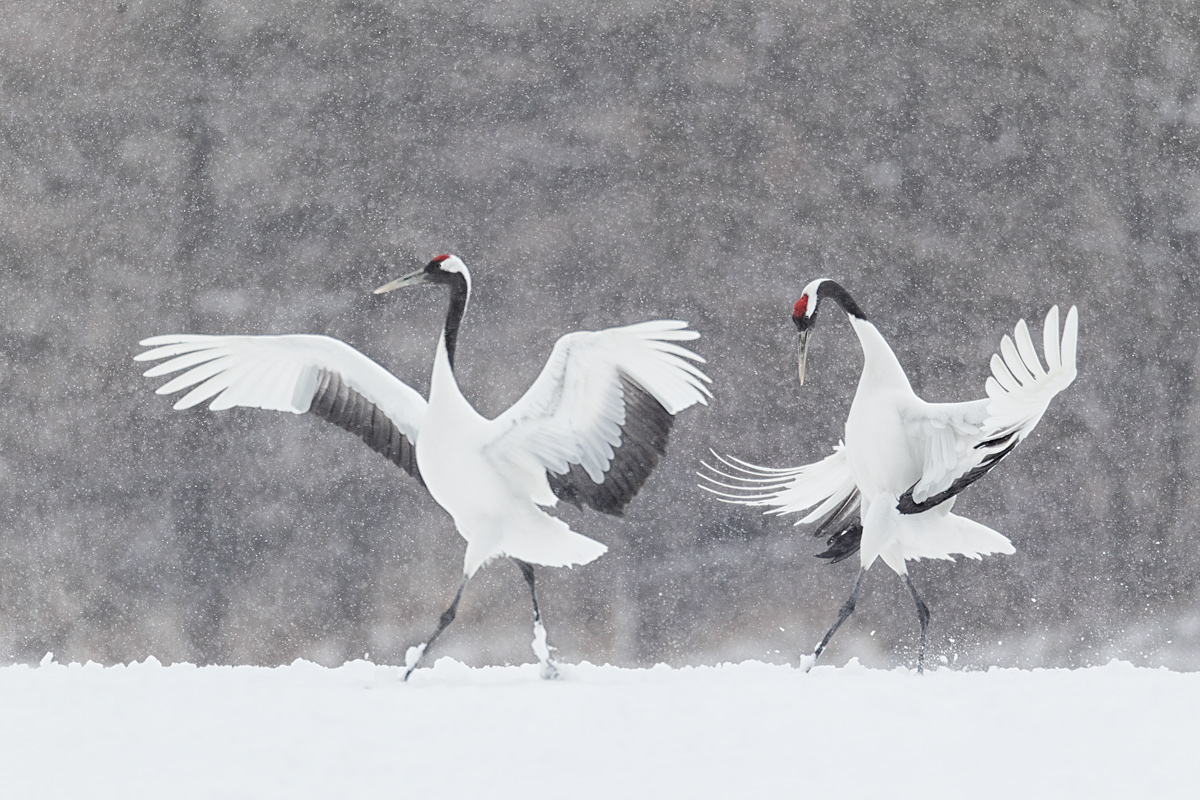
|
|
This is the same image re-converted in DPP and then optimized in a different fashion. To learn why I now convert all of my images in Canon Digital Photo Professional click here.
Image #2
|
Little Estero Lagoon
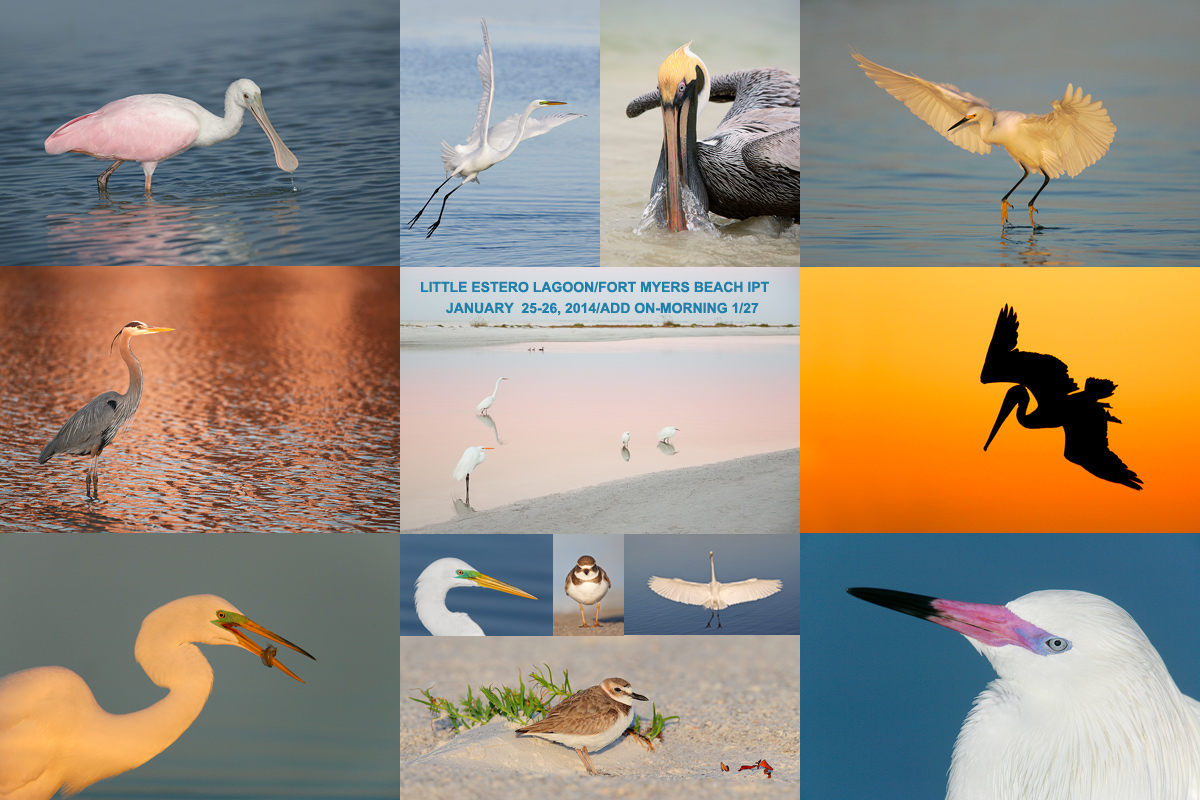
|
|
Join us to learn the ins and outs of Little Estero Lagoon.
|
Little Estero Lagoon IPT: 2 full days–Sat/Sun: JAN 25-26 (Limit 14/Openings 12): $799. Introductory slide program: 7pm, FRI, JAN 24, 2014
Join Denise Ippolito and Arthur Morris for four great photography sessions at one of the top bird photography hotspots in North America. Morning sessions: 6:15am to 10:30am. Afternoon sessions: 3:00pm till 5:45pm. Lunch included. Informal image review and Photoshop sessions after lunch. Call 863-292-0906 to registger; payment if full is now due so call with your credit card in hand. Please e-mail with any questions.
What you will learn:
When to be where and where to be when at Little Estero Lagoon to maximize the photographic opportunities.
Autofocus basics and correct camera and gear set-up.
How to get the right exposure with digital every time.
How and why to expose to the right.
How to create pre-dawn silhouettes.
How to design pleasing images.
How to find the best perspective.
How to make strong images in cluttered situations.
How to photography birds in flight.
In-the-Field creative techniques.
Monday: Jan 27: Optional Estero Add-on/morning only (Limit 14/Openings 12): $249
Adding the last morning as above is optional.
Do consider joining us for the all or part of the South Florida Composite IPT:
2014 South Florida Composite IPT: 6 1/2 days of photography spread over 9 days of learning, hanging out, and travel: $2644. (Limit 14/Openings: 12
Click here for complete details or to register. Please e-mail with any questions or leave a comment below.
Last Year’s Grand Prize winning image by Lou Coetzer
Time is Running Out!
BIRDS AS ART 2nd International Bird Photography Competition
The December 31, 2013 closing deadline is fast approaching.
Learn more and enter the BIRDS AS ART 2nd International Bird Photography Competition here. Twenty-five great prizes including the $1000 Grand Prize and intense competition. Bring your best.
Support the BAA Blog. Support the BAA Bulletins: Shop B&H here!
We want and need to keep providing you with the latest free information, photography and Photoshop lessons, and all manner of related information. Show your appreciation by making your purchases immediately after clicking on any of our B&H or Amazon Affiliate links in this blog post. Remember, B&H ain’t just photography!




Amazon
Everyone buys something from Amazon, be it a big lens or deodorant. Support the blog by starting your search by clicking on the logo-link below. No purchase is too small to be appreciated; they all add up. Why make it a habit? Because I make it a habit of bringing you new images and information on an almost daily basis.
Typos
In all blog posts and Bulletins feel free to e-mail or leave a comment regarding any typos, wrong words, misspellings, omissions, or grammatical errors. Just be right. 🙂
IPT Info
Many of our great trips are filling up. You will learn more about how to make great images on a BAA IPT than anywhere else on the planet. Click here for the schedule and additional info.
December 19th, 2013 Blog/Bulletin Browser Changes
Up until this afternoon, when you followed a link on the blog or in the Bulletins, the link was opened in the window you were working in; you were taken away from the blog. To get back to the blog you needed to hit the Back Button. Thanks to Denise Ippolito for pointing out a problem that involved getting back to the blog after viewing yesterday’s slide program. And thanks to Peter Kes for implementing the following change: when you click on a link, be it to see a gallery as many of you did yesterday, or to make a B&H or Amazon purchase, the new web page will open in a new tab. To get back to the blog just click on the tab to the left of the new tab. This should be much more convenient for the vast majority of you. Note: if you follow a link to another blog post that post will appear in the same tab. Simply hit the Back button to get back to the original blog post.
Amazing
There is lots of amazing stuff going on today at BIRDS AS ART.
After 14 straight days of swimming every day in my lap pool, I took today off. Amazing.
I will be taking my 15th straight ice bath at about 6:00pm today: I am up to 45 minutes in 58 degree F water. 🙂
The just-announced-the-other-day San Diego Short Notice IPT is nearly sold out. Just one spot left. See below for details. Amazing.
After promising to do so more than a year ago, I will be working on a post that will let you know when I use Manual mode, when I use Av mode, when I use Tv mode, and gasp–when I use Program mode. I hope to publish it no later than Monday.
Reflections, and An Invitation
Those of you who missed my career celebration gallery in yesterday’s blog post may click here and then click on the gallery link to view it. Here’s the best news: after viewing the 120 images and picking your 5 or more favorites–most folks could not limit their choices to 5, you will not have to hit the back button 122 times to get back to the blog:). You will simply be able to click on the tab to the left of the slide program tab.
Thanks to those who pointed out the two doubles. They have been replaced. That means that there are 2 new images. Folks with eagle eyes and photographic memories may leave a comment here if they can identify one or both of the new images.
|

|
|
Join me in San Diego for three great days of photography and learning. Click on the image to better enjoy a larger version.
|
Announcing the San Diego Short-Notice Small Group IPT. January 15-17, 3-Full Days: $1049. Meet and Greet after dinner on your own at 7:30pm on Tuesday, January 14, 2014. Limit 6/Openings: 1.
We will get to photograph the California race of Brown Pelican in flight, resting, preening, cleaning their bill pouches, and talking to their neighbors by tossing their bills high in the air. The afternoon sessions will feature Marbled Godwits, several gull species, and Wood and Ring-necked Ducks. If we have a cloudy morning we will get to photograph Harbor Seals. You will learn to get the right exposure every time, to see the best situation, to think like a pro, to create sharp, pleasing images, and to understand the joint effects of light and wind on the birds. All in a small group with tons of individual attention.
A $500 non-refundable deposit is required to hold your slot for this IPT. Your balance will be due no later than January 7, 2014. The balance is alo non-refundable. If the trip fills, we will be glad to apply a credit applicable to a future IPT for the full amount less a $100 processing fee. If we do not receive your check for the balance on or before the due date we will try to fill your spot from the waiting list. If your spot is filled, you will lose your deposit. If not, you can secure your spot by paying your balance.
If you are planning to register please shoot me an e-mail.
Then please print, complete, and sign the form that is linked to here and shoot it to us along with your deposit check (made out to “Arthur Morris.”) Though we prefer a check, you can also leave your deposit with a credit card by calling the office at 863-692-0906. If you register by phone, please print, complete and sign the form as noted above and either mail it to us or e-mail the scan.
If you have any questions, please feel free to contact me via e-mail
San Diego Site Guide
Can’t make the IPT? Get yourself a copy of the San Diego Site Guide; it’s the next best thing to being on an IPT. Nearly 30 years of San Diego bird photography revealed in one fell swoop.
IPT Info
Many of our great trips are filling up. You will learn more about how to make great images on a BAA IPT than anywhere else on the planet. Click here for info on the Anhinga Trail IPT. Click here for info on the Estero Lagoon IPT. Click here for info on the just announced San Diego Short Notice IPT–only 2 slots left on that one. And click here to learn about the just-announced 2014 Bosque IPTs. You will find additional IPTs and general info here.
Great Buy: Used Canon 800mm f/5/6L IS Lens for Sale
Friend and multiple IPT-veteran Monte Brown is offering his lightly used Canon 800mm f/5.6L IS lens in excellent condition for sale for $9,500. Purchase includes the lens case and hood, the 4th Generation Design Low Foot, the original foot, a LensCoat, the original invoice and the original Canon shipping carton. The lens was purchased new from B&H in April 2009 and was recently underwent a pre-sale clean and check by Canon. The buyer pays insured shipping via UPS Ground to US addresses only. The lens will be shipped only after your check clears.
The Canon EF 800mm f/5.6L IS USM Autofocus lens sells new for $13,223.00 so you will save a bundle on a great lens. No need to ever use a 2X…
If interested you can contact Monte by phone at 1-765-744-1421 or via e-mail.
Last Year’s Grand Prize winning image by Lou Coetzer
Time is Running Out!
BIRDS AS ART 2nd International Bird Photography Competition
The December 31, 2013 closing deadline is fast approaching.
Learn more and enter the BIRDS AS ART 2nd International Bird Photography Competition here. Twenty-five great prizes including the $1000 Grand Prize and intense competition. Bring your best.
Support the BAA Blog. Support the BAA Bulletins: Shop B&H here!
We want and need to keep providing you with the latest free information, photography and Photoshop lessons, and all manner of related information. Show your appreciation by making your purchases immediately after clicking on any of our B&H or Amazon Affiliate links in this blog post. Remember, B&H ain’t just photography!




Amazon
Everyone buys something from Amazon, be it a big lens or deodorant. Support the blog by starting your search by clicking on the logo-link below. No purchase is too small to be appreciated; they all add up. Why make it a habit? Because I make it a habit of bringing you new images and information on an almost daily basis.
Typos
In all blog posts and Bulletins feel free to e-mail or leave a comment regarding any typos, wrong words, misspellings, omissions, or grammatical errors. Just be right. 🙂
December 18th, 2013
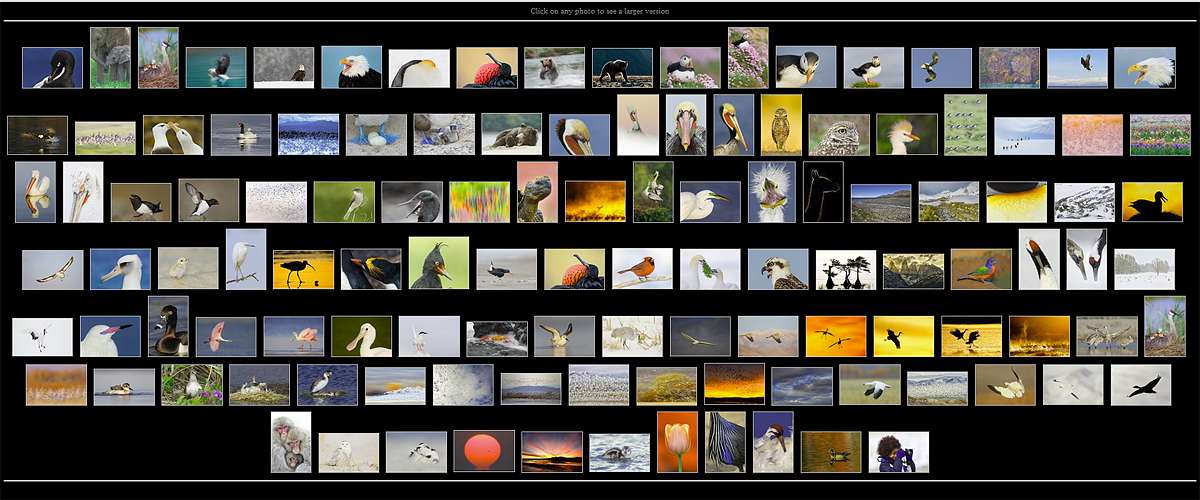
|
|
The thumbnails in the screen capture above represent the last two decades of what has been an amazing career. Click here to see the BreezeBrowswer-created slide show. But see “Invitation” below for complete details. Click on the image for a better look at the thumbnails.
|
Reflections
Whenever I am looking at one of the many large Images for Slide Programs folders I am amazed. What a wonderful life and career I have had. And will continue to have. The places that I have visited. The birds and wildlife that I have seen. Wow! How blessed I have been.
Folks often ask, “Don’t you get tired of waking up in a motel room bed 180 mornings each year?” I chuckle when I hear that. Why? If I did not like all the travel I would simply stay home.
An Invitation…
All are invited to click on the gallery link here. I picked 120 of my all-time favorite images for a Canon project entitled “DreamLabo 5000.” To view the slide program simply click on the first image and then hit Next (above the image). Enjoy. All comments are welcome. If you would like to have some fun and help me out a bit, take the time to pick your five favorite images. You will find the file name as well as all the EXIF date below and to the left of each image. You can learn a lot by checking out the EXIF data for each digital image. There are very few film images in the slide program. Then cut and paste the file name without the number into your comment box. Each file name should look something like this: Northern Gannet male bringing nesting material to mate.
Image Questions?
If you have questions about an image or two feel free to ask them by leaving a comment. Please indicate the image you are referring to with the file name as described above.
BreezeBrowser Slide Program Feature
The HTML for the slide show linked to here was created in BreezeBrowser via Tools/HTML in about 2 minutes. It is a little-known and little used feature that works extraordinarily well. Regular readers know that I use and depend on BreezeBrowser every day of the year. It allows me to sort my keepers and deletes the rejects faster than any other Windows browsing program. We use it on the main computer in the home office to catalog our images file-drawer style. And the companion program, Downloader Pro allows me to download my images quickly and conveniently. It automatically adds my IPTC data and the shooting location. I have it set up to create a folder named by the Month/date/year. The Breezebrowser/Downloader Pro combo saves me many hours each week. To learn earn more or to purchase this great PC only program, click here. As far as the BreezeBrowser/Downloader Pro Combo goes, if you are using a Windows platform and are not using these two great programs you are at best, wasting your valuable time. My understanding is that Photo Mechanic is best for Mac-users.
IPT Info
Many of our great trips are filling up. You will learn more about how to make great images on a BAA IPT than anywhere else on the planet. Click here for info on the Anhinga Trail IPT. Click here for info on the Estero Lagoon IPT. Click here for info on the just announced San Diego Short Notice IPT–only 2 slots left on that one. And click here to learn about the just-announced 2014 Bosque IPTs. You will find additional IPTs and general info here.
Great Buy: Used Canon 800mm f/5/6L IS Lens for Sale
Friend and multiple IPT-veteran Monte Brown is offering his lightly used Canon 800mm f/5.6L IS lens in excellent condition for sale for $9,500. Purchase includes the lens case and hood, the 4th Generation Design Low Foot, the original foot, a LensCoat, the original invoice and the original Canon shipping carton. The lens was purchased new from B&H in April 2009 and was recently underwent a pre-sale clean and check by Canon. The buyer pays insured shipping via UPS Ground to US addresses only. The lens will be shipped only after your check clears.
The Canon EF 800mm f/5.6L IS USM Autofocus lens sells new for $13,223.00 so you will save a bundle on a great lens. No need to ever use a 2X…
If interested you can contact Monte by phone at 1-765-744-1421 or via e-mail.
Last Year’s Grand Prize winning image by Lou Coetzer
Time is Running Out!
BIRDS AS ART 2nd International Bird Photography Competition
The December 31, 2013 closing deadline is fast approaching.
Learn more and enter the BIRDS AS ART 2nd International Bird Photography Competition here. Twenty-five great prizes including the $1000 Grand Prize and intense competition. Bring your best.
Support the BAA Blog. Support the BAA Bulletins: Shop B&H here!
We want and need to keep providing you with the latest free information, photography and Photoshop lessons, and all manner of related information. Show your appreciation by making your purchases immediately after clicking on any of our B&H or Amazon Affiliate links in this blog post. Remember, B&H ain’t just photography!




Amazon
Everyone buys something from Amazon, be it a big lens or deodorant. Support the blog by starting your search by clicking on the logo-link below. No purchase is too small to be appreciated; they all add up. Why make it a habit? Because I make it a habit of bringing you new images and information on an almost daily basis.
Typos
In all blog posts and Bulletins feel free to e-mail or leave a comment regarding any typos, wrong words, misspellings, omissions, or grammatical errors. Just be right. 🙂
December 17th, 2013
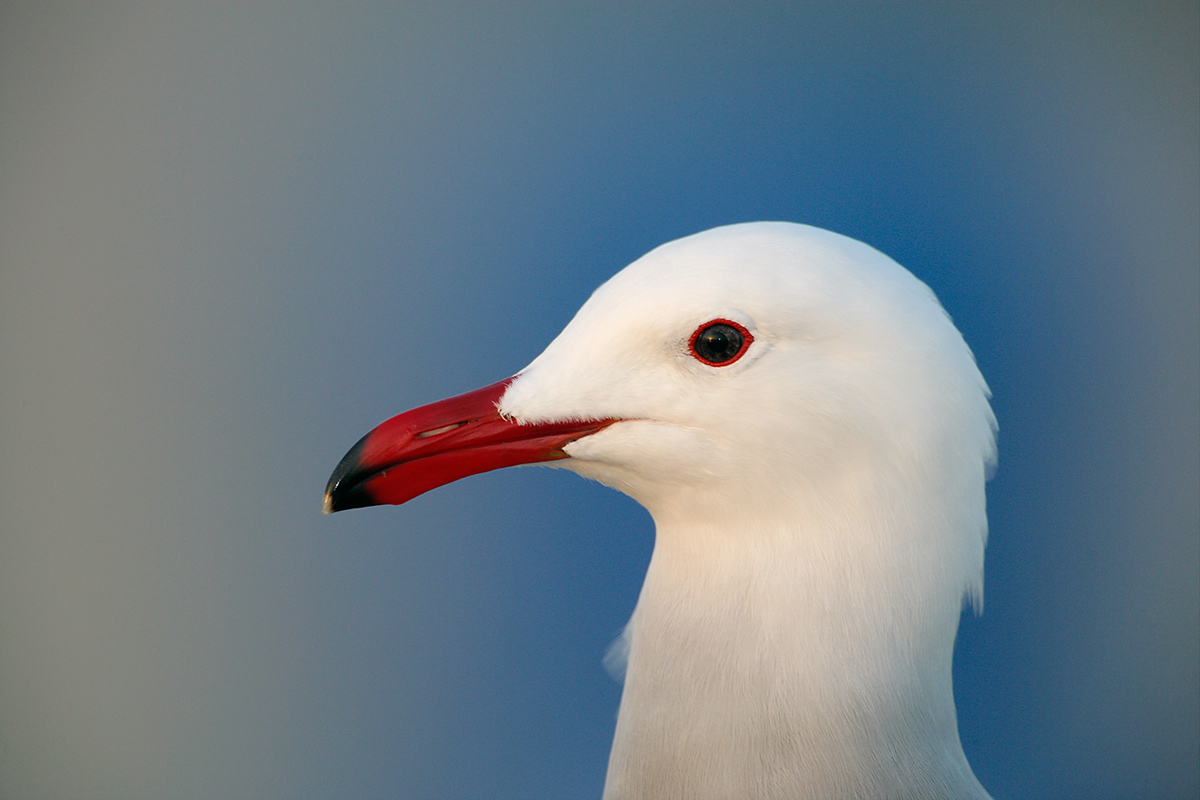
|
|
This head portrait of a breeding plumage Heerman’s Gull was created with the predecessor of the Gitzo 3532 LS carbon fiber tripod, the Mongoose M3.6 head, the 500mm f/4L IS lens (now replaced by the Canon EF 500mm f/4L IS II USM lens), the 2X II TC (now replaced by the Canon 2x EF Extender III (Teleconverter))), and the EOS-1Ds Mark II (now replaced by the Canon EOS-1D X). ISO 400. Evaluative metering +1/3 stop: 1/100 sec. at f/9 in Av mode. Color Temperature: Cloudy.
Central sensor/AI Servo Rear Focus AF as framed active at the moment of exposure. Click here to see the latest version of the Rear Focus Tutorial. Click on the image to see a larger version.
Breeding plumage Heerman’s Gulls will be fairly easy subjects on the Short Notice Small Group San Diego IPT. See below for details.
|
What Garbage Can?
Before you read on, do you see the garbage can in the image above?
Watch a good nature photographer. See how long they remain in one spot without moving their tripod. Unless they are staying on one spot doing flight photography they will be moving a lot. At the Venice Rookery it is not uncommon to see photographers who set their tripods down in a good location at 7am and do not move it for 3 or 4 hours. In that time a good photographer will have moved their tripod between 50 and 500 times. Sometimes these moves are of an inch or two, to hide a bright twig behind the subject. At other times they might move their tripod anywhere from 1 foot to 100 yards to get on light angle (have their shadow pointing at the subject), to be in the right spot considering the wind direction or intensity, or as mentioned above, to get a better perspective that will yield a cleaner background.
The image above was created on a San Diego IPT at one of my favorite afternoon spots. In some years the folks who clean the beach create berms of sand about 3 feet high. We toss bread onto the top of the sand ridges for the Heerman’s, Western, and Ring-billed Gulls that frequent the beach there. We had lots of handsome birds lined up on the ridge and folks were easily getting close enough to create head portraits with a telephoto lens and a teleconverter. As you can see above it was late in the day; the light was sweet. And the distant beach in the background was in shade thus the lovely grey background that you see in front of the bird.
Moving left and right I picked off attractive subjects one after another with the old 500 and the 1.4X II TC when I saw a unique opportunity. I switched to the 2X TC, moved well to my right, and created a short series of images before the handsome gull flew off. I quickly got back to the group to share my prize. Reaction was uniform across the board: “Where did you get that beautiful blue in the background? Our backgrounds are nice with that shaded slate grey but yours is amazing. I said, “It’s right there in front of you. Just look.” More of the same: “There’s no blue anywhere!”
Then I pointed about fifty yards to our right at a large, squat blue plastic trash receptacle….
By carefully, and I mean very carefully, positioning my tripod I was able to center the gull’s head against the out-of-focus blue of the hard plastic garbage can. Understand that if my tripod has been placed as little as a half-inch to either side that the image would not have been as strong. Once I explained things to the group we put some more bread on the berm and folks went to work with their newly found blue background.
Here’s the principle: always choose your perspective carefully to create the cleanest, boldest images possible. BTW, I love the American Flag color scheme of today’s image.
|

|
|
Join me in San Diego for three great days of photography and learning. Click on the image to better enjoy a larger version.
|
Pelican Paradise
LaJolla, California is a pelican paradise. At the right time of year, most will be sporting their incredibly beautiful breeding plumage of white and yellow and deep chocolate brown. But it is the olive green and bright red bill pouches that grabs you by the throat and never lets go. One of my LaJolla film images was honored in the BBC Wildlife Photographer of the Year Competitions. Today, I still don’t have enough pelican images. I’d love to make another BBC-worthy photograph on my upcoming trip. I hope that you can join me in the quest. See below for details.
I’ve been away from LaJolla for too long. I visited San Diego for photography (and until 2007, to visit my folks who lived in North
park; my war hero Dad died in 2001) every year for almost three decades. My Mom, now 91 and living in Holbrook, Long Island, NY, lived in San Diego until seven years ago. Whenever I walked into my parent’s home on Pentuckett Avenue the same conversation would take place:
Hazel Louise Morris: What are you gonna do tomorrow?
Arthur Edward Morris: Ma, you know what I am gonna do tomorrow.
HLM: What are you gonna do tomorrow?
AEM: Ma, I’m going to LaJolla bright and early.
HLM: What are you gonna do there?
AEM: Ma, you know what I am gonna do.
HLM: What are you gonna do there?
AEM: Ma, I’m going to photograph those beautiful pelicans.
HLM: Don’t you have enough pelican pictures alreadY?
AEM: No Ma.
Announcing the San Diego Short-Notice Small Group IPT. January 15-17, 3-Full Days: $1049. Meet and Greet after dinner on your own at 7:30pm on Tuesday, January 14, 2014. Limit 6.
We will get to photograph the California race of Brown Pelican in flight, resting, preening, cleaning their bill pouches, and talking to their neighbors by tossing their bills high in the air. The afternoon sessions will feature Marbled Godwits, several gull species, and Wood and Ring-necked Ducks. If we have a cloudy morning we will get to photograph Harbor Seals. You will learn to get the right exposure every time, to see the best situation, to think like a pro, to create sharp, pleasing images, and to understand the joint effects of light and wind on the birds. All in a small group with tons of individual attention.
A $500 non-refundable deposit is required to hold your slot for this IPT. Your balance will be due no later than January 7, 2014. The balance is alo non-refundable. If the trip fills, we will be glad to apply a credit applicable to a future IPT for the full amount less a $100 processing fee. If we do not receive your check for the balance on or before the due date we will try to fill your spot from the waiting list. If your spot is filled, you will lose your deposit. If not, you can secure your spot by paying your balance.
If you are planning to register please shoot me an e-mail.
Then please print, complete, and sign the form that is linked to here and shoot it to us along with your deposit check (made out to “Arthur Morris.”) Though we prefer a check, you can also leave your deposit with a credit card by calling the office at 863-692-0906. If you register by phone, please print, complete and sign the form as noted above and either mail it to us or e-mail the scan.
If you have any questions, please feel free to contact me via e-mail
San Diego Site Guide
Can’t make the IPT? Get yourself a copy of the San Diego Site Guide; it’s the next best thing to being on an IPT. Nearly 30 years of San Diego bird photography secrets revealed in one fell swoop.
Great buy: Used Canon 800mm f/5/6L IS Lens for Sale
Friend and multiple IPT-veteran Monte Brown is offering his lightly used Canon 800mm f/5.6L IS lens in excellent condition for sale for $9,500. Purchase includes the lens case and hood, the 4th Generation Design Low Foot, the original foot, a LensCoat, the original invoice and the original Canon shipping carton. The lens was purchased new from B&H in April 2009 and was recently underwent a pre-sale clean and check by Canon. The buyer pays insured shipping via UPS Ground to US addresses only. The lens will be shipped only after your check clears.
The Canon EF 800mm f/5.6L IS USM Autofocus lens sells new for $13,223.00 so you will save a bundle on a great lens. No need to ever use a 2X…
If interested you can contact Monte by phone at 1-765-744-1421 or via e-mail.
Last Year’s Grand Prize winning image by Lou Coetzer
Time is Running Out!
BIRDS AS ART 2nd International Bird Photography Competition
The December 31, 2013 closing deadline is fast approaching.
Learn more and enter the BIRDS AS ART 2nd International Bird Photography Competition here. Twenty-five great prizes including the $1000 Grand Prize and intense competition. Bring your best.
Support the BAA Blog. Support the BAA Bulletins: Shop B&H here!
We want and need to keep providing you with the latest free information, photography and Photoshop lessons, and all manner of related information. Show your appreciation by making your purchases immediately after clicking on any of our B&H or Amazon Affiliate links in this blog post. Remember, B&H ain’t just photography!




Amazon
Everyone buys something from Amazon, be it a big lens or deodorant. Support the blog by starting your search by clicking on the logo-link below. No purchase is too small to be appreciated; they all add up. Why make it a habit? Because I make it a habit of bringing you new images and information on an almost daily basis.
Typos
In all blog posts and Bulletins feel free to e-mail or leave a comment regarding any typos, wrong words, misspellings, omissions, or grammatical errors. Just be right. 🙂
IPT Info
Many of our great trips are filling up. You will learn more about how to make great images on a BAA IPT than anywhere else on the planet. Click here to learn about the just-announced 2014 Bosque IPTs. And click here for the schedule and additional info.
December 16th, 2013
You Should Be So Lucky
On the first morning of the first day of the 2006 “President’s Week Southwest Florida IPT this bird flew in and landed nearby on a foggy bright morning. I helped the group get into position. A few of us got to make a frame or two. And then the drop-dead gorgeous bird flew off and disappeared over the condos bound for who knows where?
Someone said, “We scared it away.” Nope I said, the birds here are all tame; but Reddish Egrets can be finicky.
Same time, same place, one day later. The same bird flew in at about 7:45 am on a clear morning, landed right in front of the entire group, and posed for about one solid hour. I urged folks to add and subtract their TCs. to use different lenses, to do some human zoomin’, and to change their perspective. The bright pink and ultramarine soft parts’ colors of white morph Reddish Egrets last for only a few days. And they only occur when the birds are actively involved with breeding. You can see the best of the several hundred images that I created of this most beautiful bird in The Art of Bird Photography II. ABP II, 916 pages, 900+ images, makes a great stocking stuffer.
If you live long enough and get lucky, you will get to photograph a bird just like this at least once before they nail the box shut.
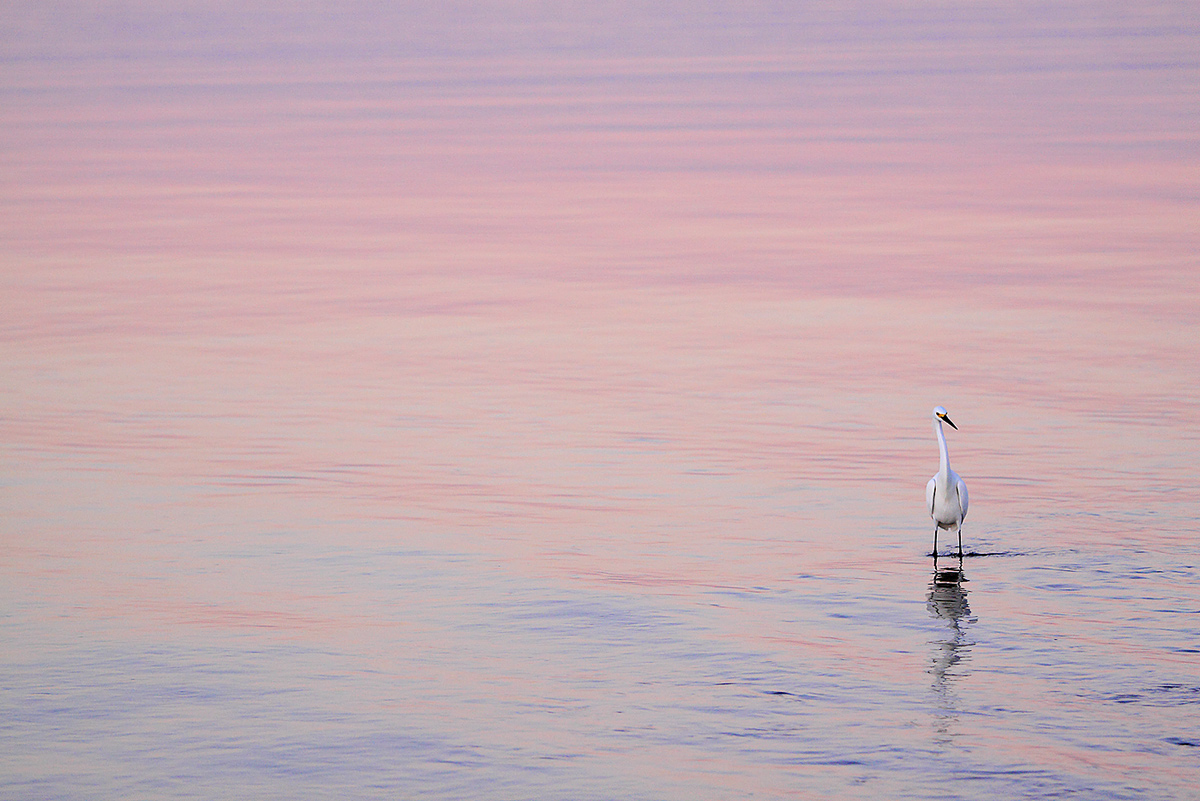
|
|
This Snowy Egret was photographed in pre-dawn light at Little Estero Lagoon with the hand held Canon EF 70-200mm f/2.8L IS II USM lens (at 100mm) and the EOS-50D (now replaced for me by the Canon EOS 5D Mark III Digital camera body ISO 800. Evaluative metering +1 stop as framed: 1/500 sec. at f/5.6 in Av mode.
One-shot AF and re-compose. Talk about the old days–no rear focus…. Be sure to click on the image to enjoy a larger version.
|
Bird Photography Hotspot: Little Estero Lagoon, Fort Myers Beach, FL
The first time that I tried to find Little Estero Lagoon I had no luck at all. I drove to Fort Myers Beach in a ton of traffic and when I arrived all that I saw were hundreds of young kids walking around in bathing suits with a beer in one hand and a frisbee in the other. Those with a free hand were hauling coolers with more brews. I paid way, way too much to park, walked down to the beach, and saw a very few Laughing Gulls and about 10,000 folks getting sunburned.
Well more than two decades later, I know the ropes at Little Estero as well as anyone. Every year folks tell me, “There’s not much at Estero.” I go the next day and fill every flash card that I have. It’s all a matter of knowing where to be when. It is not uncommon to photograph all of the following species in a single day: Great Egret, Snowy Egret, Tricolored Heron, Reddish Egret (both color morphs), Great Blue Heron, Little Blue Heron, Ring-billed Gull, Laughing Gull, Royal Tern, Forster’s Tern, Black-bellied Plover,Ruddy Turnstone, Semipalmated Plover, Wilson’s Plover, Piping Plover, American Oystercatcher, Double-crested Cormorant, Mottled Duck, Brown Pelican, and Osprey. Wood Stork, Sandwich Tern, White Pelican, Black Skimmer, Herring Gull, Lesser Black-backed Gull, Long-billed Curlew, Snowy Plover, Western Sandpiper, Dunlin, Short-billed Dowitcher, Red Knot, Bald Eagle, and Roseate Spoonbill are all possible. And the best news is that nearly all of the birds are silly tame.
Being in the right spot at the right time while photographing a huge feeding spree in gorgeous light is for me the thrill of Little Estero.
Your Favorite?
Which of the two images above do you like best? Be sure to let us know why you made your choice.
Southwest Florida Site Guide
My Southwest Florida Site Guide includes detailed instructions for photographing at the great spots within an hour or two of Fort Myers, Florida. Included are Ding Darling NWR then and now, Blind Pass Beach, the Sanibel Fishing Pier, the East Gulf Beaches–great for Snowy Plover, Little Estero Lagoon, the Sanibel Causeway, Venice Rookery, my secret White Pelican spot–head shots with a 300mm lens plus flight and action, and the two best Burrowing Owl sites on Cape Coral. Learn more or purchase here.

|
|
Join us to learn the ins and outs of Little Estero Lagoon.
|
Little Estero Lagoon IPT: 2 full days–Sat/Sun: JAN 25-26 (Limit 14/Openings 12): $799. Introductory slide program: 7pm, FRI, JAN 24, 2014
Join Denise Ippolito and Arthur Morris for four great photography sessions at one of the top bird photography hotspots in North America. Morning sessions: 6:15am to 10:30am. Afternoon sessions: 3:00pm till 5:45pm. Lunch included. Informal image review and Photoshop sessions after lunch. Call 863-292-0906 to registger; payment if full is now due so call with your credit card in hand. Please e-mail with any questions.
Monday: Jan 27: Optional Estero Add-on/morning only (Limit 14/Openings 12): $249
Adding the last morning as above is an option.
What you will learn:
When to be where and where to be when at Little Estero Lagoon to maximize the photographic opportunities.
Autofocus basics and correct camera and gear set-up.
How to get the right exposure with digital every time.
How and why to expose to the right.
How to create pre-dawn silhouettes.
How to design pleasing images.
How to find the best perspective.
How to make strong images in cluttered situations.
How to photography birds in flight.
In-the-Field creative techniques.
Do consider joining us for the all or part of the South Florida Composite IPT:
2014 South Florida Composite IPT: 6 1/2 days of photography spread over 9 days of learning, hanging out, and travel: $2644. (Limit 14/Openings: 12
Click here for complete details or to register. Please e-mail with any questions or leave a comment below.
Last Year’s Grand Prize winning image by Lou Coetzer
Time is Running Out!
BIRDS AS ART 2nd International Bird Photography Competition
The December 31, 2013 closing deadline is fast approaching.
Learn more and enter the BIRDS AS ART 2nd International Bird Photography Competition here. Twenty-five great prizes including the $1000 Grand Prize and intense competition. Bring your best.
Support the BAA Blog. Support the BAA Bulletins: Shop B&H here!
We want and need to keep providing you with the latest free information, photography and Photoshop lessons, and all manner of related information. Show your appreciation by making your purchases immediately after clicking on any of our B&H or Amazon Affiliate links in this blog post. Remember, B&H ain’t just photography!




Amazon
Everyone buys something from Amazon, be it a big lens or deodorant. Support the blog by starting your search by clicking on the logo-link below. No purchase is too small to be appreciated; they all add up. Why make it a habit? Because I make it a habit of bringing you new images and information on an almost daily basis.
Typos
In all blog posts and Bulletins feel free to e-mail or leave a comment regarding any typos, wrong words, misspellings, omissions, or grammatical errors. Just be right. 🙂
IPT Info
Many of our great trips are filling up. You will learn more about how to make great images on a BAA IPT than anywhere else on the planet. Click here for the schedule and additional info.
December 15th, 2013
Gear Bag Discussion for a Big Trip
Denise Ippolito and I are taking 7 clients on a long-sold-out Japan in Winter IPT leaving the US on February 10th. Paul McKenzie who helped organize the trip–he lives in Hong Kong–is co-leading. There have been lots of questions about what lenses to bring. Below I share a few of the e-mails discussing just that subject. As you read the e-mails, do consider the images presented here and how they relate to the e-mails and to you.
From My First Gear e-Mail to the Group
Hi Gang,
I am in a quandary. The first (and last) time that I went to Japan I brought the 300 f/2.8 L IS II and the 800 for big glass. I did use the 800 a bit for head portraits of the eagles off the tripod–yes, on the boat and a lot for photographing the cranes in flight, often with the 1.4X TC. That said I made a ton of great images with the 300/1.4X TC combo and with the 70-200 II.
I no longer own the 800 having replaced it with the 600 f/4L IS II. And I also own the 200-400 with internal TC…
I am trying to decide whether to bring the 200-400 and perhaps a 300 II–the latter is lighter and much easier to hand hold and leave the 600 II at home…. The 2-4 with both TC gets me to 784mm. But the 600 with the 2X TC gets me to 1200, a huge advantage…. I expect that Paul will often have a shorter rather than a longer lens in his hands than me as he loves doing the wide environmental stuff…. I will be also bringing the 24-105 and leaving the fish eye at home….
So my big decision is whether to bring the 600 II or the 200-400 as my big lens. I am leaning towards the 600 II. If I do that I will almost surely buy a new 300 II and bring that so that I have something lighter for flight. The 2-4 would be great but it is heavier and it is nearly impossible to bring the 600 II, the 2-4, and the 300 II and all the rest. Heck, the 600II and the 300 II is load enough…
An option that I did not mention was to do the whole trip without a big super-telephoto, that is, to go only with the 300f/2.8L IS and both teleconverters…. For those considering bring a 200-400 the edge of course goes to the Canon version with the internal TC.
ps: bring lots of layers as the eagle boat might be brutally cold. I think that we had -5F one morning…. But there is a warm cabin.
pps: some might opt to do an afternoon trip at additional expense or possibly to do only one trip in the morning and one in the afternoon. We need six to get an afternoon boat but we could always recruit some other photographers….

|
|
This breeding plumage Brown Pelican image was created at LaJolla, CA in January 2006 with the predecessor of the Gitzo 3532 LS carbon fiber tripod, the Mongoose M3.6 head, the 600mm f/4L IS lens) now replaced by the Canon EF 600mm f/4L IS II USM lens) and the EOS-1D Mark II (now replaced by the Canon EOS-1D X). ISO 400. Evaluative metering at zero in Av mode. Color temperature: Cloudy.
Central sensor/Rear Focus AF on the bird’s eye and re-compose. Click here to see the latest version of the Rear Focus Tutorial. Click on the image to see a larger version.
Note that as recently as 2011 I was working most often in Av mode rather than Manual mode…
|
Early Morning Thoughts…
Hi Again All, Here I will share the thoughts that I was having as I awoke in a somewhat dream-like state this morning….
I have always been a long lens guy. I see the world in small rectangular frames as if I were always looking through a long telephoto lens. With a teleconverter. I love 3/4 frame images of whole birds and I love tight head portraits with clean backgrounds. Please remember that that is me. That is my style. I believe that Denise is much the same. I know that Paul tends to work much wider than I do using shorter focal length lenses so as to include lots of beautiful habitat. That said, I think that Paul had his the 600 when I last saw him in Japan. I might be wrong though….
If you brought only a 70-200 with TCs or an 80-400 or 100-400 without TCs or one of the Sigma 50-500s you will have countless opportunities to create great images on the Japan in Winter trip. Will you sometimes be wishing that you had a longer focal length? Of course. I often wish the same when standing behind my tripod-mounted 600 II with the 2X III attached. But do understand that intermediate focal length lenses above often have a huge advantage over long glass when it comes to photographing birds in flight and in action. I am often dead in the water with the super-long focal lengths that I otherwise enjoy working with….
So please temper my enthusiasm for long glass by remembering that that is me, that that is my style. Please consider the type of images that you like to make before packing your gear bag.
I’d love to hear from Paul and from Denise on their gear bag recommendations.
Denise Wrote:
Hello everyone. I will be bringing my Canon 5D Mark III, Canon 1D Mark IV, Canon 300mm f/2,8 Version II lens, Canon 100-400mm lens, 1.4 III teleconverter, 2X III teleconverter, 24-105mm lens and my 15mm fisheye (it weighs next-to-nothing). And maybe a 16-35mm and/or a 24mm tiltshift. I have decided to leave the 600mm II at home and rely on the 300mm with teleconverters as my big glass. See you all soon! Denise
To Which I Responded:
Wow! She’s going light. Thanks for chiming in Lady D. The 300 f/2.8L IS lens is killer and I will almost surely be bringing one. a
My Reply to Srdjan Mitrovic’s e-Mail
AM: Hi Srdjan, re:
SM: Art, thanks for the recommendations.
AM: YAW.
SM: I can add a 1.4x TCE to the new 80-400 . It becomes f/8 and but am uncertain about the quality.
AM: Though I have no personal experience with that lens and a TC I generally recommend against such combos as the speed of initial AF acquisition is slowed considerably. The same applies to the Canon 100-400mm.
SM: We have also 1.7x TCE and the 2x TCE that we could use on 200-400.
AM: Again, though I have no personal experience with that lens and a TC, I must say that recently I have been hearing many negative comments about the 1.7x TCE, most recently on the Bosque IPT where several folks stated that they owned the 1.7x TCE but have quit using it because of concerns about sharpness. And the Nikon 2x TCEs have been trashed by everyone I know who uses Nikon. Except for Todd Gustafson who regularly uses both the 1.7x TCE and the 2x TCE with his 600 f/4 Nikkor lens…. Everyone that I know is happy with the image quality from the 200-400 with the 1.4x TCE.
SM: If I understand correctly we should have at least 600mm full frame lens reach, correct?
AM: I am not so sure about that… See my comments above.
SM: D800s are 36 MP full frame bodies.
AM: With that file size using a shorter lens and cropping will produce some superb image files even with a large crop. With the 200-400 and the 1.4X TCE and the new 80-400 for hand held flight photography and your 36mp you should be more than fine….
Please let me know if you have any additional questions.
later and love, artie
ps: for more on Nikon lenses and TCEs see Big Lens Choices for Canon and Nikon–As I See Them….
The Great Group
We really have put together a great group of truly Happy Campers. Alan and Pat Lillich are both great friends and multiple IPT veterans. Both are accomplished photographers and Pat is a talented sculptress as well. I first met Zorica Kovacevic and Srdjan Mitrovic at Tierra del Fuego National Park where we hung out together and got more than a few great images of some Magellanic Woodpeckers. We then spent three great weeks together on a Cheesemans Antarctica/South Georgia/Falklands cruise. The always-smiling Scotsman (one “t” is correct) Malcolm MacKenzie is another mutliple IPT veteran. He lives in Connecticut. Rounding out the crew are newcomers Lex and Debbie Franks who will be traveling from Australia for their first Instructional Photo-Tour. We all look forward to meeting our soon-to-be new friends from Down Under.
Your Favorite?
Which of the three images above do you feel is the strongest? Be sure to let us know why.
|

|
|
Join me in San Diego for three great days of photography and learning. Click on the image to better enjoy a larger version.
|
Announcing the San Diego Short-Notice Small Group IPT. January 15-17, 3-Full Days: $1049. Meet and Greet after dinner on your own at 7:30pm on Tuesday, January 14, 2014. Limit 6.
We will get to photograph the California race of Brown Pelican in flight, resting, preening, cleaning their bill pouches, and talking to their neighbors by tossing their bills high in the air. The afternoon sessions will feature Marbled Godwits, several gull species, and Wood and Ring-necked Ducks. If we have a cloudy morning we will get to photograph Harbor Seals. You will learn to get the right exposure every time, to see the best situation, to think like a pro, to create sharp, pleasing images, and to understand the joint effects of light and wind on the birds. All in a small group with tons of individual attention.
A $500 non-refundable deposit is required to hold your slot for this IPT. Your balance will be due no later than January 7, 2014. The balance is alo non-refundable. If the trip fills, we will be glad to apply a credit applicable to a future IPT for the full amount less a $100 processing fee. If we do not receive your check for the balance on or before the due date we will try to fill your spot from the waiting list. If your spot is filled, you will lose your deposit. If not, you can secure your spot by paying your balance.
If you are planning to register please shoot me an e-mail.
Then please print, complete, and sign the form that is linked to here and shoot it to us along with your deposit check (made out to “Arthur Morris.”) Though we prefer a check, you can also leave your deposit with a credit card by calling the office at 863-692-0906. If you register by phone, please print, complete and sign the form as noted above and either mail it to us or e-mail the scan.
If you have any questions, please feel free to contact me via e-mail
San Diego Site Guide
Can’t make the IPT? Get yourself a copy of the San Diego Site Guide; it’s the next best thing to being on an IPT. Nearly 30 years of San Diego bird photography revealed in one fell swoop.
Great buy: Used Canon 800mm f/5/6L IS Lens for Sale
Friend and multiple IPT-veteran Monte Brown is offering his lightly used Canon 800mm f/5.6L IS lens in excellent condition for sale for $9,500. Purchase includes the lens case and hood, the 4th Generation Design Low Foot, the original foot, a LensCoat, the original invoice and the original Canon shipping carton. The lens was purchased new from B&H in April 2009 and was recently underwent a pre-sale clean and check by Canon. The buyer pays insured shipping via UPS Ground to US addresses only. The lens will be shipped only after your check clears.
The Canon EF 800mm f/5.6L IS USM Autofocus lens sells new for $13,223.00 so you will save a bundle on a great lens. No need to ever use a 2X…
If interested you can contact Monte by phone at 1-765-744-1421 or via e-mail.
Last Year’s Grand Prize winning image by Lou Coetzer
Time is Running Out!
BIRDS AS ART 2nd International Bird Photography Competition
The December 31, 2013 closing deadline is fast approaching.
Learn more and enter the BIRDS AS ART 2nd International Bird Photography Competition here. Twenty-five great prizes including the $1000 Grand Prize and intense competition. Bring your best.
Support the BAA Blog. Support the BAA Bulletins: Shop B&H here!
We want and need to keep providing you with the latest free information, photography and Photoshop lessons, and all manner of related information. Show your appreciation by making your purchases immediately after clicking on any of our B&H or Amazon Affiliate links in this blog post. Remember, B&H ain’t just photography!




Amazon
Everyone buys something from Amazon, be it a big lens or deodorant. Support the blog by starting your search by clicking on the logo-link below. No purchase is too small to be appreciated; they all add up. Why make it a habit? Because I make it a habit of bringing you new images and information on an almost daily basis.
Typos
In all blog posts and Bulletins feel free to e-mail or leave a comment regarding any typos, wrong words, misspellings, omissions, or grammatical errors. Just be right. 🙂
IPT Info
Many of our great trips are filling up. You will learn more about how to make great images on a BAA IPT than anywhere else on the planet. Click here to learn about the just-announced 2014 Bosque IPTs. And click here for the schedule and additional info.
December 14th, 2013
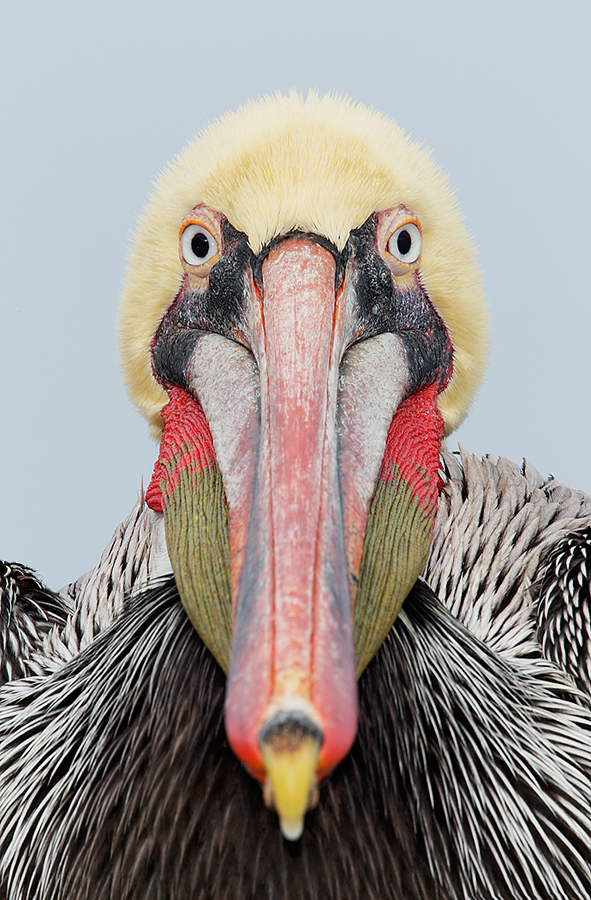
|
|
This Brown Pelican image was was created at LaJolla, CA with the Gitzo 3532 LS carbon fiber tripod, the Mongoose M3.6 head, the Canon EF 800mm f/5.6L IS USM Autofocus lens, the Canon 1.4x EF Extender III (Teleconverter), and the EOS-1D Mark IV now replaced by the Canon EOS-1D X. ISO 500. Evaluative metering +1 stop: 1/30 sec. at f/20 in Av mode.
Central sensor/Rear Focus AF on the base of the bill less than one half inch in front of the eyes and re-compose. Click here to see the latest version of the Rear Focus Tutorial. Click on the image to see a larger version.
The great 4-stop IS system of the 800 allowed me to make a sharp image at 1/30 at 1120mm with an effective magnification of slightly more than 29X! There is a great used 800 for sale below. Though I love my 600II there are times when I miss the 800….
|
Long Lens Depth-of Field Lessons from LaJolla, CA
Lesson I: Depth-of-Field with Long Lenses at Close Range is Miniscule
It is a popular misconception that depth-of-field is always 33.3% in front of point of focus and 66% behind the point of focus. That is true with short lenses like the 24-105 and is an important principle for landscape photographers. But with telephoto lenses depth-of-field is pretty much right on the button at 50/50. That is whatever depth-of-field you have will be spread out equally with 50% in front of point of focus and 50% behind. Not buying that? Want to learn a lot more about d-o-f? As I have suggested before you can learn a ton by visiting DOFMaster by clicking here.
A quick visit with regards to the image above show that the d-o-f is indeed 50/50 with .36 inches in front of and .36 inches beyond the point of focus being in relatively sharp focus. That means that the total d-o-f is less than three-quarters of a single inch. That at f/20! As I have been writing, teaching, and preaching, depth-of-field with long lenses when you are working near the lens’s minimum focusing distance is normally measured in fractions of a single inch. For the image above had I been working wide open at f/8 the total d-o-f field would have been slightly more than one-third of one inch…
Lesson II: Long Lens D-o-F Strategy
To maximize d-o-f, consider the 50-50 principle. For the image above I knew from experience that d-o-f would only be about an inch or less even at f/20 so I focused on the base of the bill less than a half-inch in front of the plane of the eyes. Doing that allowed me render the base of the bill and the eyes to be in relatively sharp focus. Though the d-o-f was so shallow, I was at least able to use it fairly effectively by knowing exactly where to focus.
If you have any d-o-f questions, please leave a comment and ask away.
|

|
|
Join me in San Diego for three great days of photography and learning. Click on the image to better enjoy a larger version.
|
Pelican Paradise
LaJolla, California is a pelican paradise. At the right time of year, most will be sporting their incredibly beautiful breeding plumage of white and yellow and deep chocolate brown. But it is the olive green and bright red bill pouches that grabs you by the throat and never lets go. One of my LaJolla film images was honored in the BBC Wildlife Photographer of the Year Competitions. Today, I still don’t have enough pelican images. I’d love to make another BBC-worthy photograph on my upcoming trip. I hope that you can join me in the quest. See below for details.
I’ve been away from LaJolla for too long. I visited San Diego for photography (and until 2007, to visit my folks who lived in North
park; my war hero Dad died in 2001) every year for almost three decades. My Mom, now 91 and living in Holbrook, Long Island, NY, lived in San Diego until seven years ago. Whenever I walked into my parent’s home on Pentuckett Avenue the same conversation would take place:
Hazel Louise Morris: What are you gonna do tomorrow?
Arthur Edward Morris: Ma, you know what I am gonna do tomorrow.
HLM: What are you gonna do tomorrow?
AEM: Ma, I’m going to LaJolla bright and early.
HLM: What are you gonna do there?
AEM: Ma, you know what I am gonna do.
HLM: What are you gonna do there?
AEM: Ma, I’m going to photograph those beautiful pelicans.
HLM: Don’t you have enough pelican pictures already?
AEM: No Ma.
Announcing the San Diego Short-Notice Small Group IPT. January 15-17, 3-Full Days: $1049. Meet and Greet after dinner on your own at 7:30pm on Tuesday, January 14, 2014. Limit 6/Openings: 1.
We will get to photograph the California race of Brown Pelican in flight, resting, preening, cleaning their bill pouches, and talking to their neighbors by tossing their bills high in the air. The afternoon sessions will feature Marbled Godwits, several gull species, and Wood and Ring-necked Ducks. If we have a cloudy morning we will get to photograph Harbor Seals. You will learn to get the right exposure every time, to see the best situation, to think like a pro, to create sharp, pleasing images, and to understand the joint effects of light and wind on the birds. All in a small group with tons of individual attention.
A $500 non-refundable deposit is required to hold your slot for this IPT. Your balance will be due no later than January 7, 2014. The balance is alo non-refundable. If the trip fills, we will be glad to apply a credit applicable to a future IPT for the full amount less a $100 processing fee. If we do not receive your check for the balance on or before the due date we will try to fill your spot from the waiting list. If your spot is filled, you will lose your deposit. If not, you can secure your spot by paying your balance.
If you are planning to register please shoot me an e-mail.
Then please print, complete, and sign the form that is linked to here and shoot it to us along with your deposit check (made out to “Arthur Morris.”) Though we prefer a check, you can also leave your deposit with a credit card by calling the office at 863-692-0906. If you register by phone, please print, complete and sign the form as noted above and either mail it to us or e-mail the scan.
If you have any questions, please feel free to contact me via e-mail
San Diego Site Guide
Can’t make the IPT? Get yourself a copy of the San Diego Site Guide; it’s the next best thing to being on an IPT. Nearly 30 years of San Diego bird photography revealed in one fell swoop.
Great buy: Used Canon 800mm f/5/6L IS Lens for Sale
Friend and multiple IPT-veteran Monte Brown is offering his lightly used Canon 800mm f/5.6L IS lens in excellent condition for sale for $9,500. Purchase includes the lens case and hood, the 4th Generation Design Low Foot, the original foot, a LensCoat, the original invoice and the original Canon shipping carton. The lens was purchased new from B&H in April 2009 and was recently underwent a pre-sale clean and check by Canon. The buyer pays insured shipping via UPS Ground to US addresses only. The lens will be shipped only after your check clears.
The Canon EF 800mm f/5.6L IS USM Autofocus lens sells new for $13,223.00 so you will save a bundle on a great lens. No need to ever use a 2X…
If interested you can contact Monte by phone at 1-765-744-1421 or via e-mail.
Last Year’s Grand Prize winning image by Lou Coetzer
Time is Running Out!
BIRDS AS ART 2nd International Bird Photography Competition
The December 31, 2013 closing deadline is fast approaching.
Learn more and enter the BIRDS AS ART 2nd International Bird Photography Competition here. Twenty-five great prizes including the $1000 Grand Prize and intense competition. Bring your best.
Support the BAA Blog. Support the BAA Bulletins: Shop B&H here!
We want and need to keep providing you with the latest free information, photography and Photoshop lessons, and all manner of related information. Show your appreciation by making your purchases immediately after clicking on any of our B&H or Amazon Affiliate links in this blog post. Remember, B&H ain’t just photography!




Amazon
Everyone buys something from Amazon, be it a big lens or deodorant. Support the blog by starting your search by clicking on the logo-link below. No purchase is too small to be appreciated; they all add up. Why make it a habit? Because I make it a habit of bringing you new images and information on an almost daily basis.
Typos
In all blog posts and Bulletins feel free to e-mail or leave a comment regarding any typos, wrong words, misspellings, omissions, or grammatical errors. Just be right. 🙂
IPT Info
Many of our great trips are filling up. You will learn more about how to make great images on a BAA IPT than anywhere else on the planet. Click here to learn about the just-announced 2014 Bosque IPTs. And click here for the schedule and additional info.
December 13th, 2013
Mornings and Afternoons at Bosque
In general, mornings are usually more productive at Bosque (except for the last half hour of light at the crane pools on the right afternoons). And on cloudy days, mornings are almost always far more productive than afternoons.
|
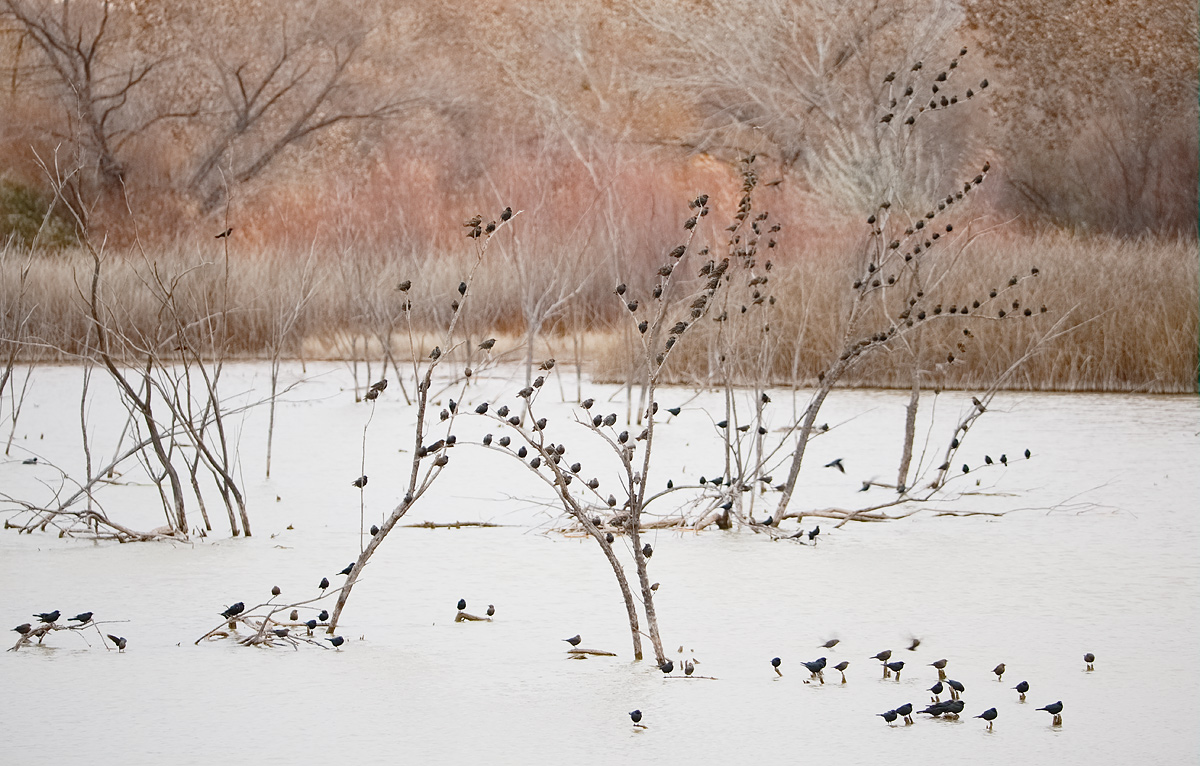
|
|
This image was created with the the Canon EF 200-400mm f/4L IS USM lens with Internal 1.4x Extender (with the internal TC in place hand held at 280mm) and the Canon EOS-1D X. ISO 1600. Evaluative metering +1 2/3 stops as framed in Av Mode: 1/30 sec. at f/5.6. Color temperature 7500 (should have been 10,000 as the RAW file was BLUE).
Central sensor/AI Servo/Surround–Rear Focus AF on the tree in the middle and recompose. Click here to see the latest version of the Rear Focus Tutorial. Click on the image to see a larger version.
|
Follow Your Nose…
On the rare cloudy, dreary afternoon the best strategy is to go past the pay booth and flip a coin. Heads, make a right turn and check out the Marsh Loop. Tails go straight up Bosque Road (In the Bosque Site Guide I call it the H Road for obvious reasons). On November 23, the coin came up tails. I was glad as there had been some good concentrations of ducks about 2/3 of the way to the left turn on the Farm Loop. Most of us were messing around with the dispersing ducks, not doing much. A few folks walk a hundred yards up the road to the pool on the right near the intersection. Close to a decade ago this was a good location with lots of ducks and the occasional Neotropic Cormorant. Lately it had been not so good. I forget which member of Denise’s group came back to get us, heck, it might have been Denise, but IAC we were told that there were big groups of blackbirds perching on the dead bushes in the pool and flying around. So we went. The image above was one of the first that I made.
|
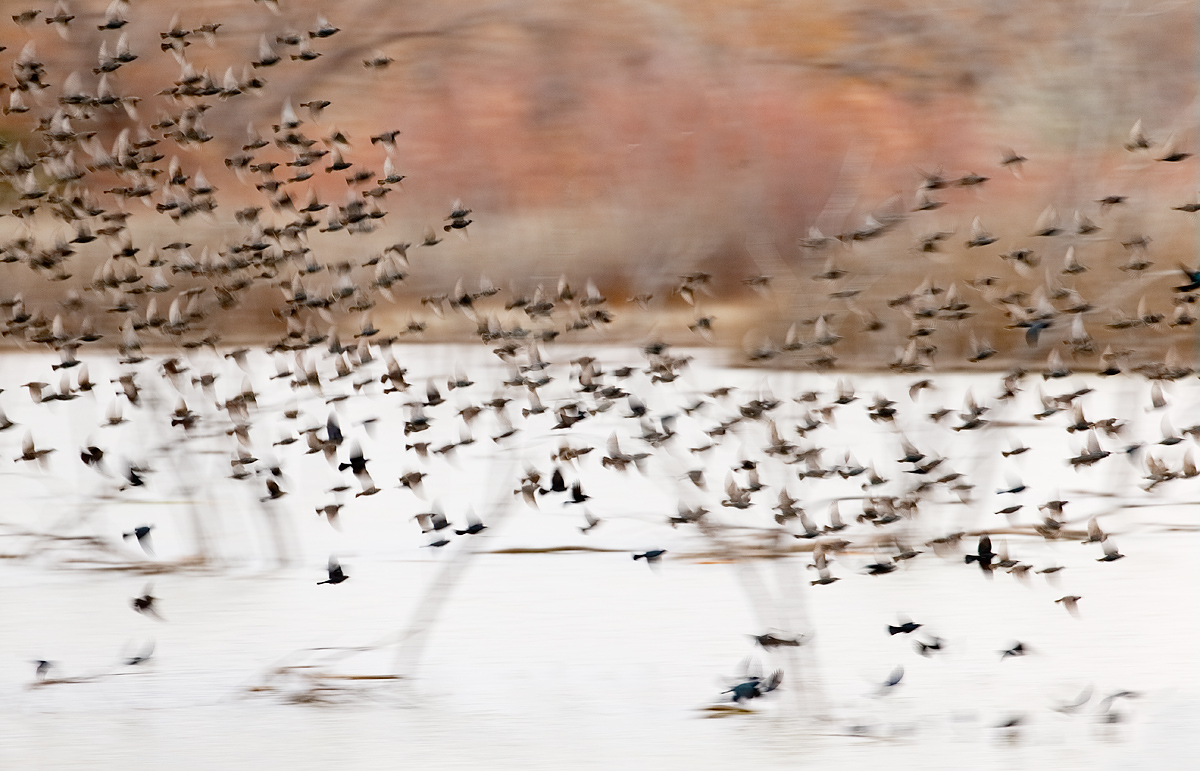
|
|
This image was also created with the Canon EF 200-400mm f/4L IS USM lens with Internal 1.4x Extender (with the internal TC in place hand held at 280mm) and the Canon EOS-1D X. ISO 1600. Evaluative metering +1 2/3 stops as framed in Av Mode: 1/30 sec. at f/5.6. Color temperature 7500 (should have been 10,000).
Central sensor/AI Servo/Surround–Rear Focus AF on the tree in the middle and recompose. Click here to see the latest version of the Rear Focus Tutorial. Click on the image to see a larger version.
|
And Then the Birds Took Off
And then the birds took off so I pushed the button while panning with the flock.
A Guide to Pleasing Blurs
Pleasing blurs are not out-of-focus mistakes. They are well thought out, skillfully executed, accurately focused creations. If you would like to learn to create such images, get yourself a copy of “A Guide to Pleasing Blurs” by Denise Ipplito and yours truly.
|
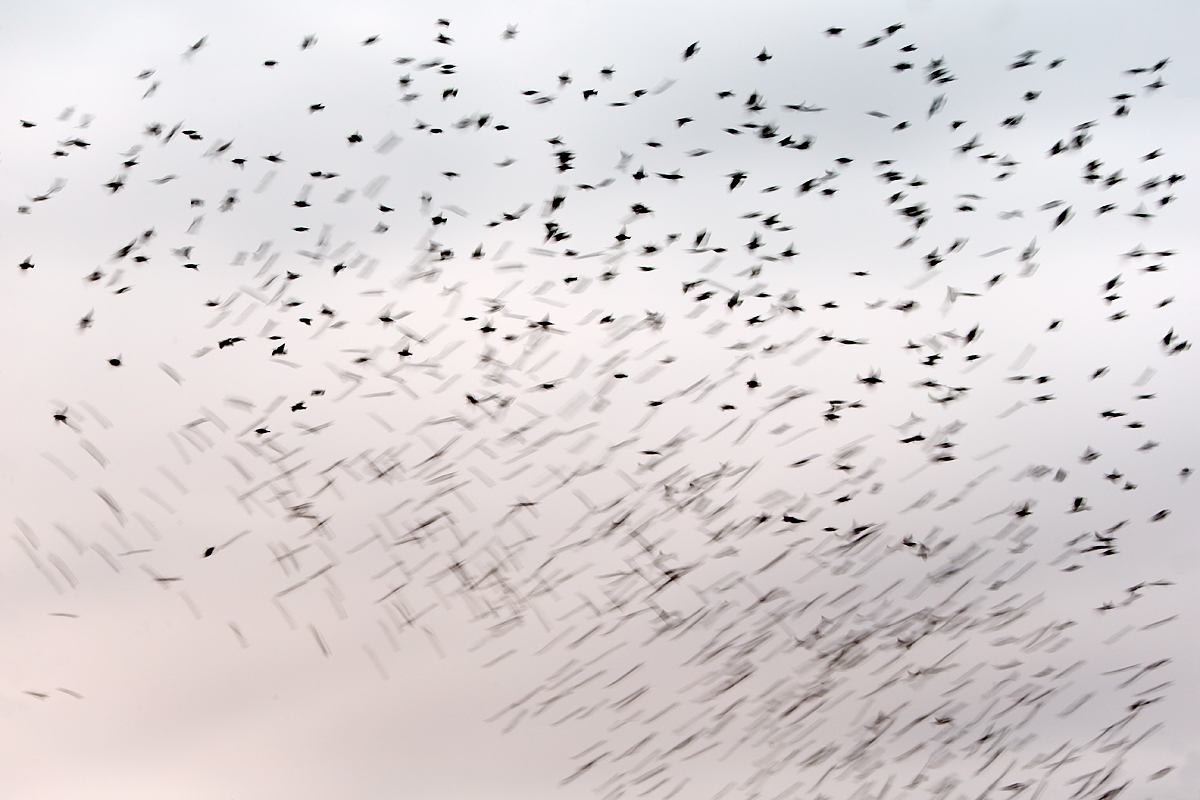
|
|
This image was also created with the Canon EF 200-400mm f/4L IS USM lens with Internal 1.4x Extender (hand held at 371mm) and the Canon EOS-1D X. ISO 320. Evaluative metering +1 1/3 stops as framed in Av Mode: 1/10 sec. at f/9. Color temperature 7500.
One sensor below the central sensor/AI Servo/Surround–Rear Focus AF as framed active at the moment of exposure. Click here to see the latest version of the Rear Focus Tutorial. Click on the image to see a larger version.
|
Follow Your Nose Part II…
After the mass of birds took off they flew north and west so I said to the group, “Let’s go!” We walked west along the H Road past the spot where we had started so that we had a clear view of the Main Impoundment to the north. The flock swirled and turned and veered. I framed and fired off about 60 images over a ten minute period until the action quit and we headed back to Socorro for dinner.
In the image above I love that the flock had split in two with each segment flying in a different direction.
Image Questions
In the second image, why was it a mistake to have the internal TC in place?
In the second image, considering that I was hand holding, what factors helped me to create a relatively sharp image at only 1/30 sec.?
Which of the images above is your favorite? Why? I have two clear favorites and will share them with you at some point.
|
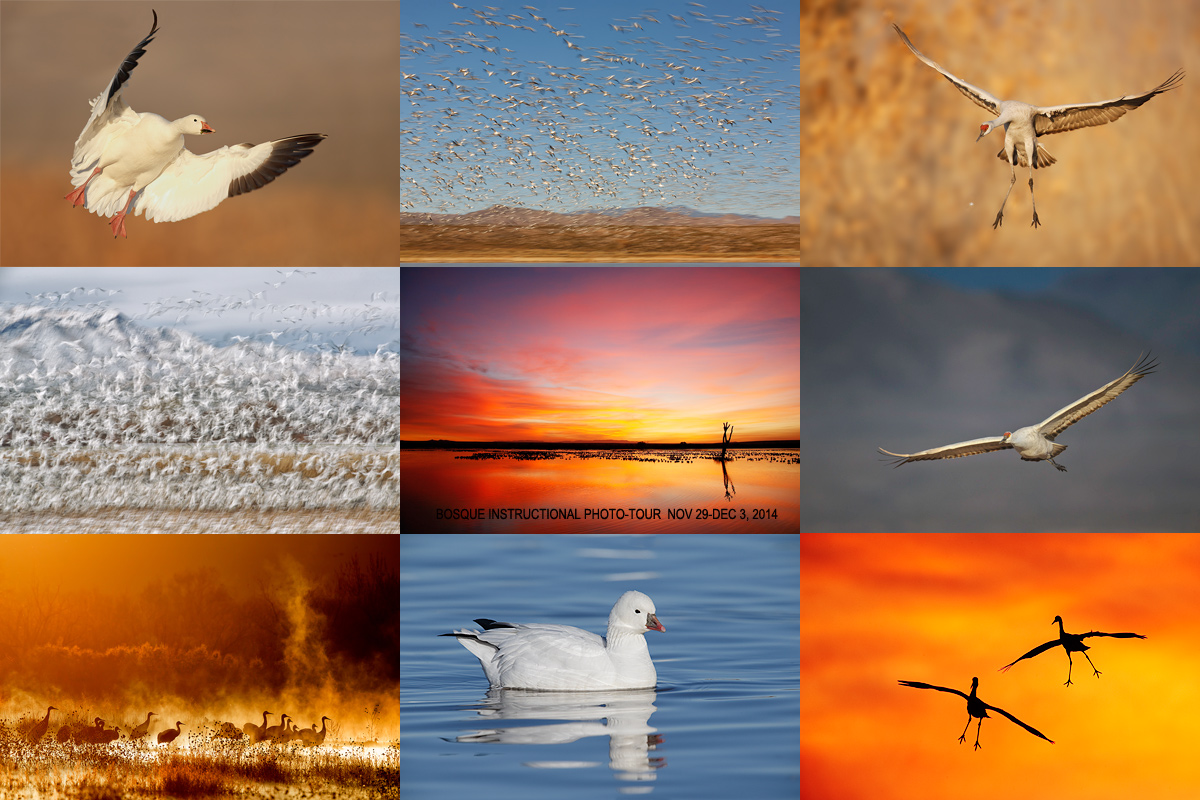
|
|
Join Denise Ippolito and me for four great days of photography and learning at one of our soul places. Please click on the card to enjoy a larger version.
|
Bosque del Apache 2014 BIRDS AS ART/A Creative Adventure Instructional Photo-Tour (IPT). NOV 29-DEC 3, 2014. Totaling 4 FULL-DAYS: $1449. Leaders: Arthur Morris and Denise Ippolito. Introductory Slide program: 7:00pm on Sunday 11/29.
|
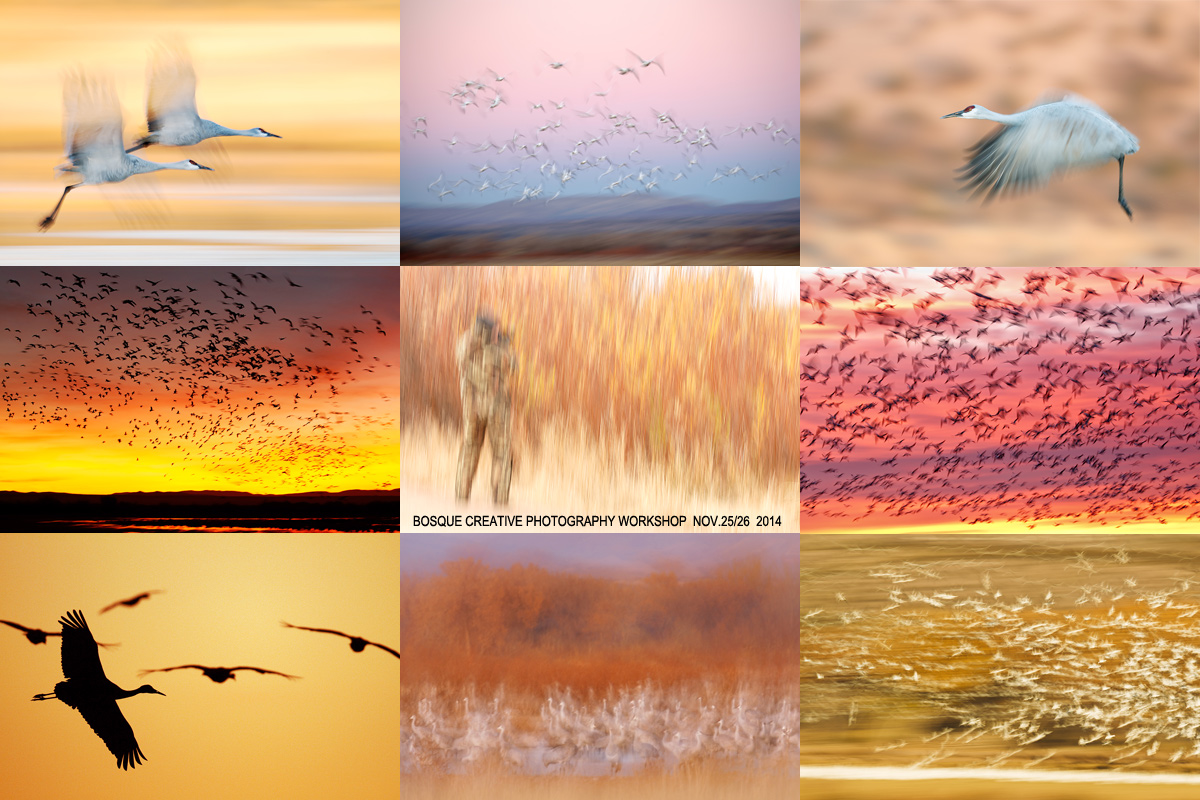
|
|
Join Denise Ippolito and me for two great days of photography, fun, and learning at one of our soul places. We will surely be taking you out of the box on this workshop. Please click on the card to enjoy a larger version.
|
Bosque del Apache 2014 A Creative Adventure/BIRDS AS ART “Creative Photography Instructional Photo-Tour.” (IPT). NOV 24-25, 2014. 2-FULL DAYS: $729. Leaders: Denise Ippolito & Arthur Morris. Introductory Slide program: 7:00pm on Sunday 11/23.
Denise and I hope that you can join us. Click here for complete details.
Delkin Devices
As regular readers know, I keep a Delkin 64gb e-Film Pro 700X flash card in all three of my cameras. I use and depend on them 300 days a year. (Yeah, I know: life is tough. 🙂 You can learn about all the Delkin products that we carry by clicking here. For those of you who prefer SD cards–they are too small for me, we would be glad to have your order drop-shipped for you. Please Jim and let him know what you need.
Delkin has been a long time BAA sponsor. They have been generous supporters of the BAA International Bird Photography Competitions since the get-go. In addition to flash cards and a line of great card readers, Delkin carries an interesting line of products. Click on some of the links below and you just might be able to take care of some of your holiday gift shopping in short order and save some bucks while you are at it.
GoPro Gift Guide + $30 Instant Savings Inside
|
Give a Little Cheer to the GoPro Fan in Your Life.
|
|
Instant savings on the Fat Gecko Kaboom is valid 12/13/13 through 12/31/13 at 11:59 PM PST while supplies last. Limited quantities available. Bargain Basement orders must be placed through delkinbargains.com and cannot be combined with regular Delkin.com orders. Questions? Contact us toll free during normal business hours at (800) 637-8087.
|
|
|
|
|
|
|
|
|
|
|
December 12th, 2013
|

|
|
Join Denise Ippolito and me for four great days of photography and learning at one of our soul places. Please click on the card to enjoy a larger version.
|
Bosque del Apache 2014 BIRDS AS ART/A Creative Adventure Instructional Photo-Tour (IPT). NOV 29-DEC 3, 2014. Totaling 4 FULL-DAYS: $1449. Leaders: Arthur Morris and Denise Ippolito. Introductory Slide program: 7:00pm on Sunday 11/29.
Tens of thousand of Snow Geese, 10,000 Sandhill Cranes, ducks, amazing sunrises, sunsets, and blast-offs. Live, eat, and breathe photography with two of the world’s premier photographic educators at one of their very favorite photography locations on the planet. Top-notch in-the-field and Photoshop instruction. This will make 21 consecutive Novembers at Bosque for artie. This will be denise’s 6th workshop at the refuge. Nobody knows the place better than artie does. Join us to learn to think like a pro, to recognize situations and to anticipate them based on the weather, especially the sky conditions, the light, and the wind direction. Every time we make a move we will let you know why. When you head home being able to apply what you’ve learned on your home turf will prove to be invaluable.
This workshop includes 4 afternoon (11/29 through 12/2), 4 morning (11/30 to 12/3) photography sessions, an inspirational introductory slide program after dinner on your own on Saturday, 11/29, all lunches, and after-lunch digital workflow, Photoshop, and image critiquing sessions.
There is never a strict itinerary on a Bosque IPT as each day is tailored to the local conditions at the time and to the weather. We are totally flexible in order to maximize both the photographic and learning opportunities. We are up early each day leaving the hotel by 5:30 am to be in position for sunrise. We usually photograph until about 10:30am. Then it is back to Socorro for lunch and then a classroom session with the group most days. We head back to the refuge at about 3:30pm each day and photograph until sunset. We will be photographing lots of Snow Geese and lots of Sandhill Cranes with the emphasis on expanding both your technical skills and your creativity.
A $449 non-refundable deposit is required to hold your slot for this IPT. Your balance, payable only by check, will be due on 7/25/2014. If the trip fills, we will be glad to apply a credit applicable to a future IPT for the full amount less a $100 processing fee. If we do not receive your check for the balance on or before the due date we will try to fill your spot from the waiting list. If your spot is filled, you will lose your deposit. If not, you can secure your spot by paying your balance.
Please print, complete, and sign the form that is linked to here and shoot it to us along with your deposit check (made out to “Arthur Morris.”) You can also leave your deposit with a credit card by calling the office at 863-692-0906. If you register by phone, please print, complete and sign the form as noted above and either mail it to us or e-mail the scan. If you have any questions, please feel free to contact me via e-mail.
|

|
|
Join Denise Ippolito and me for two great days of photography, fun, and learning at one of our soul places. We will surely be taking you out of the box on this workshop. Please click on the card to enjoy a larger version.
|
Bosque del Apache 2014 A Creative Adventure/BIRDS AS ART “Creative Photography Instructional Photo-Tour.” (IPT). NOV 24-25, 2014. 2-FULL DAYS: $729. Leaders: Denise Ippolito & Arthur Morris. Introductory Slide program: 7:00pm on Sunday 11/23.
Get Out of Your Box!
The Creative Bosque IPT is perfect for folks who want to learn to think outside the box, to create new and different images. This workshop is the perfect add-on for folks who are planning on attending the Festival of the Cranes. Learn to unleash your creative juices at the wondrous Bosque del Apache National Wildlife Refuge in San Antonio, New Mexico with two great leaders including the amazingly talented and creative Denise Ippolito. In-the-field instruction will include tips on gear set-up, on creating a variety of pleasing blurs, on getting the right exposure, and on designing pleasing images. And lots more. From vertical pan blurs to subject motion blurs to zoom blurs to multiple exposures we will cover it all. If conditions are perfect, we will not hesitate to take advantage of them to do some traditional bird photography. This workshop will include an inspirational introductory slide program on Sunday evening, 11/23, after dinner on your own, two morning and two afternoon photography sessions, all lunches, a digital workflow and Photoshop session after lunch on Monday, and an image critiquing session after lunch on Tuesday.
A $329 non-refundable deposit is required to hold your slot for this IPT. Your balance, payable only by check, will be due on 7/25/2014. If the trip fills, we will be glad to apply a credit applicable to a future IPT for the full amount less a $100 processing fee. If we do not receive your check for the balance on or before the due date we will try to fill your spot from the waiting list. If your spot is filled, you will lose your deposit. If not, you can secure your spot by paying your balance.
Please print, complete, and sign the form that is linked to here and shoot it to us along with your deposit check (made out to “Arthur Morris.”) You can also leave your deposit with a credit card by calling the office at 863-692-0906. If you register by phone, please print, complete and sign the form as noted above and either mail it to us or e-mail the scan. If you have any questions, please feel free to contact me via e-mail.
Bosque 2013 Kudos
From Brent Schoenfeld who attended with his friend Claudia, via e-mail:
You and Denise are an amazing team and it was a treasured experience to learn from and photograph with you both. You have gifted me a new ‘exposure’ discipline, which has catapulted me up to the level I’ve wanted to be at. I had seen the value before, largely from following your blog, and had started to embrace it, but with the workshop I find myself solidly and confidently established in a new and photographically more powerful place. Thank you for your blog, as well. It is a great learning tool. I hope to do more workshops with you two! Thanks for everything. Ciao for now, B.
From Gretchen Cole in an e-mail to the group:
Hello All, I finally have images ready to share. I am still thinking of the trip to Bosque and am so glad I could get signed on late and meet all of you. What a fun, energetic, and talented group. This was my very first trip to Bosque, and I know I will be back. It has grabbed me and I am already formulating a plan to return. This also was my very first bird photography experience and it was fantastic to have such good leaders willing to help and share their knowledge. Enjoy the holidays and I hope we meet again. Thanks again to Denise and Artie for sharing your knowledge without restraint 🙂 Gretchen
From Dave Klein via e-mail:
I wanted you to know that both you and Denise are icons in my photographic journey. What I liked about the workshop was the blending of styles you two represent: technical, compositional and creative. Your vast experience with Bosque told us when to be patient with a situation and let the photographic opportunity present itself and when to quickly move on to another when the circumstances weren’t in our favor. Thanks so much Artie for your dedication to your workshop participants and your readership. I feel privileged to say that I am both. Kind regards, Dave
From Sue Eberhart’s e-mail to the group:
Happy Day After Thanksgiving to all, The experience at Bosque, for me, was a once-in-a-lifetime journey. Before leaving home, I knew that it would be special trip but upon arrival and experiencing just a few minutes with all of you, I knew I was into something extraoidinary. The group’s passion and talent was infectious. As we know, the setting was so very special and the birds outdid themselves.
I am always looking for inspiration and I found all of you inspiring in many ways. Denise and Artie were always patient and willing to share their knowledge, techniques and skills. What more could one ask for? Snow? Yep, even that was arranged for and delivered. Attached are 5 of my best images. I can hardly wait to get home and begin to practice with our shorebirds but nothing will replicate the Bosque experience with all of you. Happy Holidays to you all and I hope we will meet again someday. Sue
From Carl Meisel via e-mail:
Thanks so much for allowing us to experience a once in a lifetime event. I had a great learning experience and am going home with myriads of keepers. I think we lucked out with the days we chose as we saw numerous blastoffs and beautiful sunsets. Thanks again. Carl–from the old Brooklyn neighborhood
Questions
Which card do you like best, the straight photography card (upper) or the creative card (lower)? Which is your very favorite image? Be sure to let us know why.
Light on the Earth
The original Fire-in-the-Mist image was featured as wrap-around cover art on the inspirational Light on the Earth, a large coffee table book that featured 30 years of the best images from the BBC Wildlife Photographer of the Year Competition.
Great buy: Used Canon 800mm f/5/6L IS Lens for Sale
Friend and multiple IPT-veteran Monte Brown is offering his lightly used Canon 800mm f/5.6L IS lens in excellent condition for sale for $9,500. Purchase includes the lens case and hood, the 4th Generation Design Low Foot, the original foot, a LensCoat, the original invoice and the original Canon shipping carton. The lens was purchased new from B&H in April 2009 and was recently underwent a pre-sale clean and check by Canon. The buyer pays insured shipping via UPS Ground to US addresses only. The lens will be shipped only after your check clears.
The Canon EF 800mm f/5.6L IS USM Autofocus lens sells new for $13,223.00 so you will save a bundle on a great lens. No need to ever use a 2X…
If interested you can contact Monte by phone at 1-765-744-1421 or via e-mail.
Help Stop the Shooting of Snowy Owls at NY Area Airports
You might help stop the mindless shooting of Snowy Owls at Kennedy and other NY area airports by signing the petition here.
Last Year’s Grand Prize winning image by Lou Coetzer
Time is Running Out!
BIRDS AS ART 2nd International Bird Photography Competition
The December 31, 2013 closing deadline is fast approaching.
Learn more and enter the BIRDS AS ART 2nd International Bird Photography Competition here. Twenty-five great prizes including the $1000 Grand Prize and intense competition. Bring your best.
Support the BAA Blog. Support the BAA Bulletins: Shop B&H here!
We want and need to keep providing you with the latest free information, photography and Photoshop lessons, and all manner of related information. Show your appreciation by making your purchases immediately after clicking on any of our B&H or Amazon Affiliate links in this blog post. Remember, B&H ain’t just photography!




Amazon
Everyone buys something from Amazon, be it a big lens or deodorant. Support the blog by starting your search by clicking on the logo-link below. No purchase is too small to be appreciated; they all add up. Why make it a habit? Because I make it a habit of bringing you new images and information on an almost daily basis.
Typos
In all blog posts and Bulletins feel free to e-mail or leave a comment regarding any typos, wrong words, misspellings, omissions, or grammatical errors. Just be right. 🙂
IPT Info
Many of our great trips are filling up. You will learn more about how to make great images on a BAA IPT than anywhere else on the planet. Click here for the schedule and additional info.
|
|







